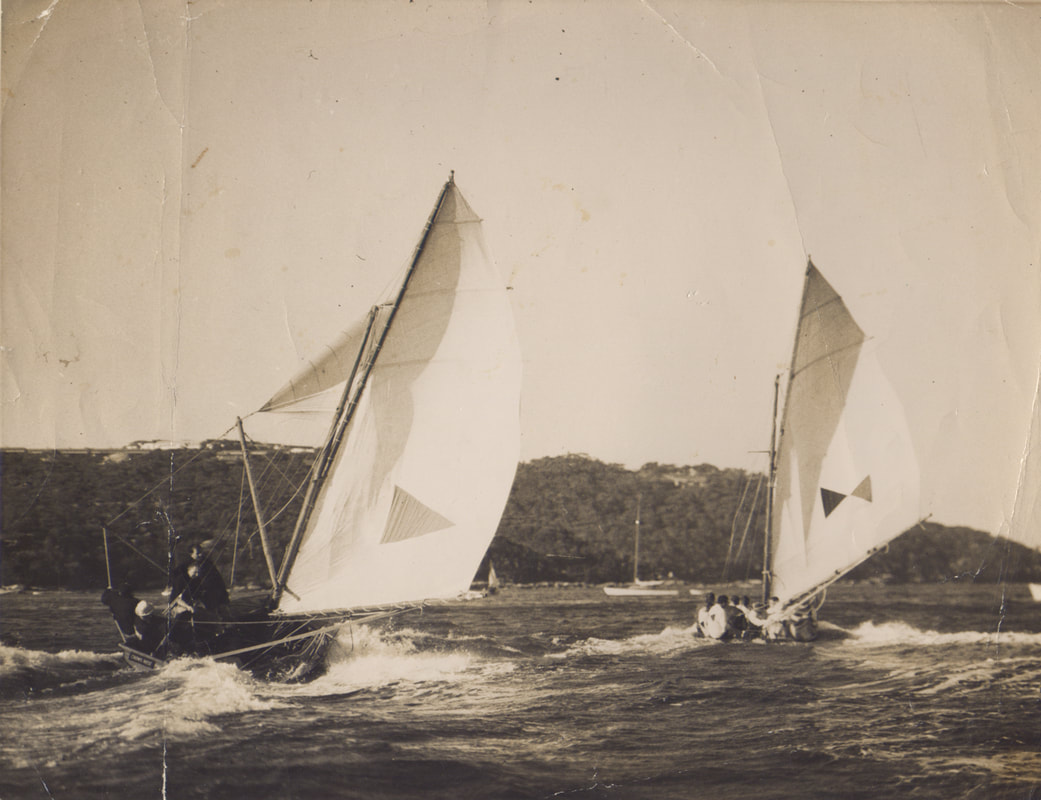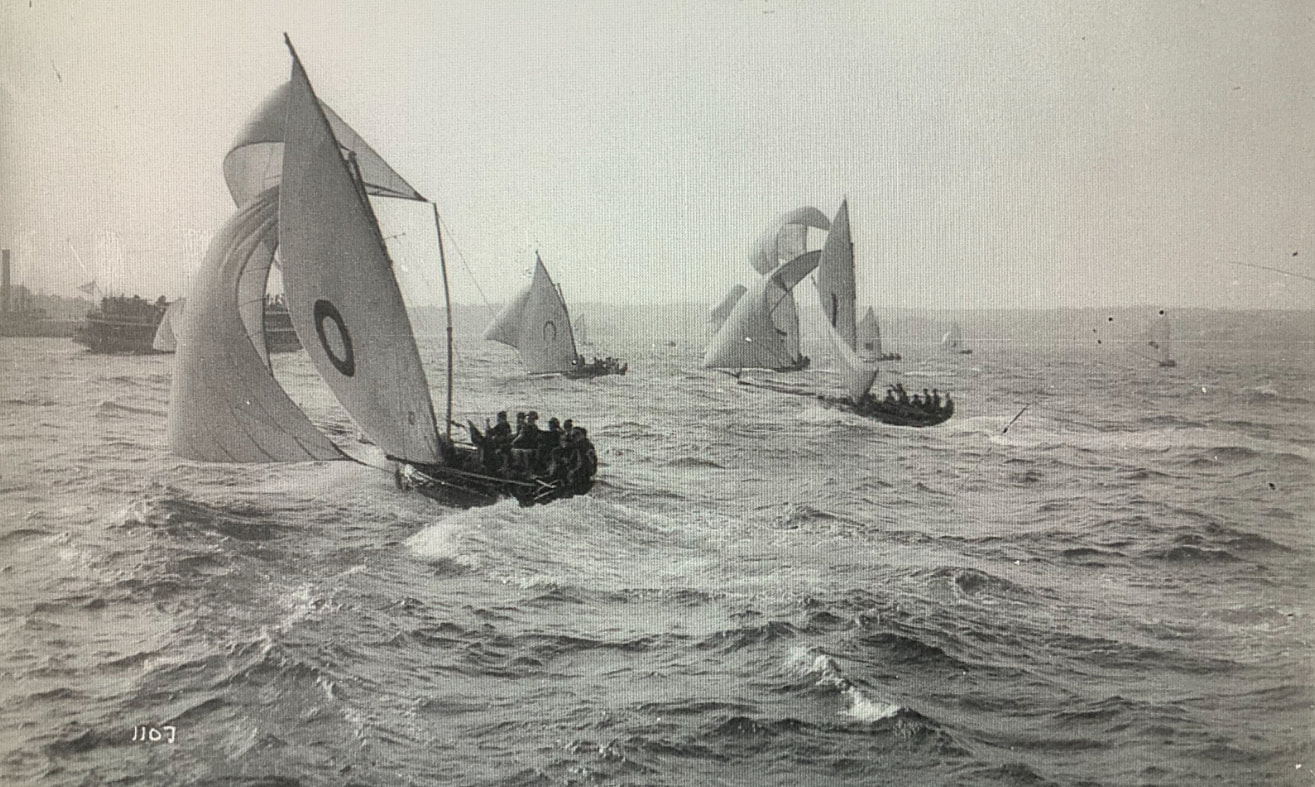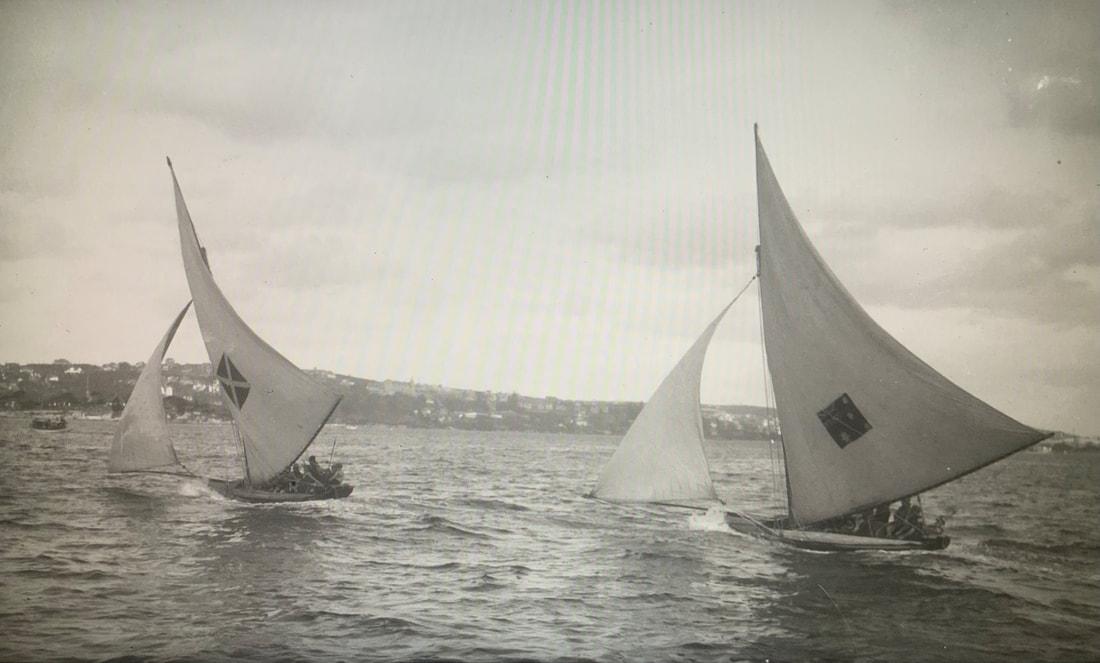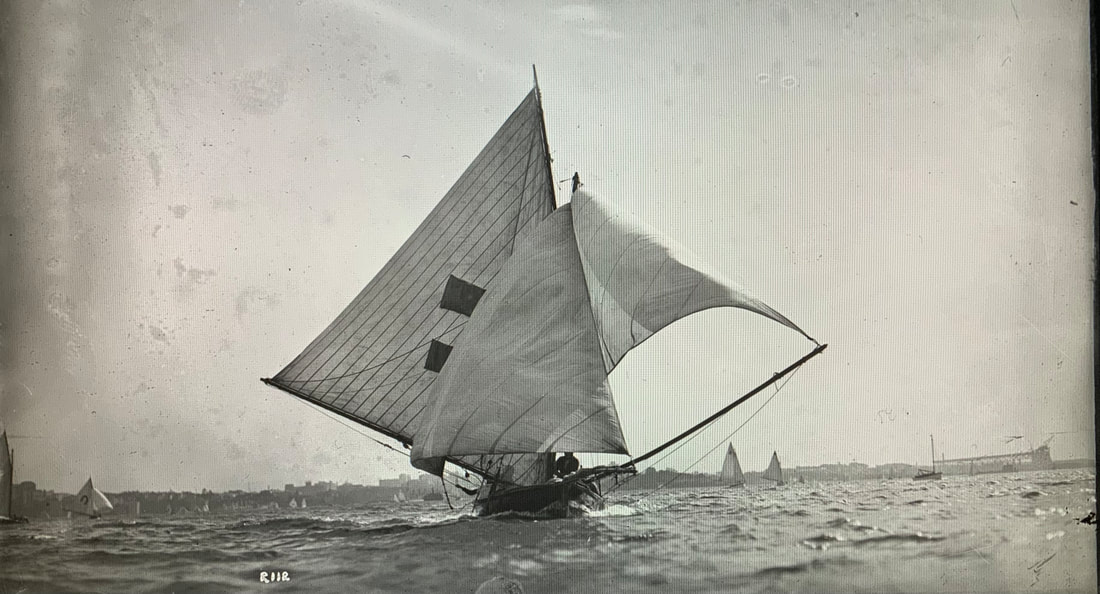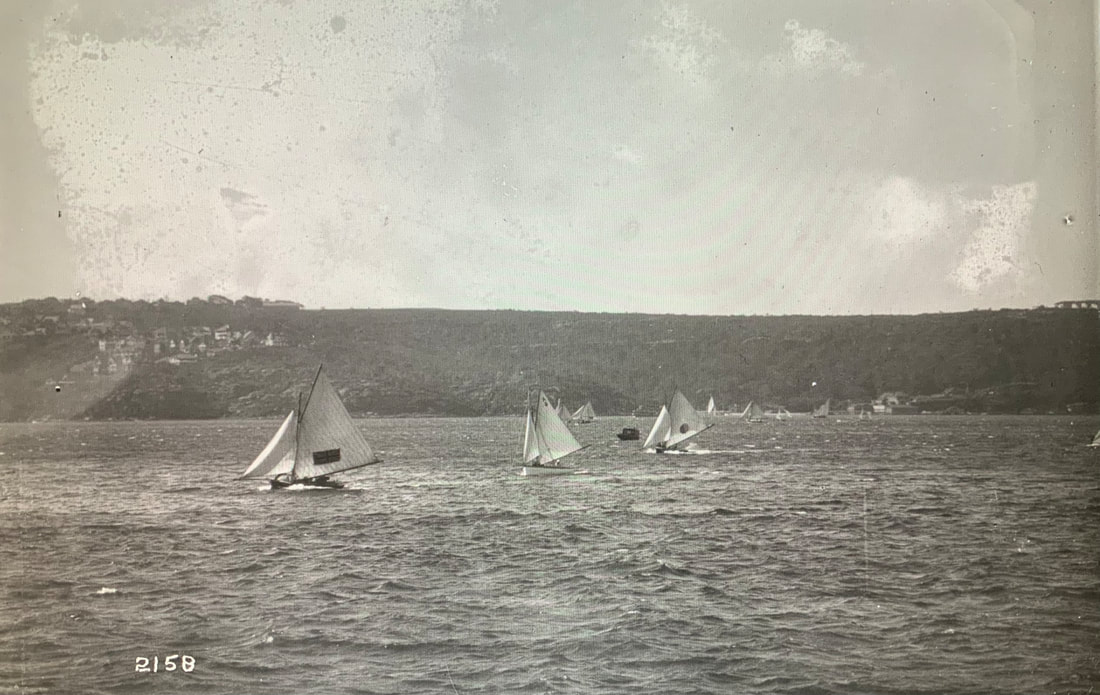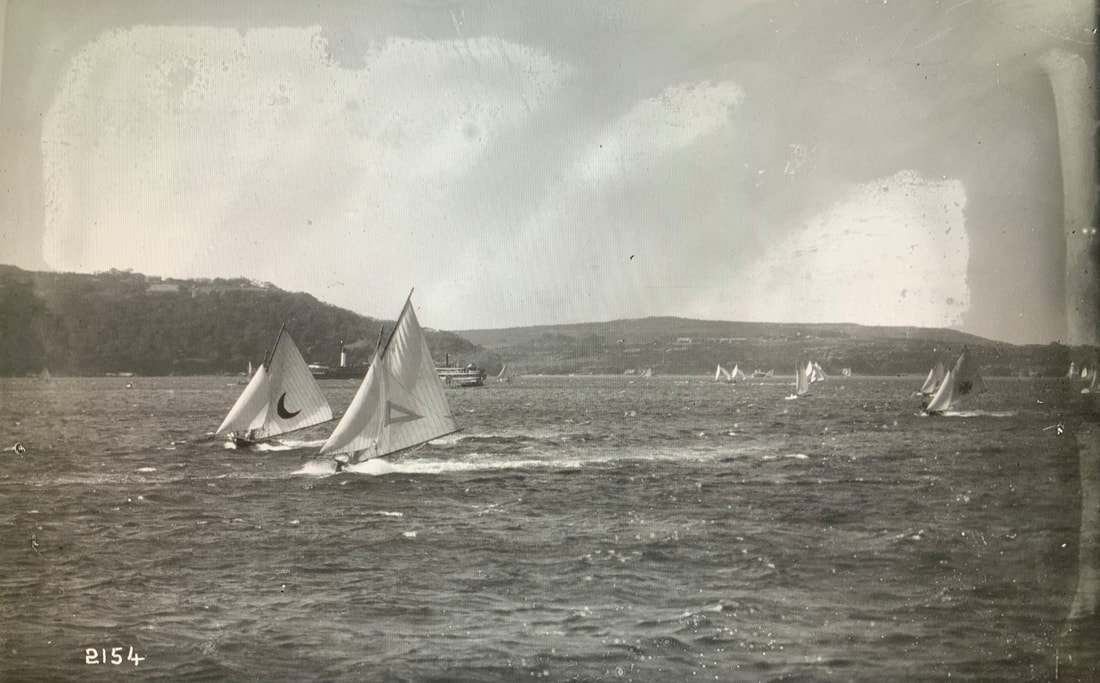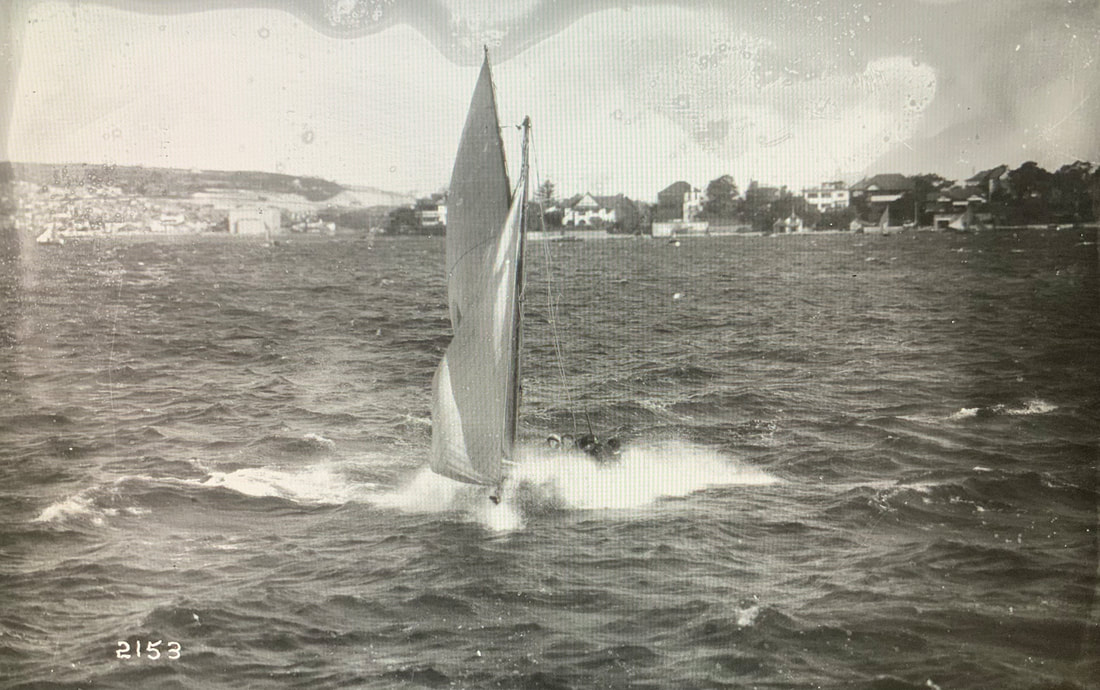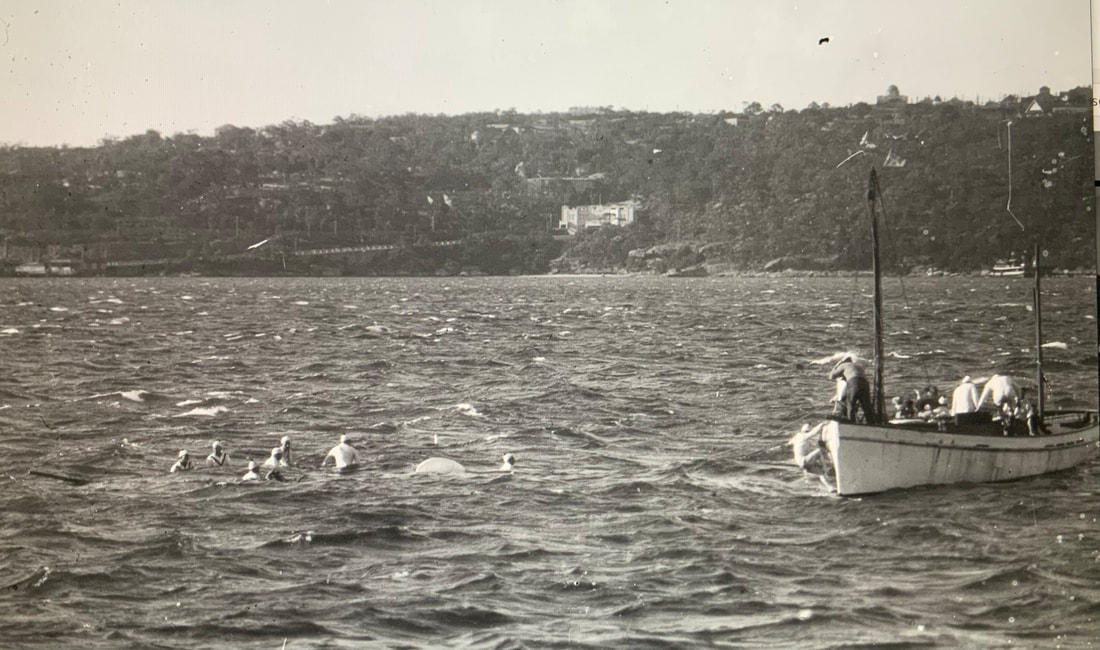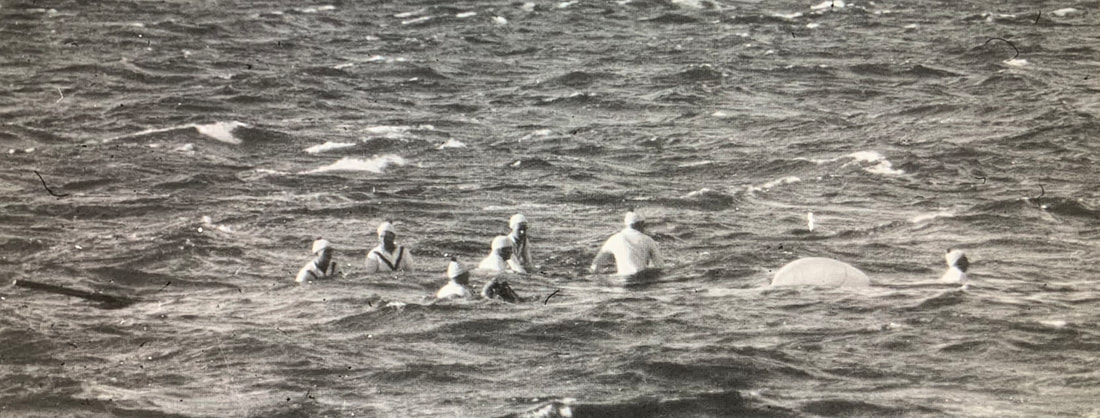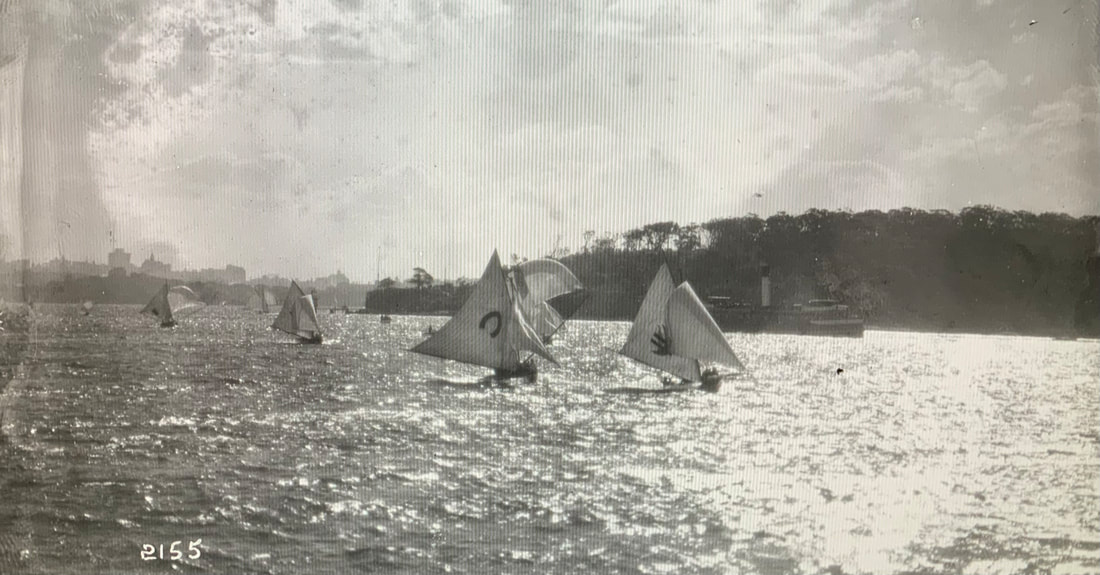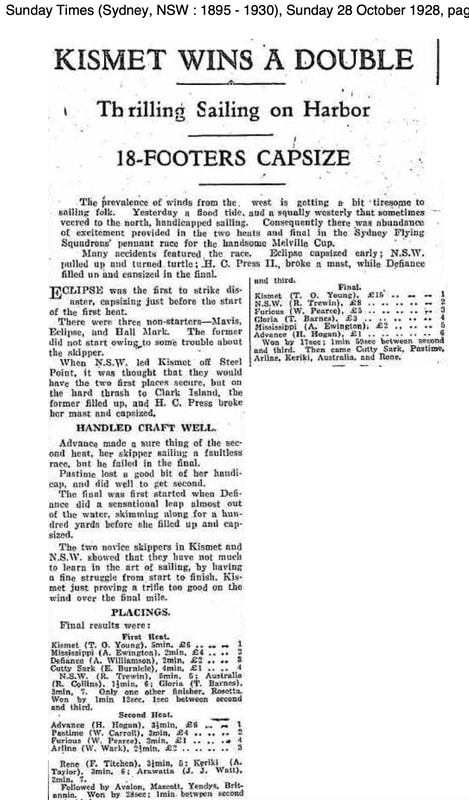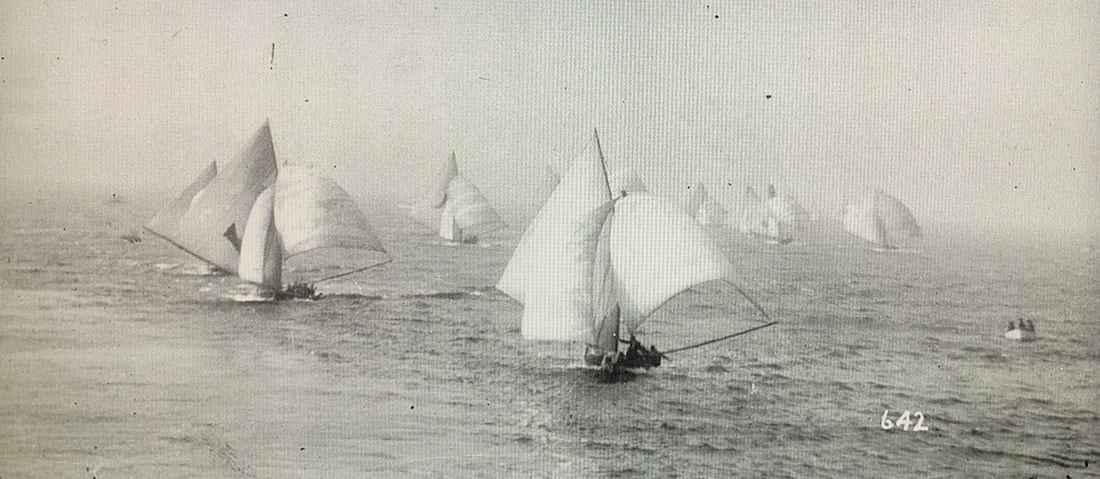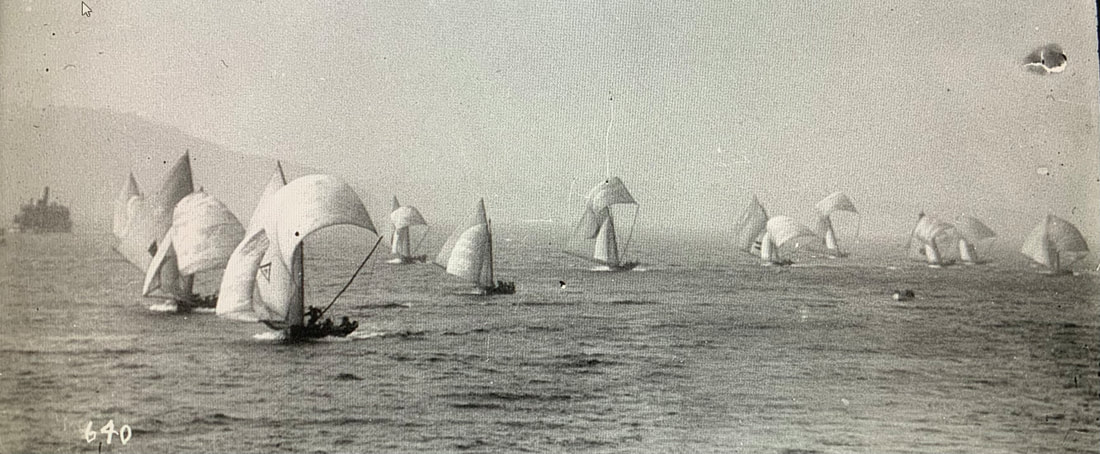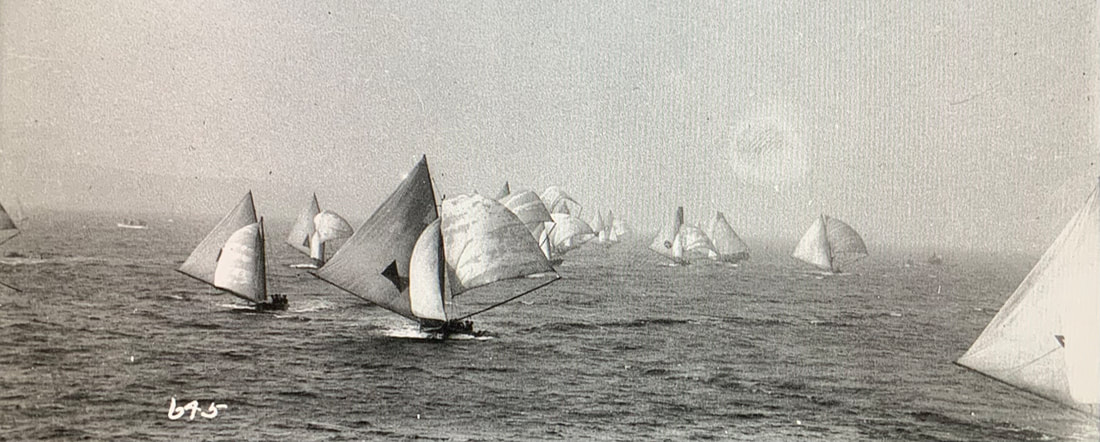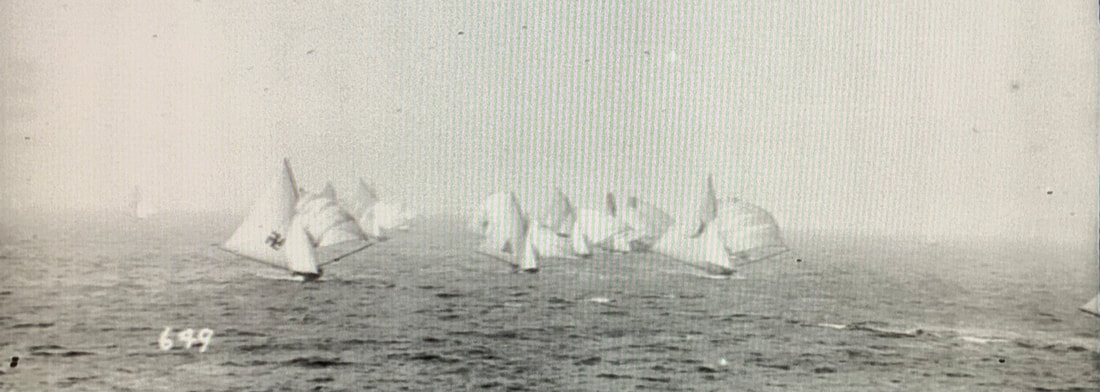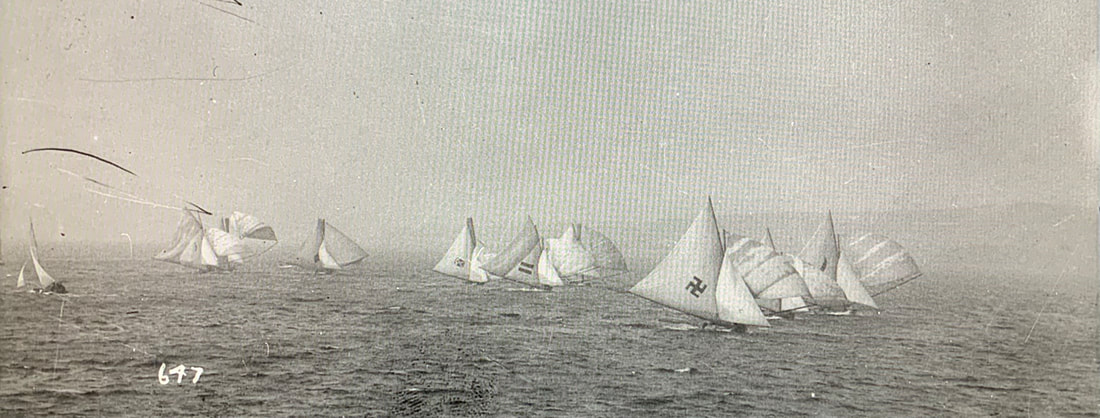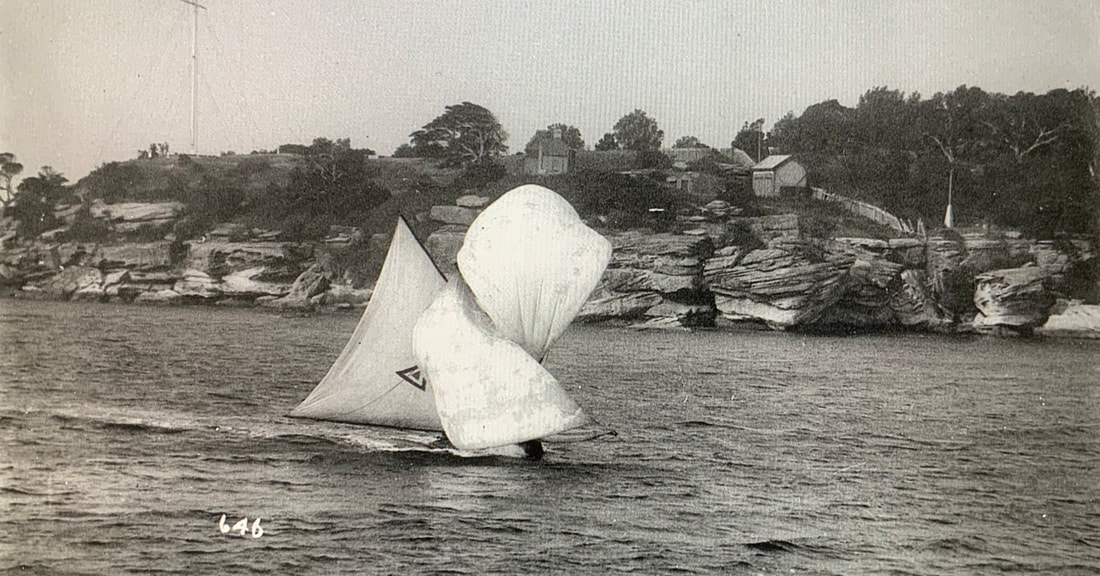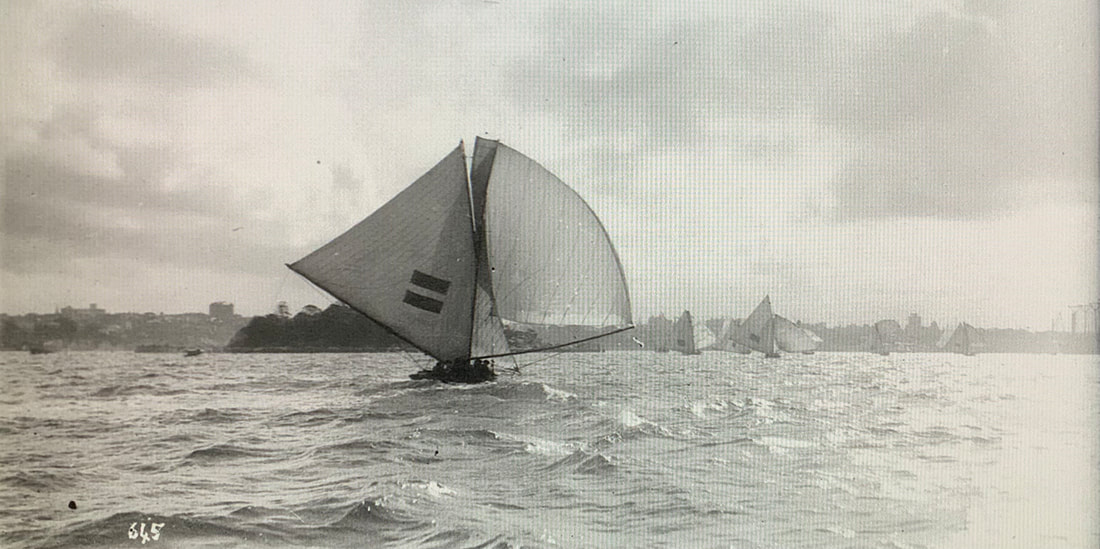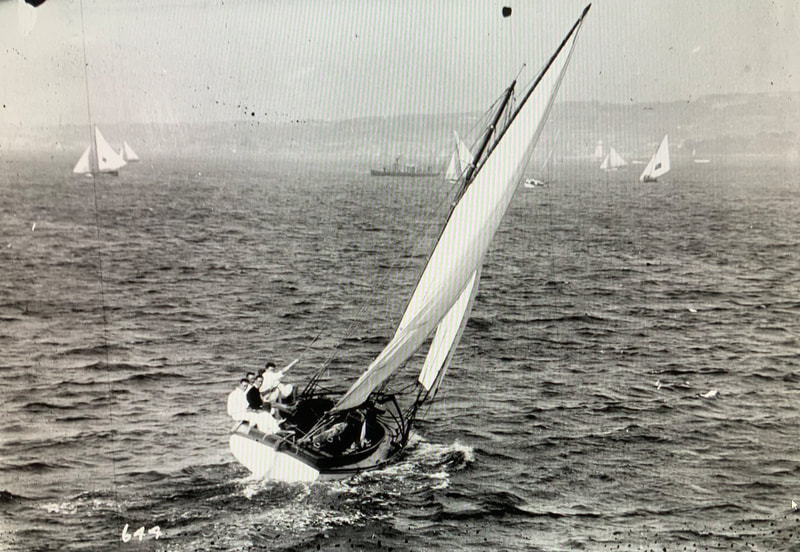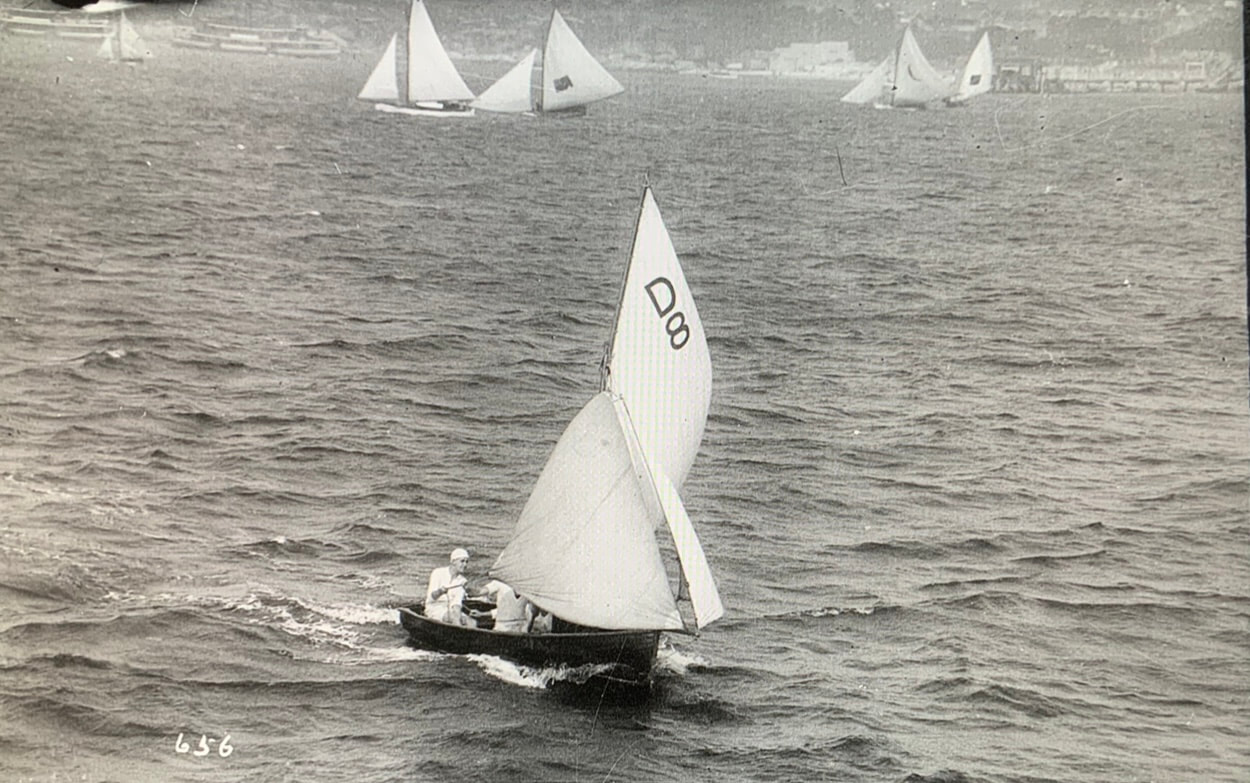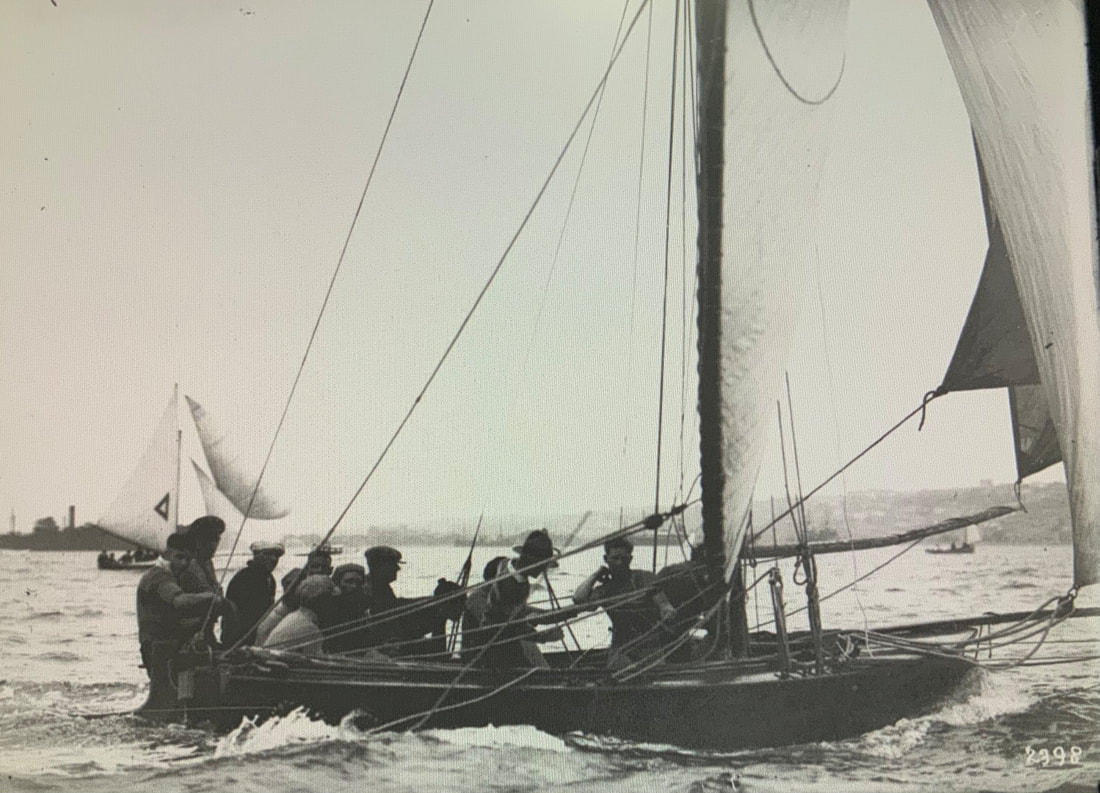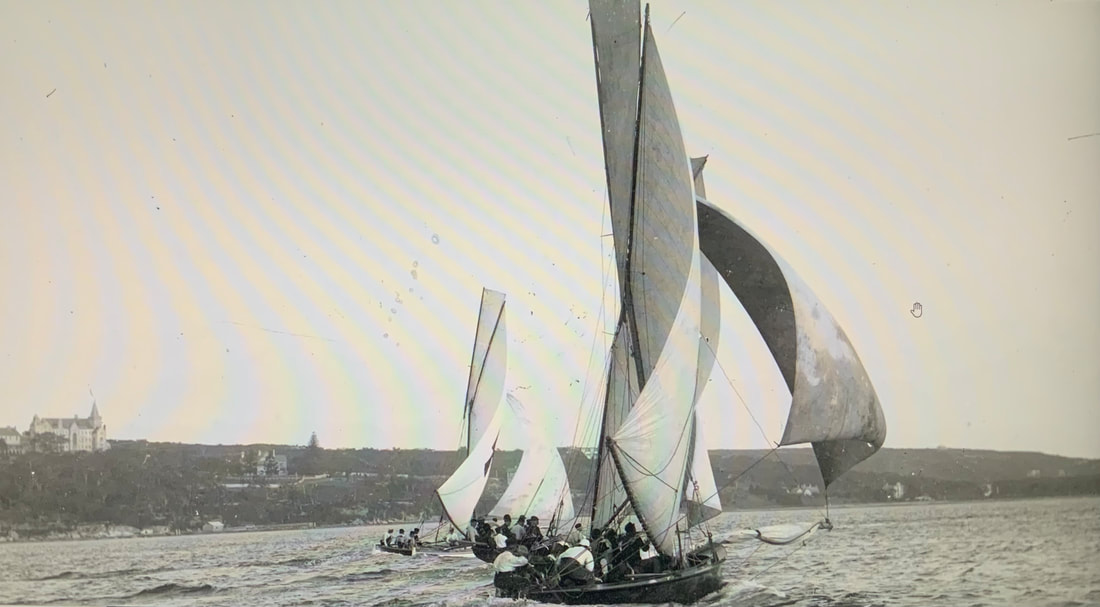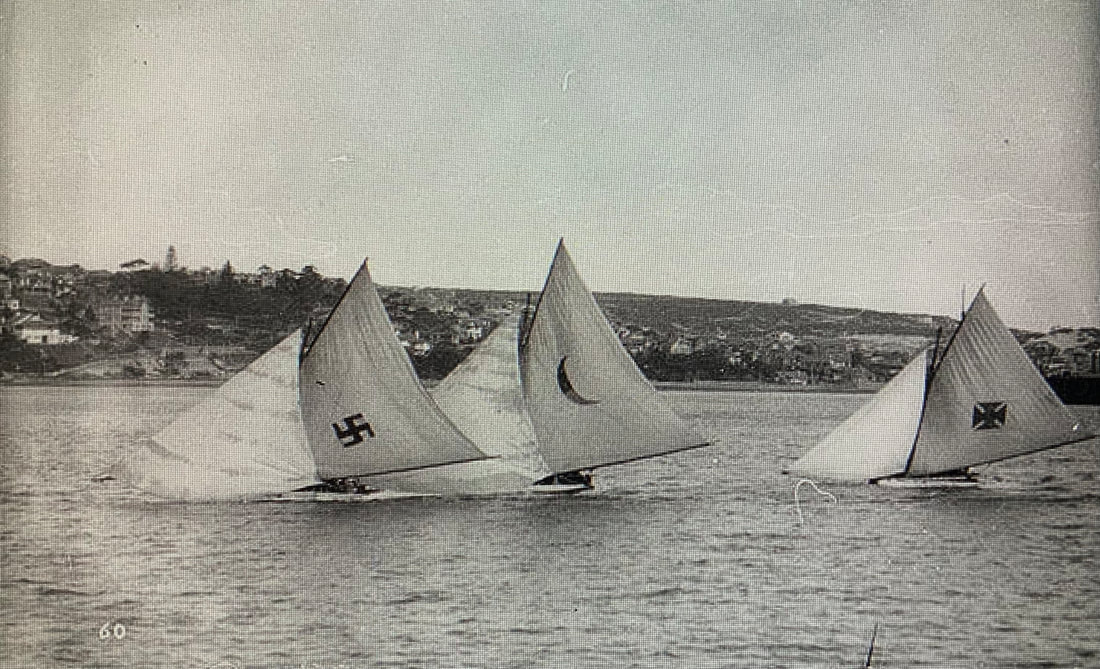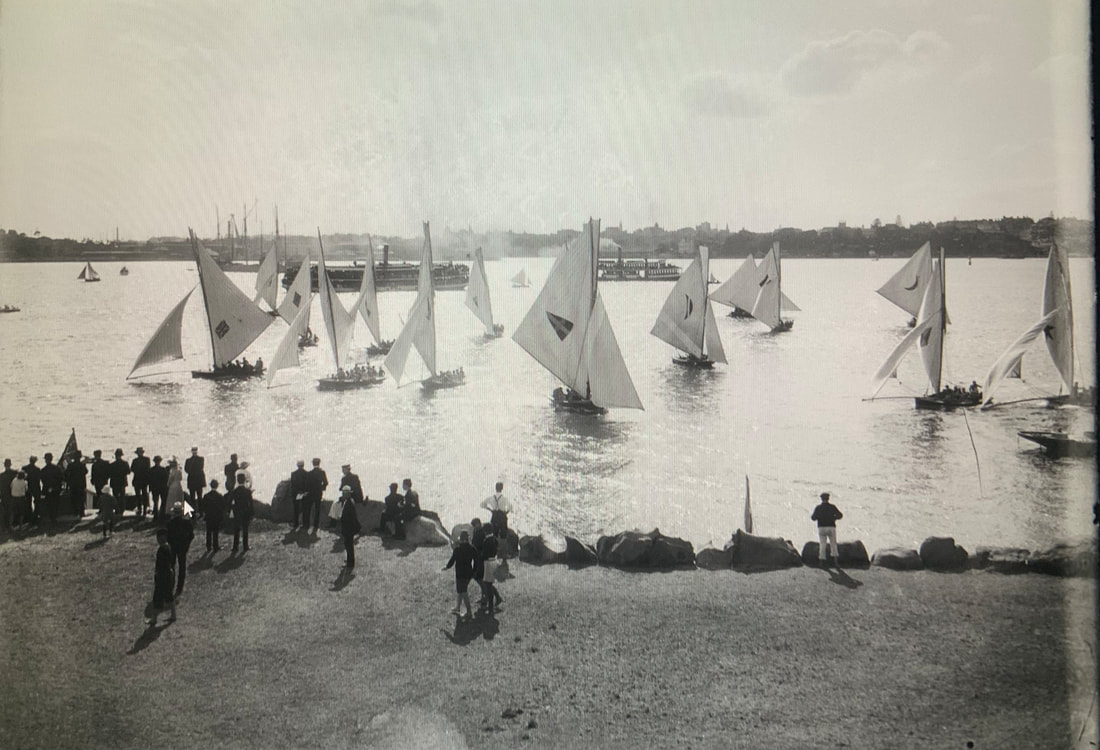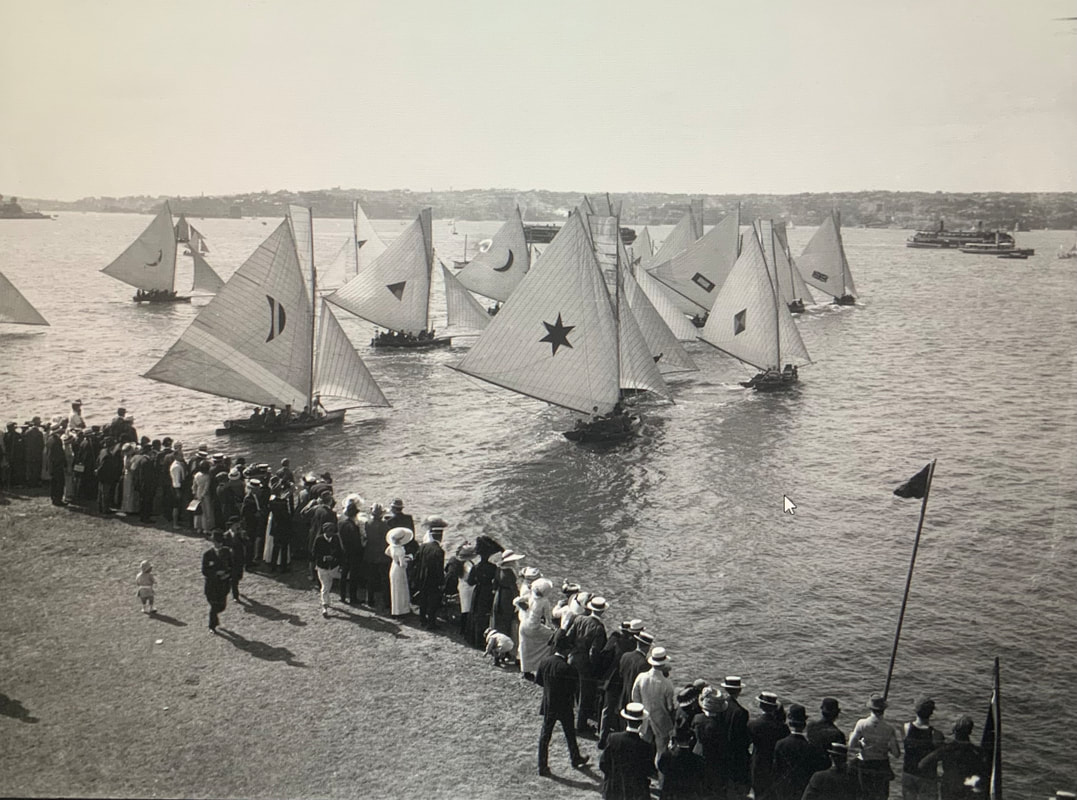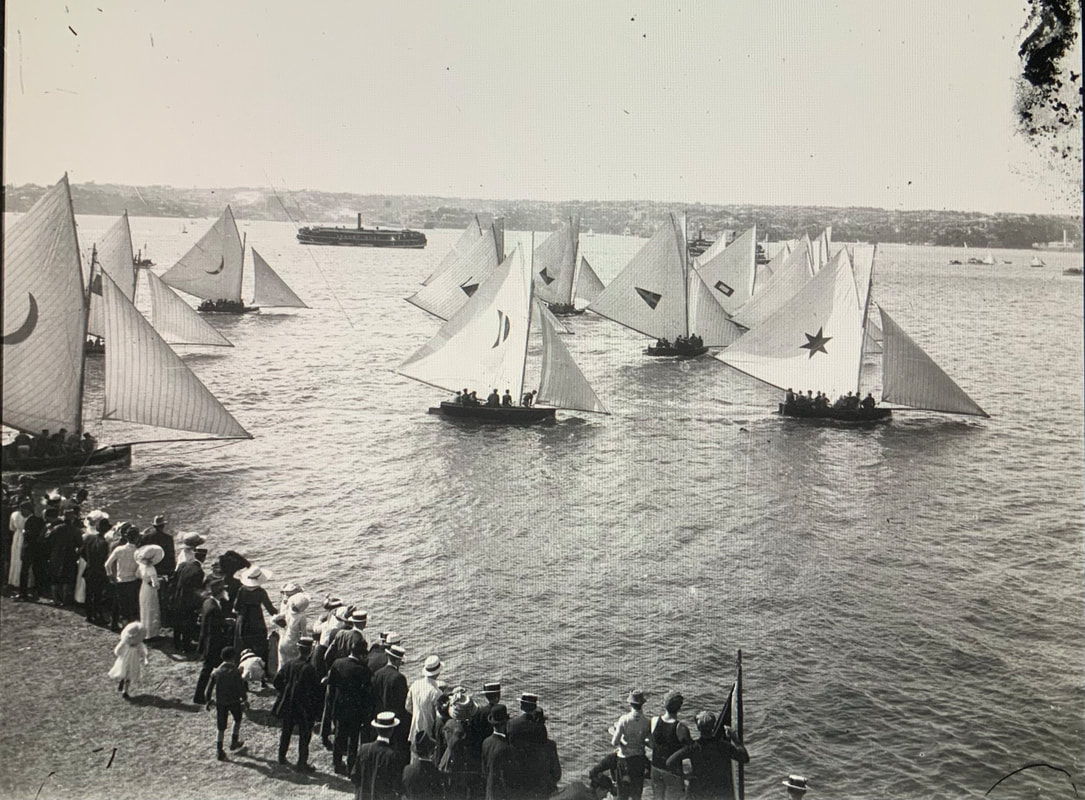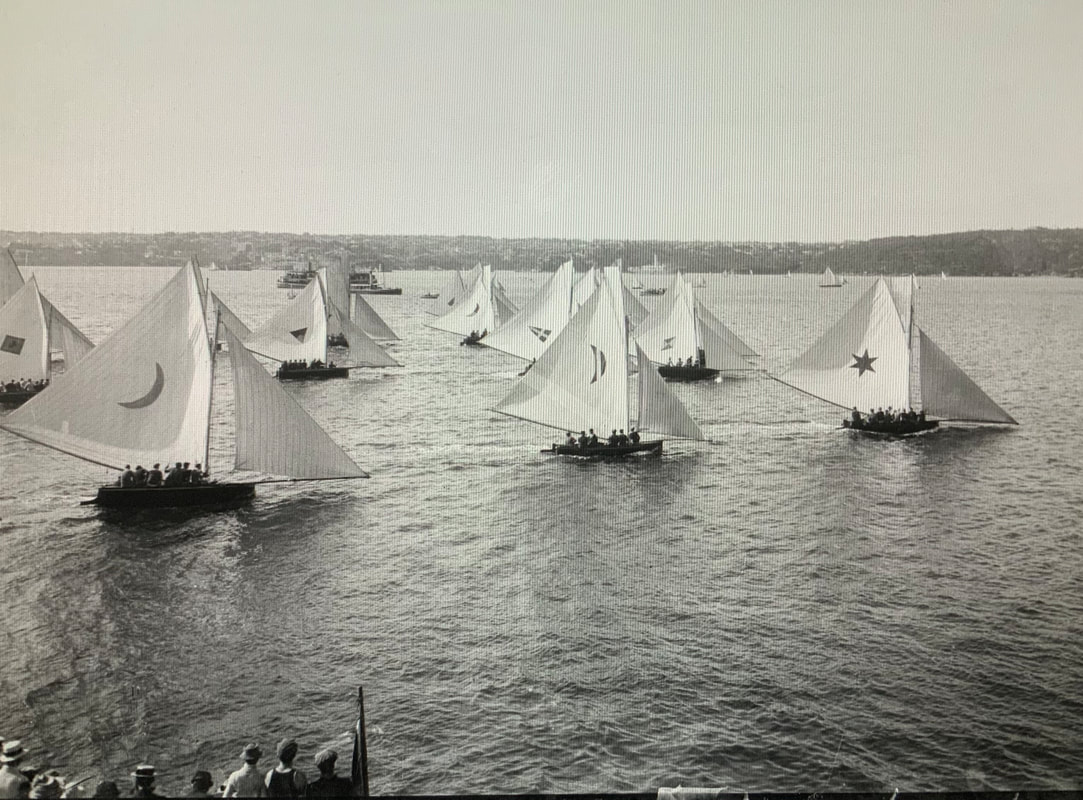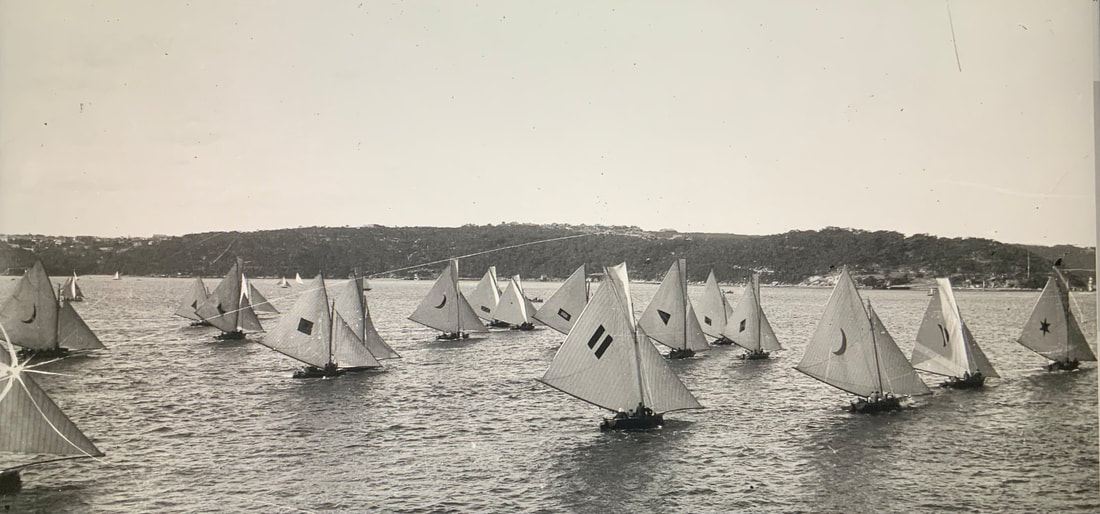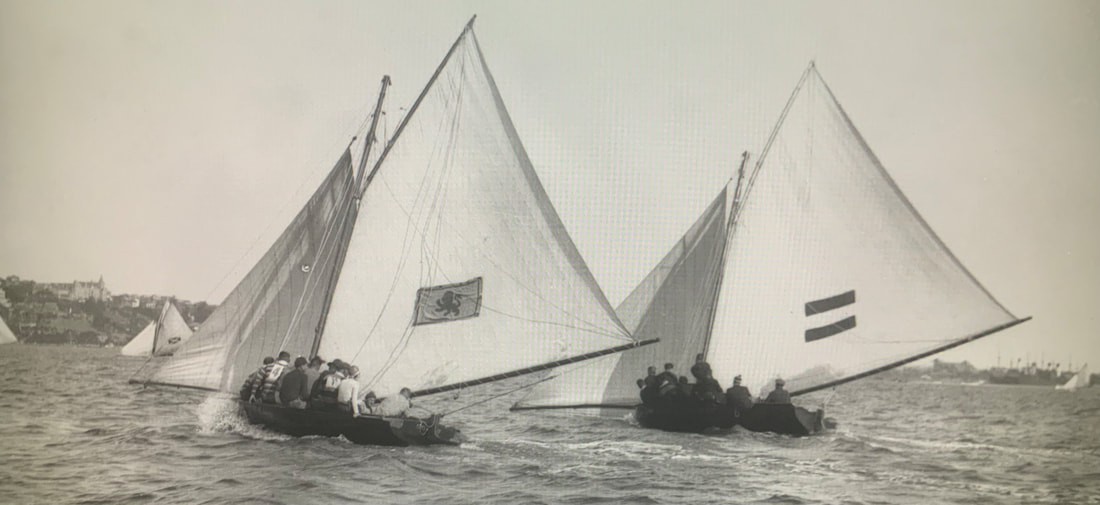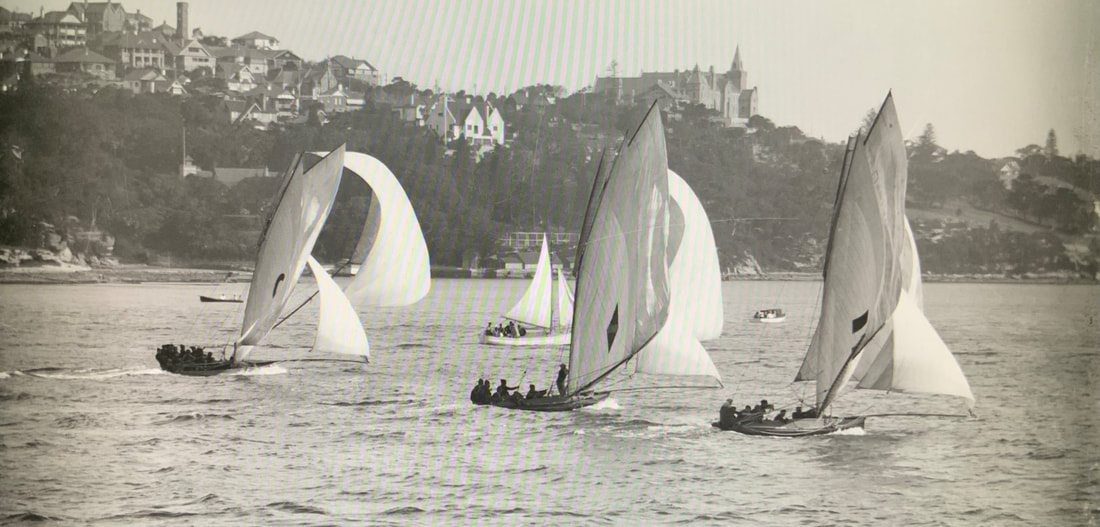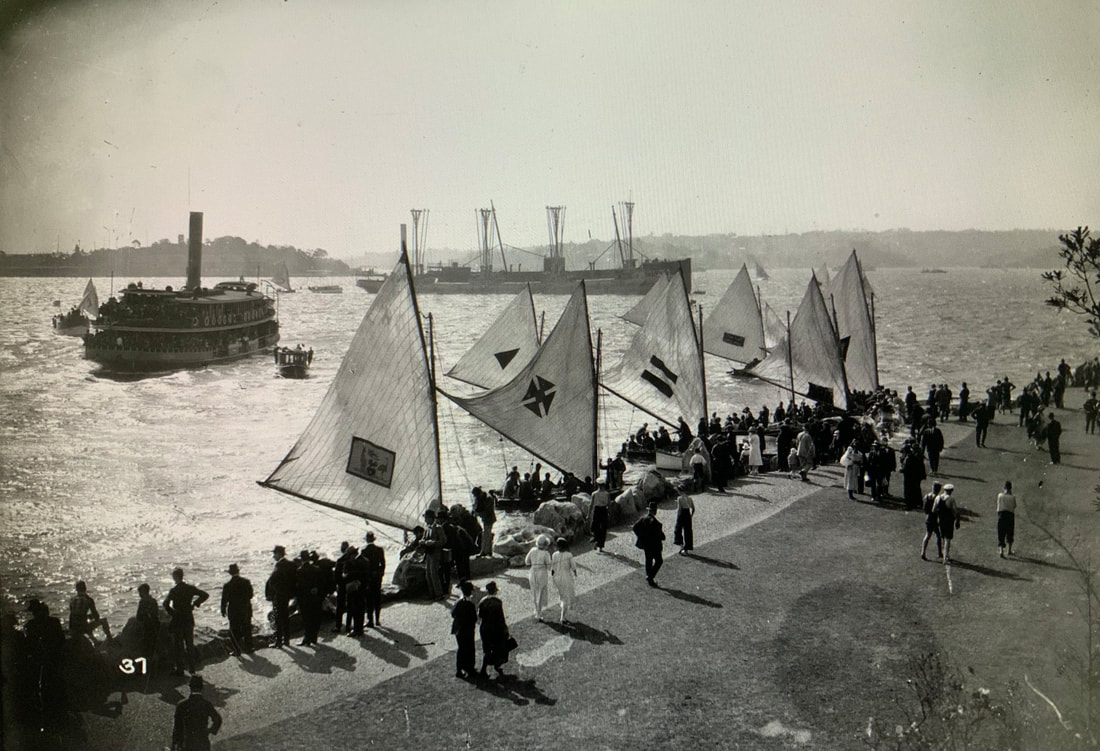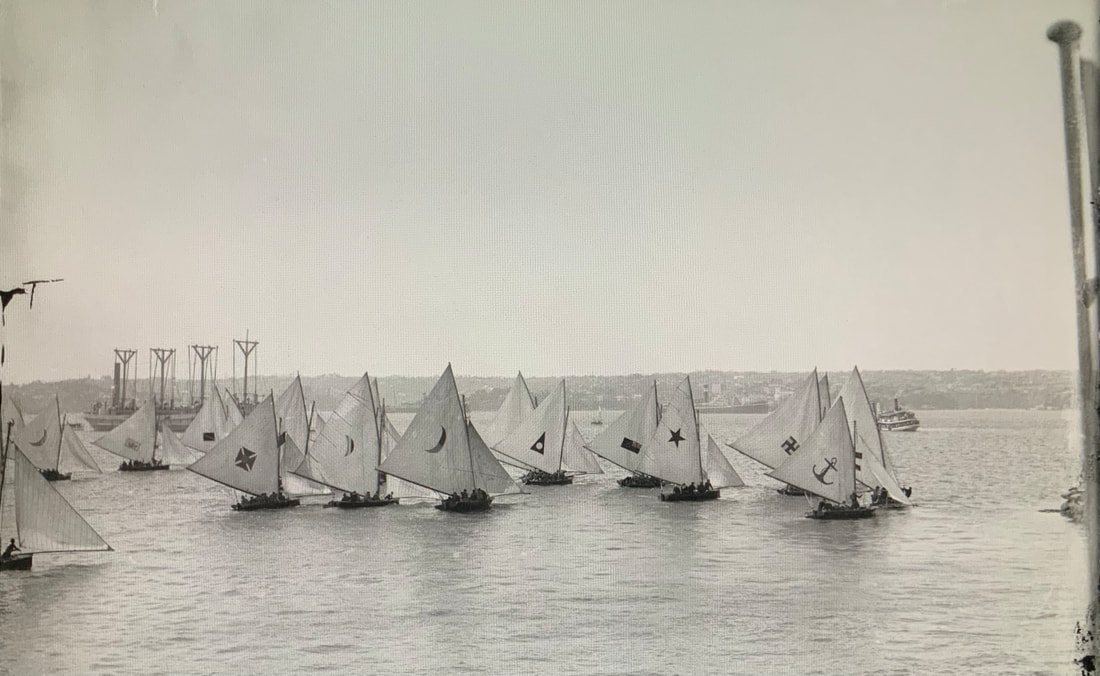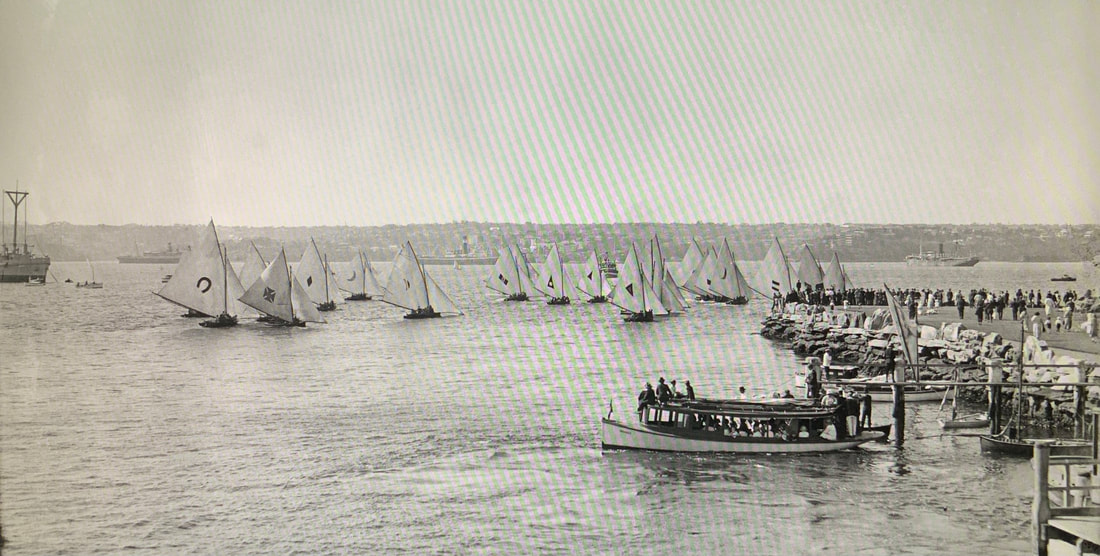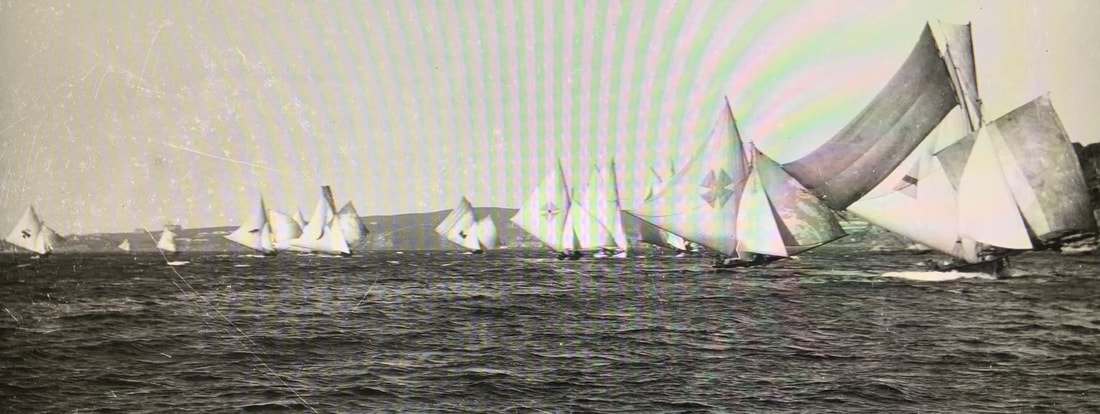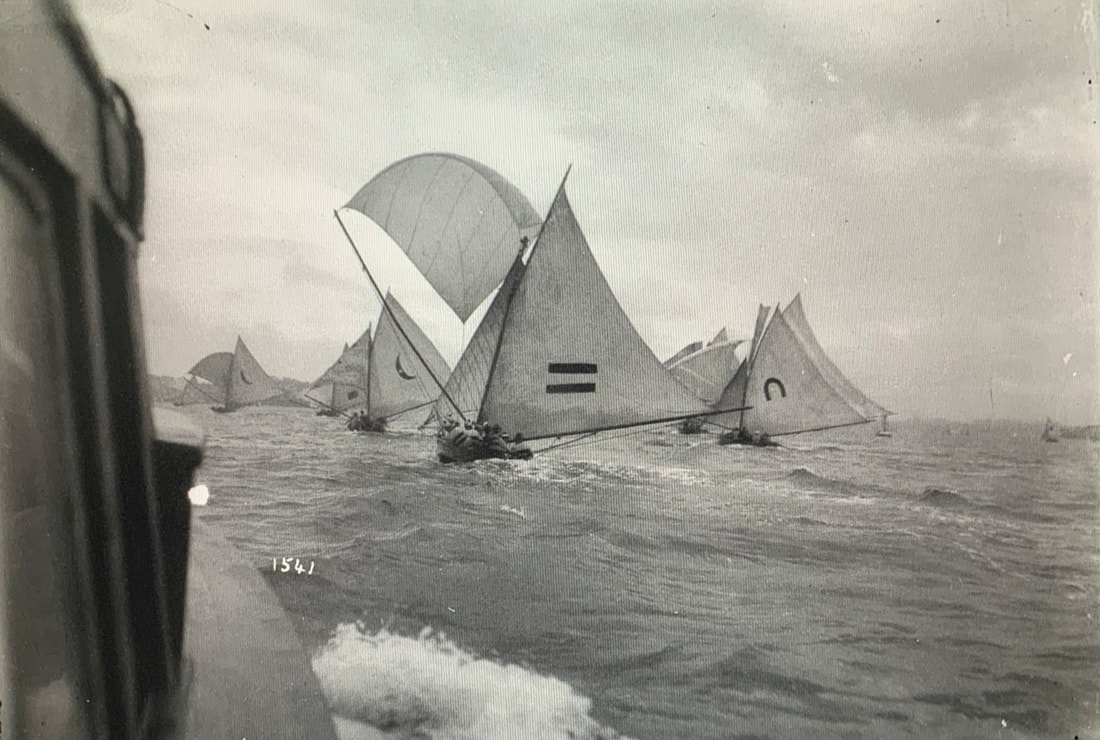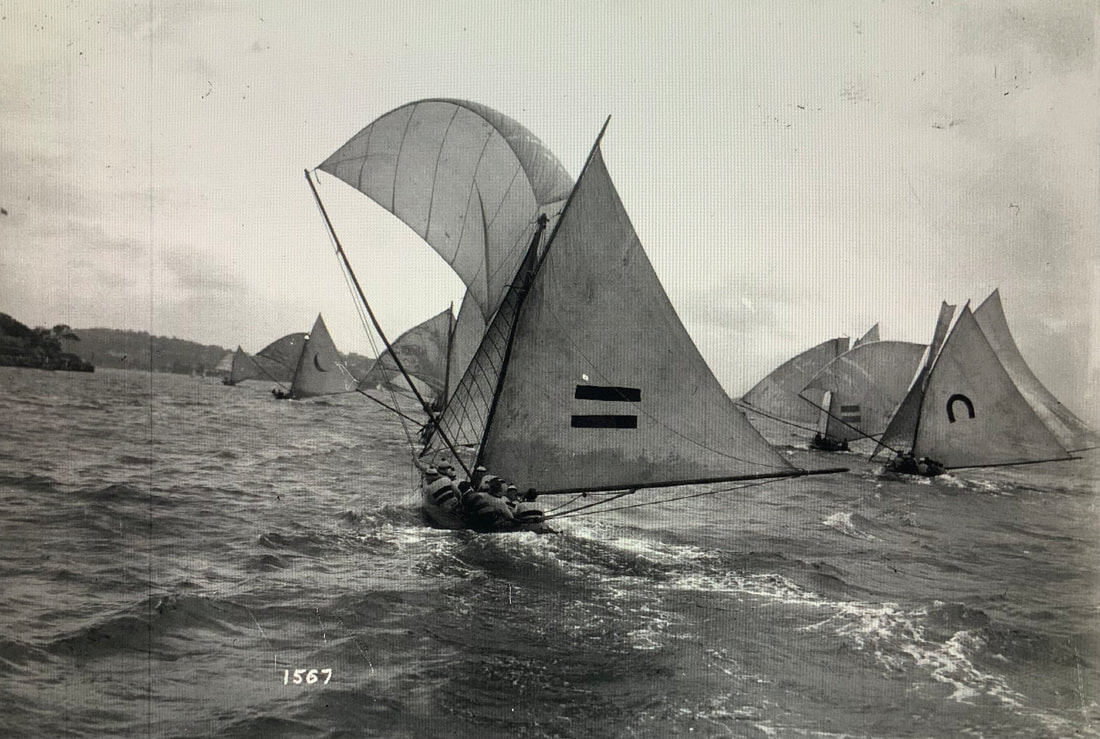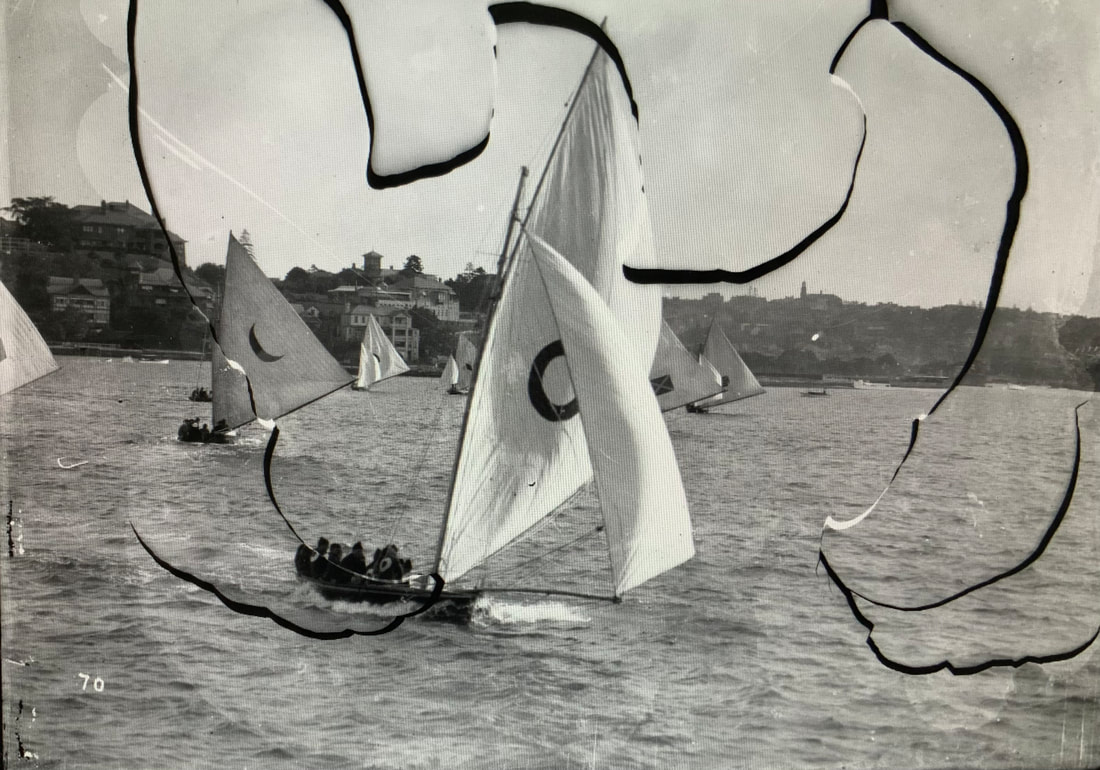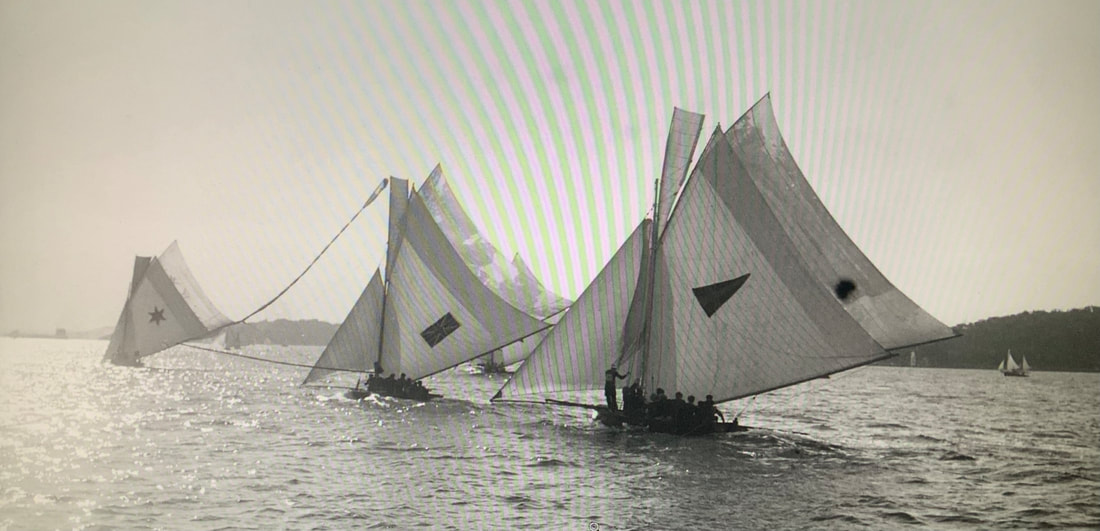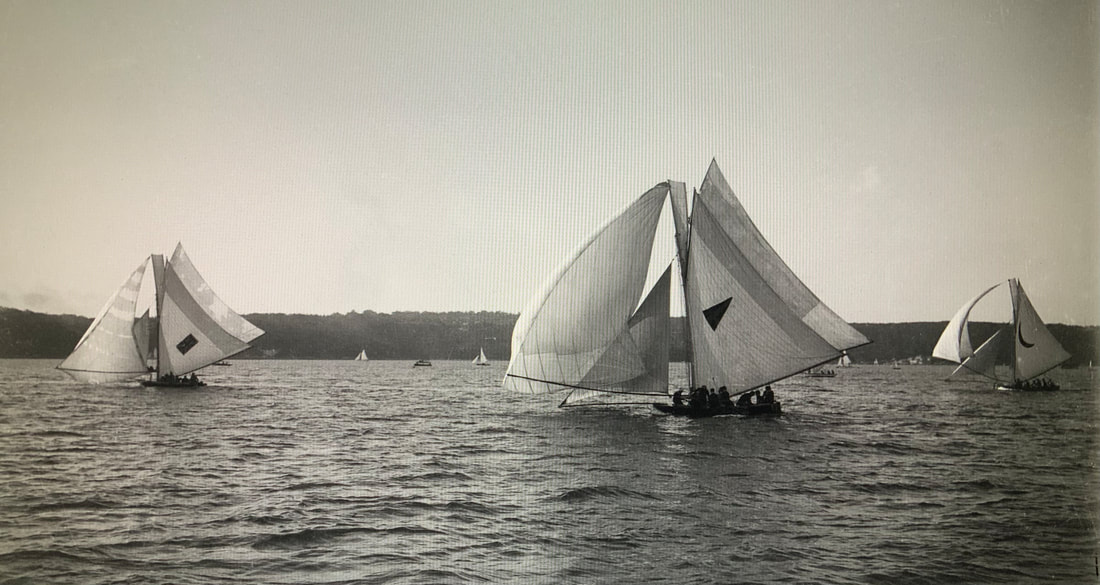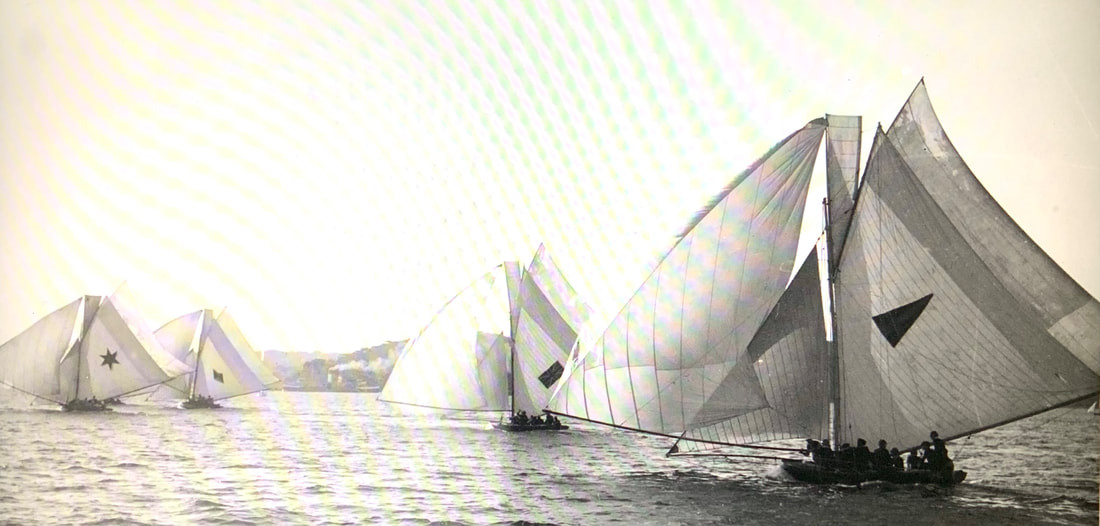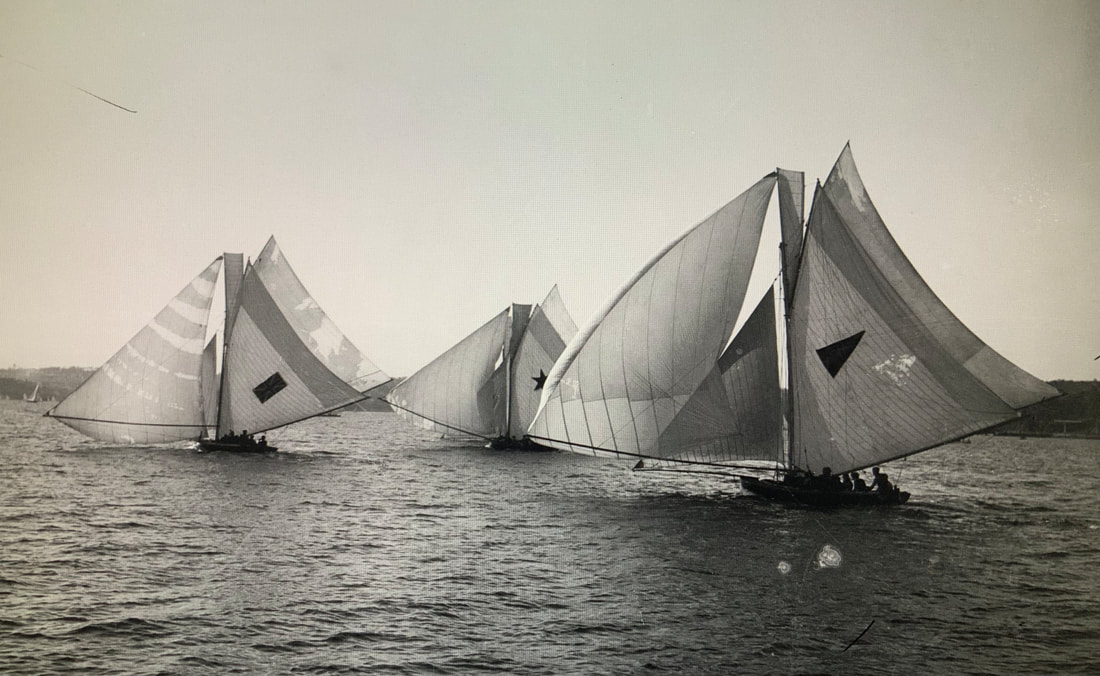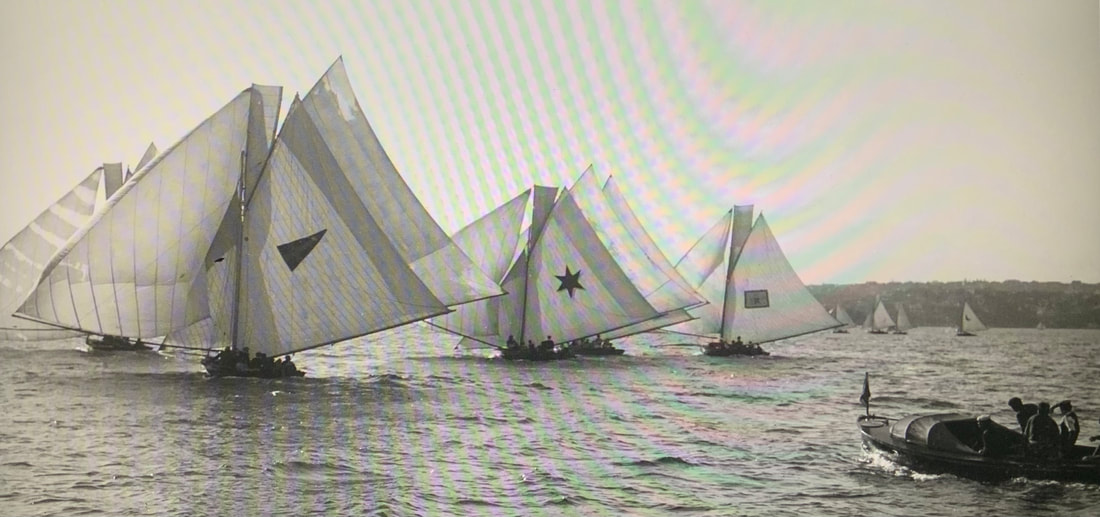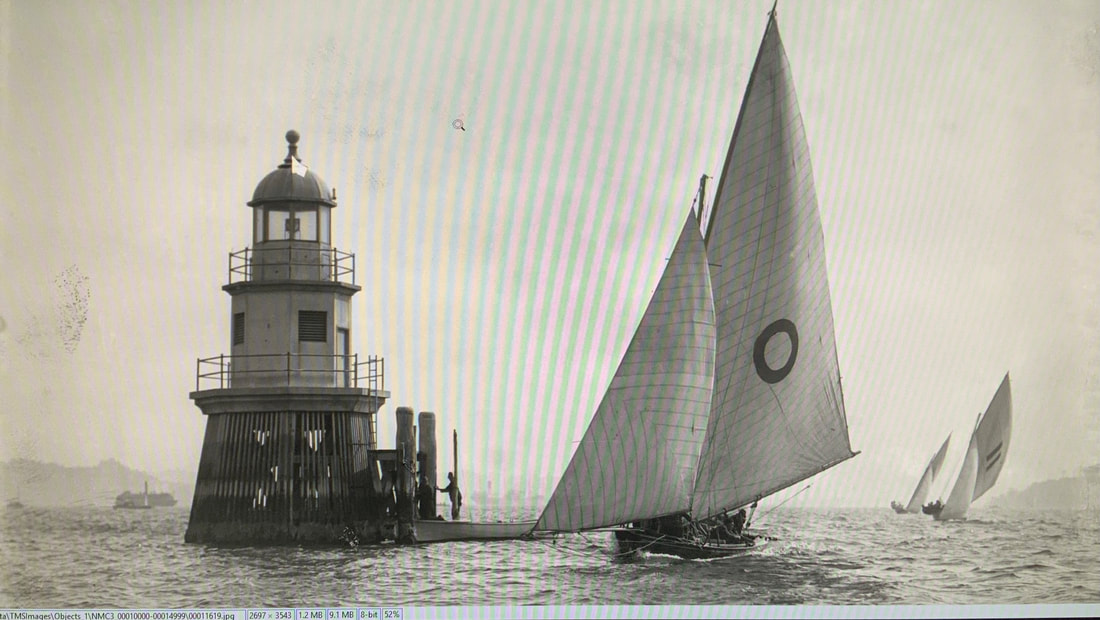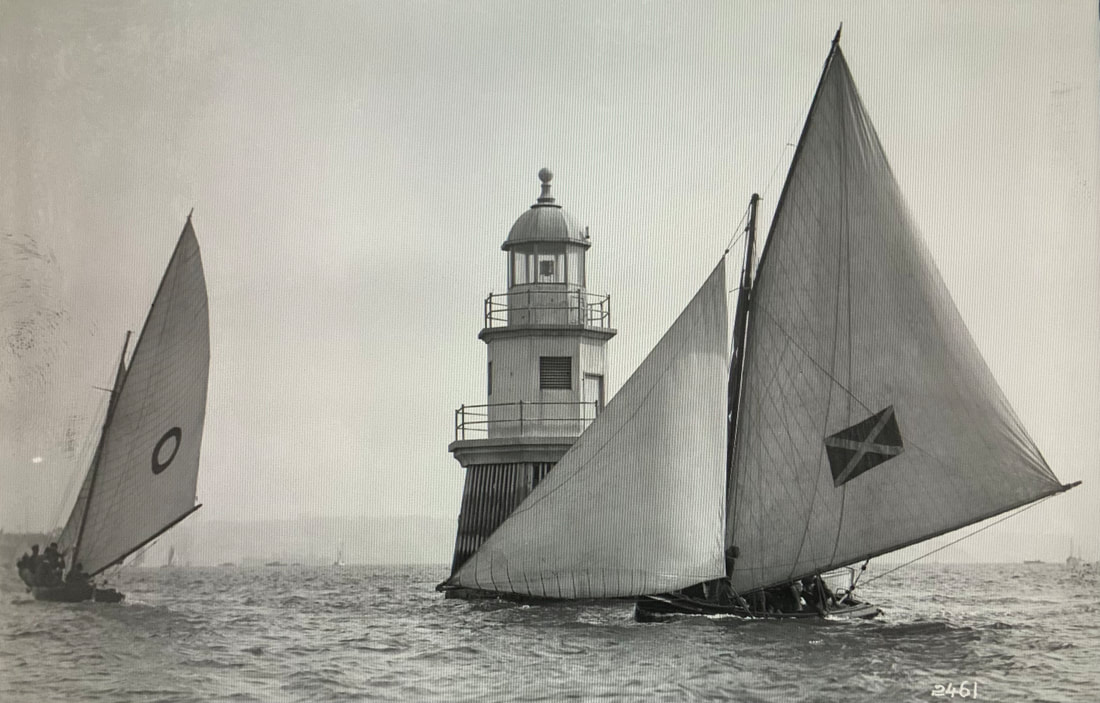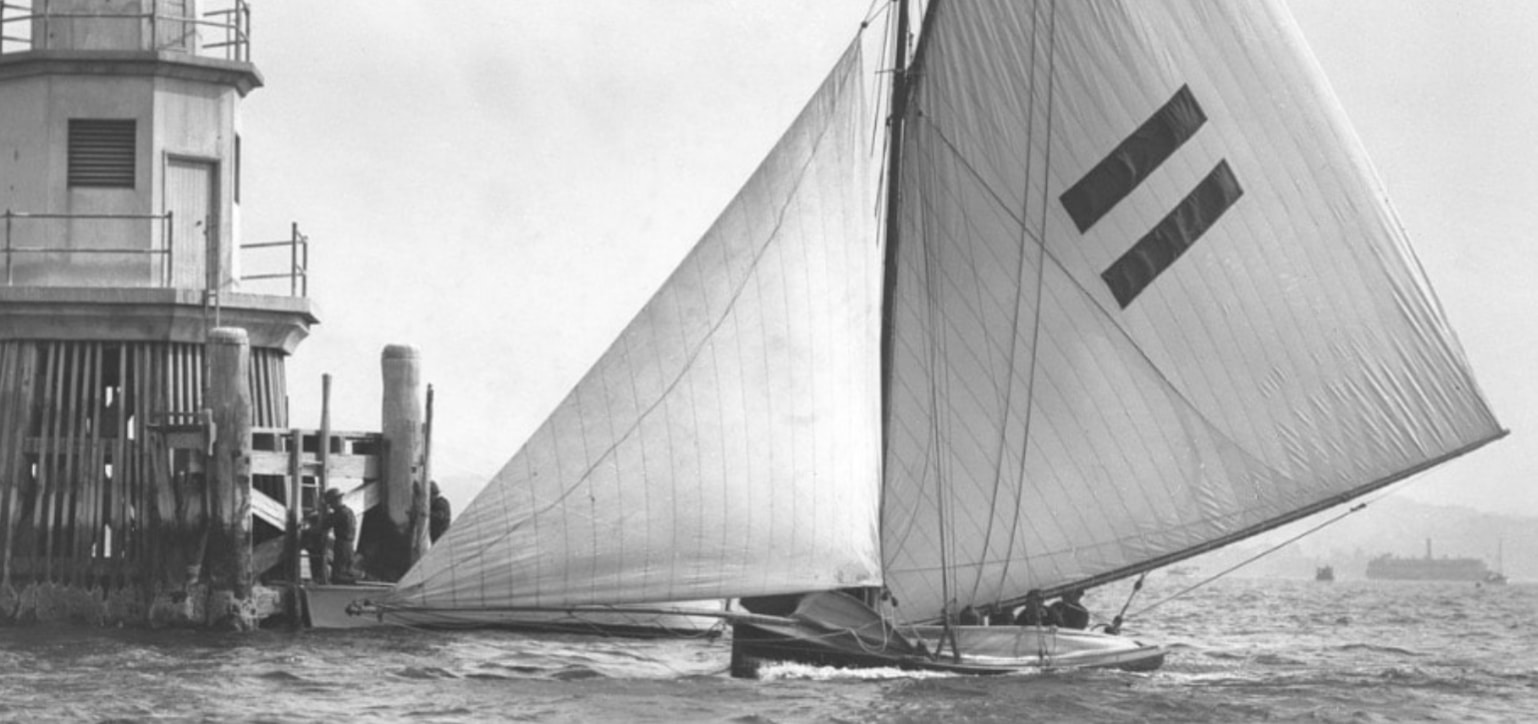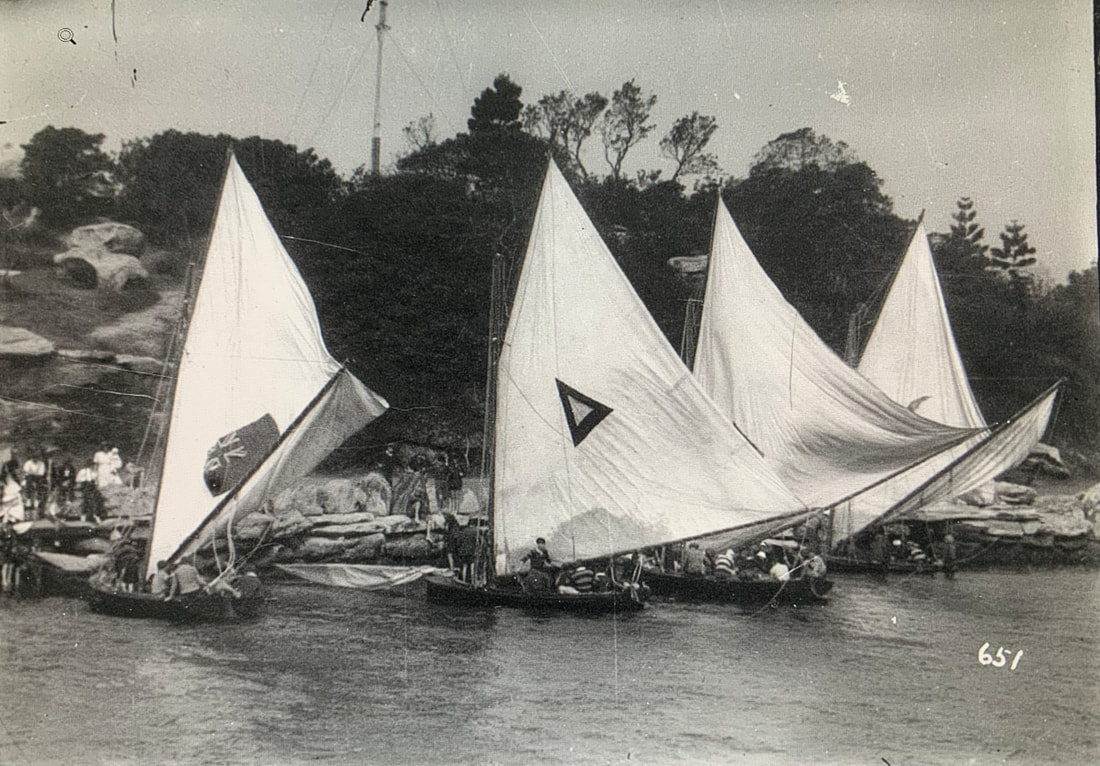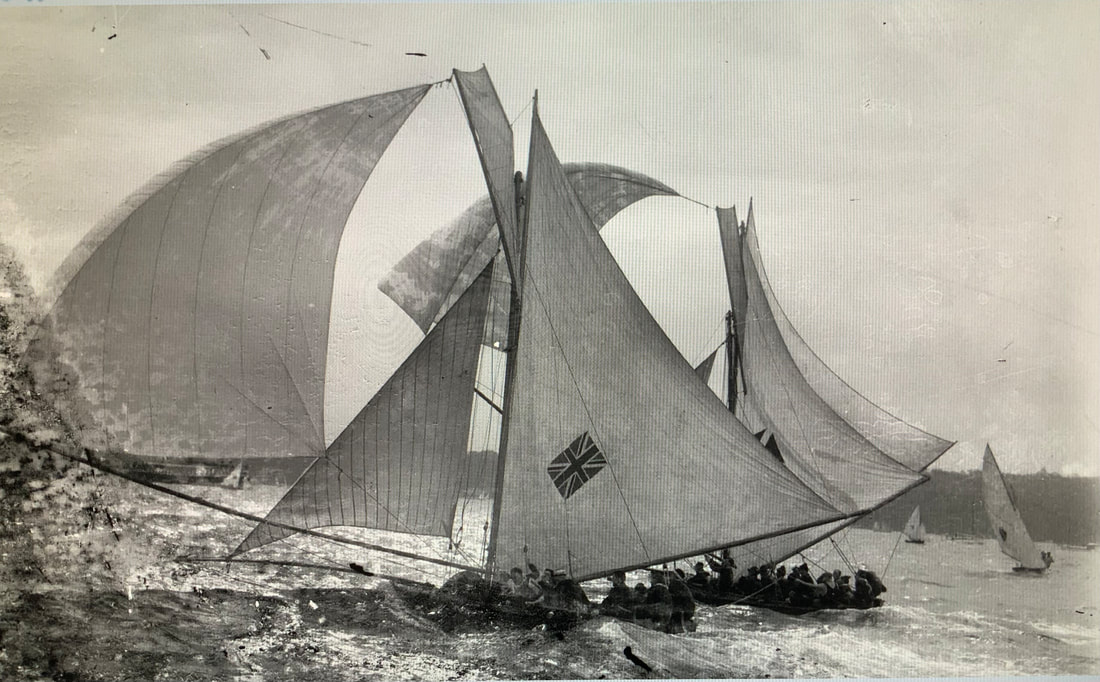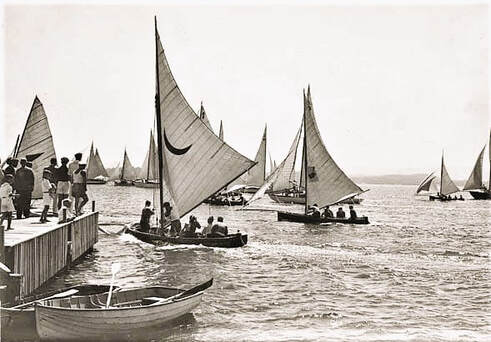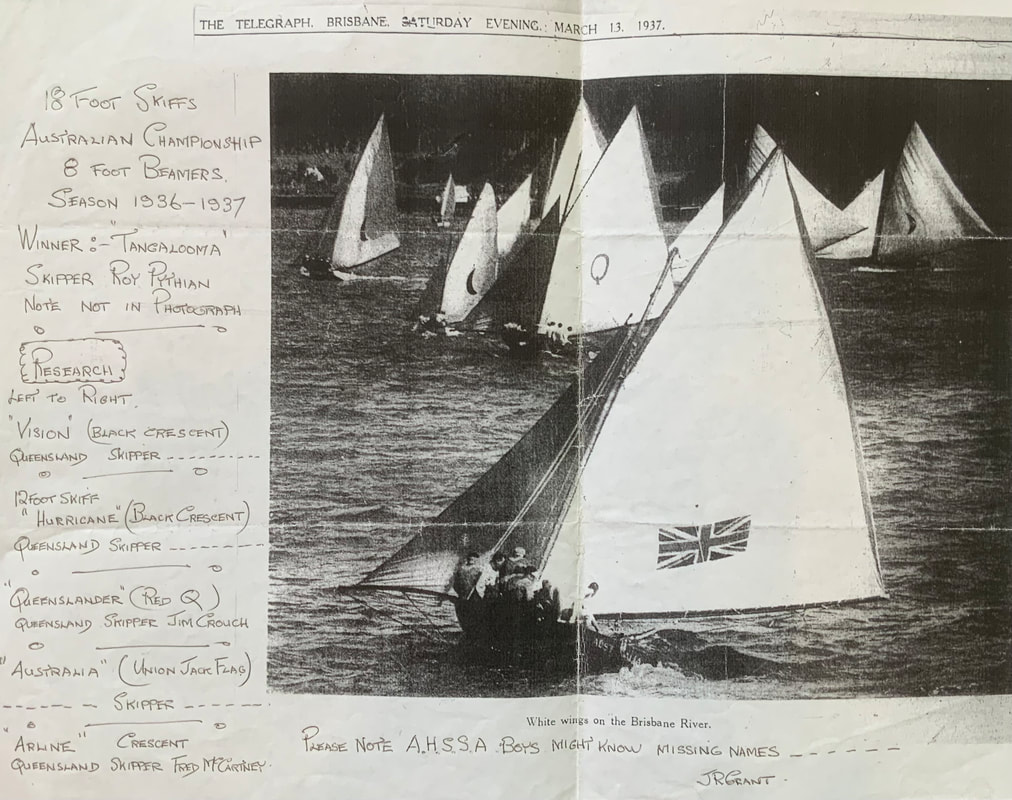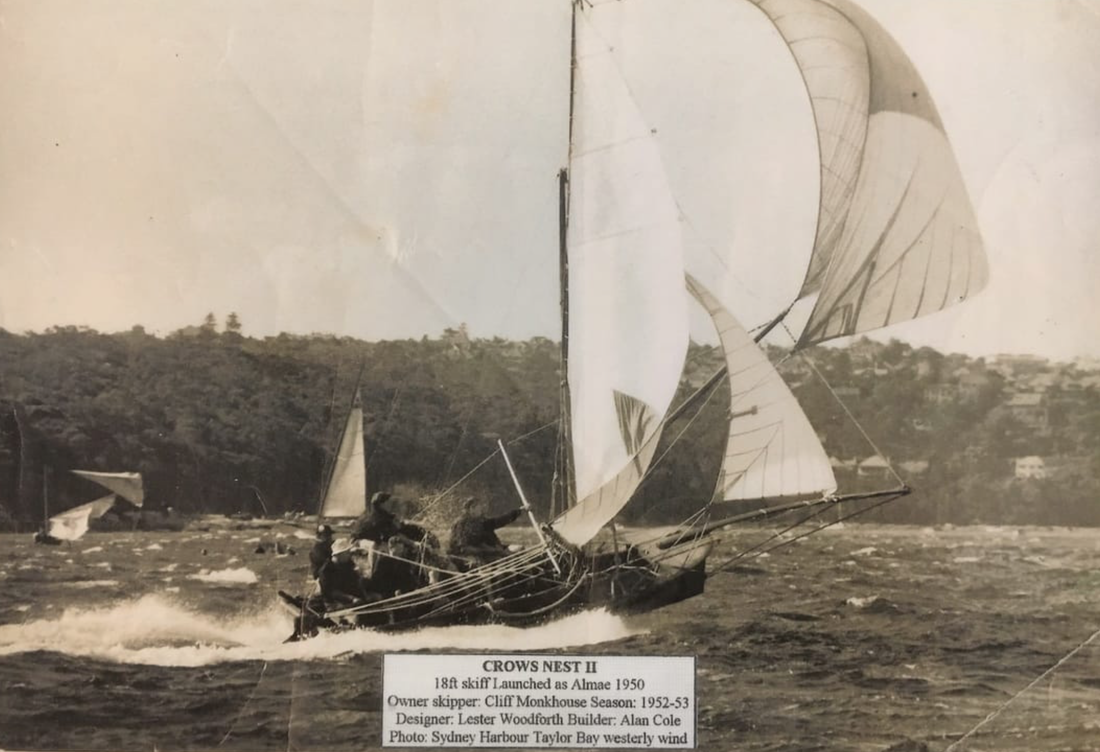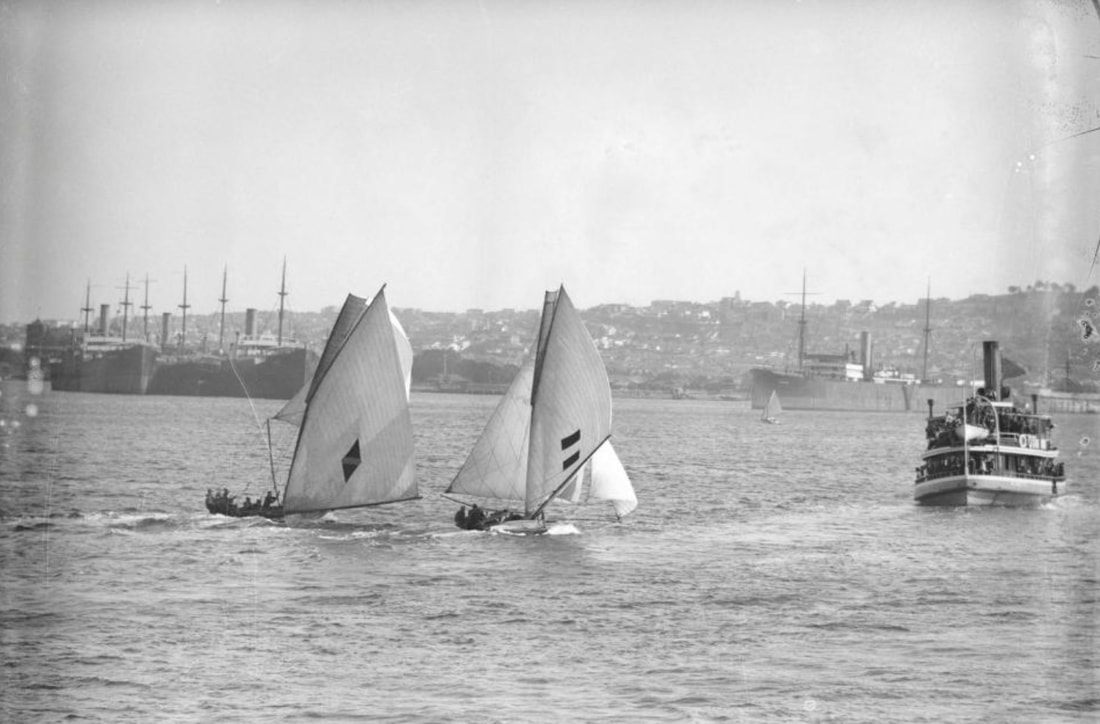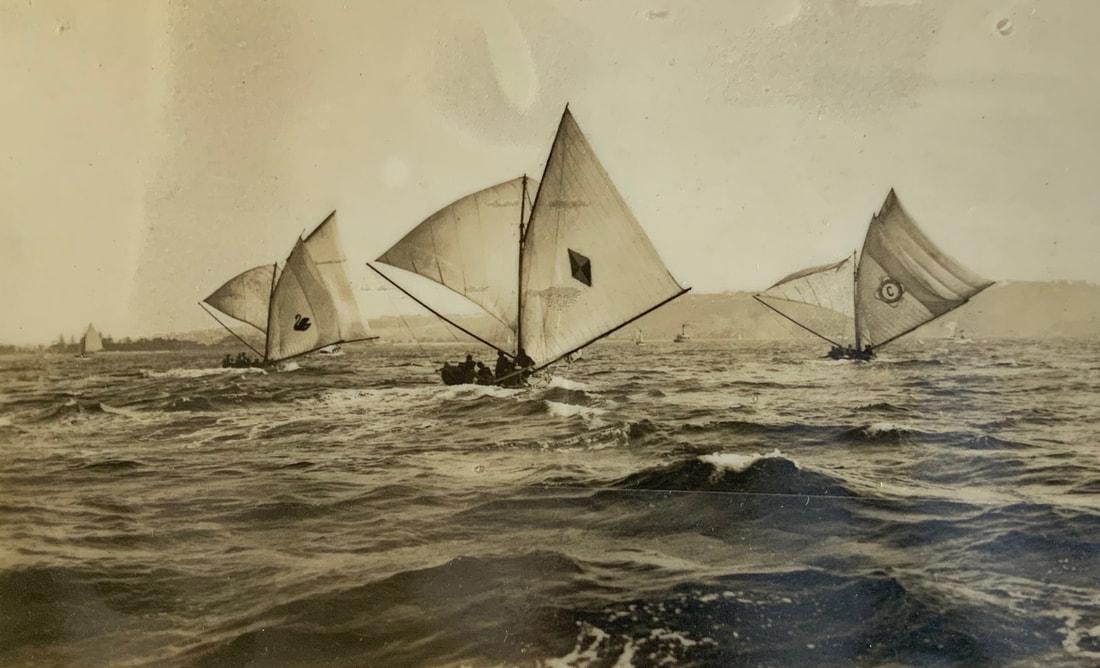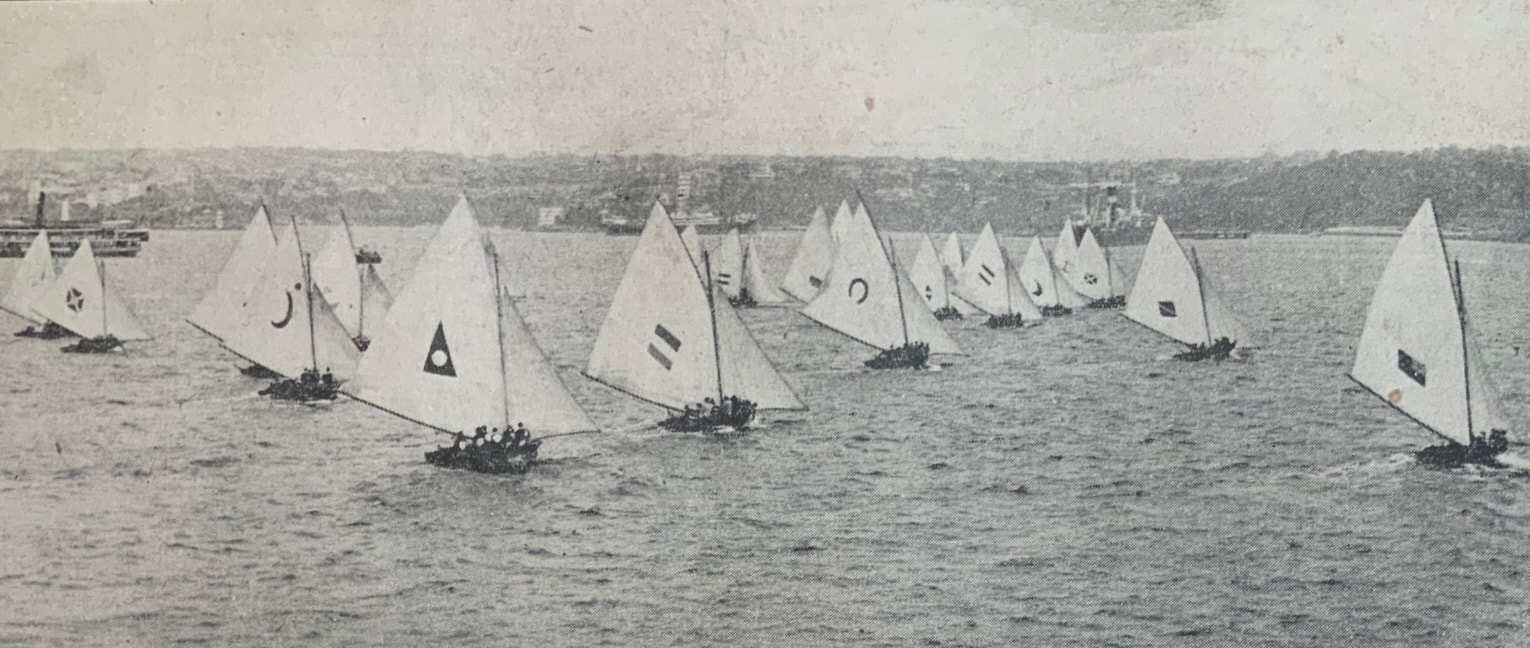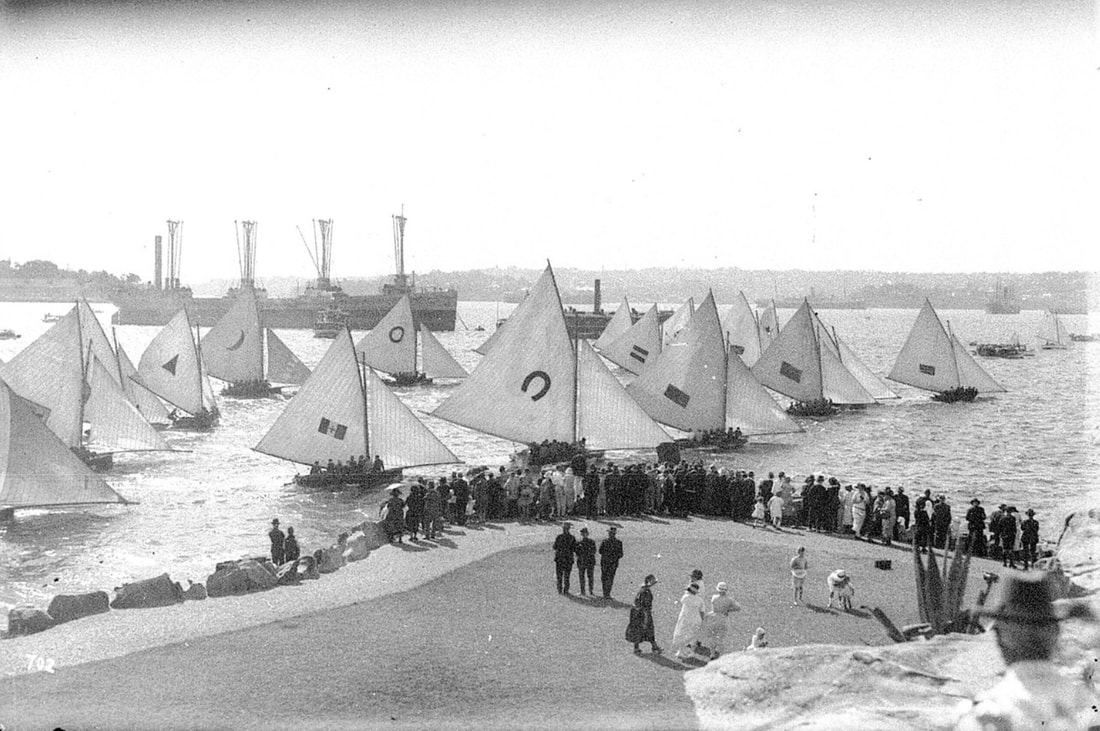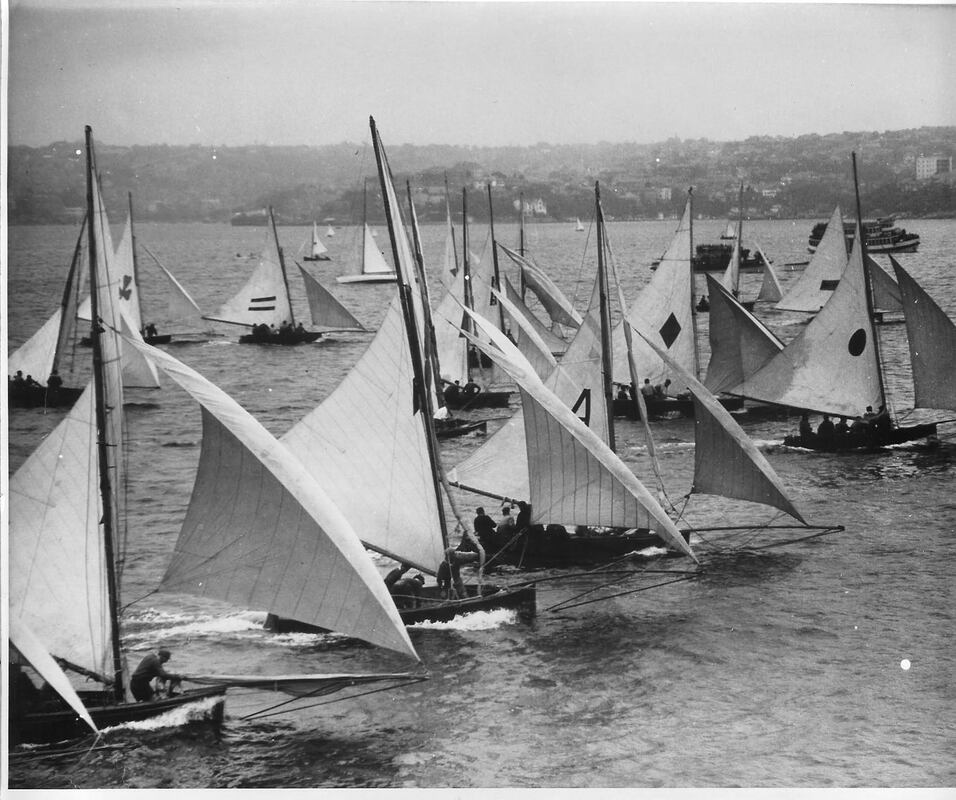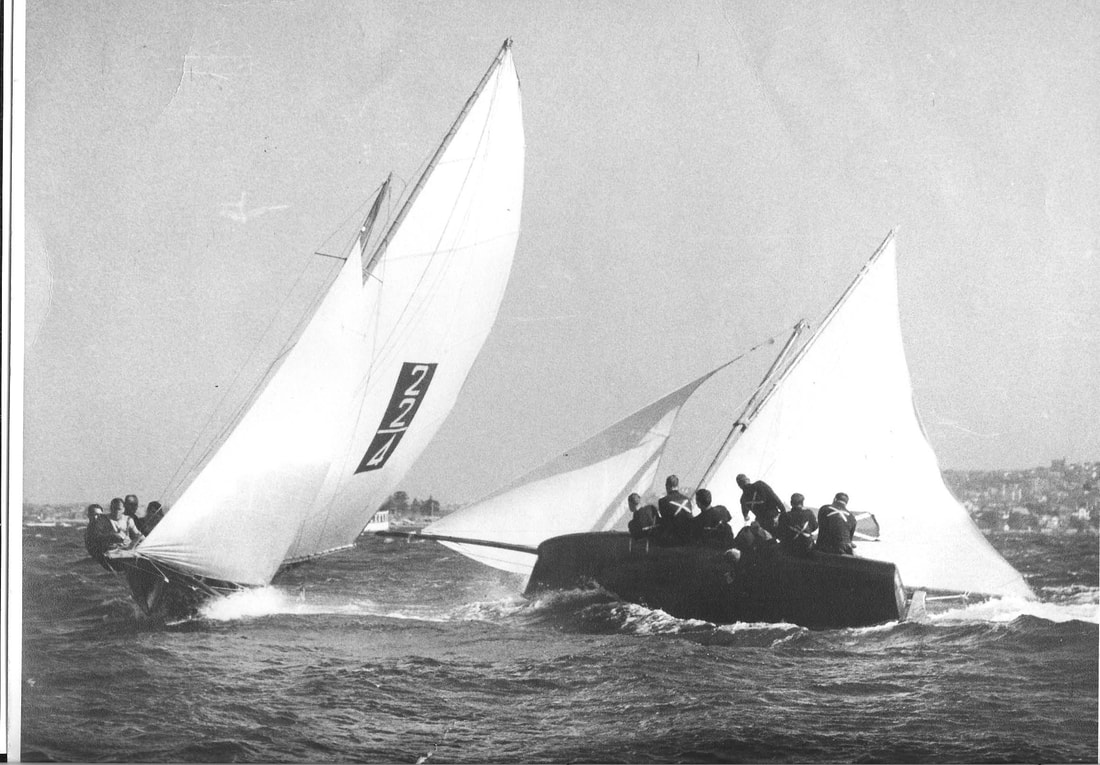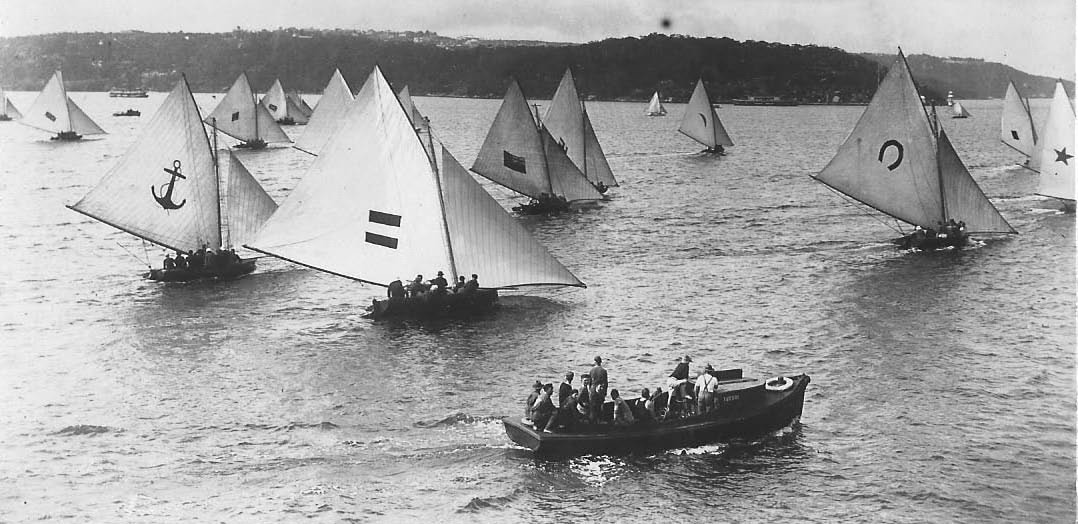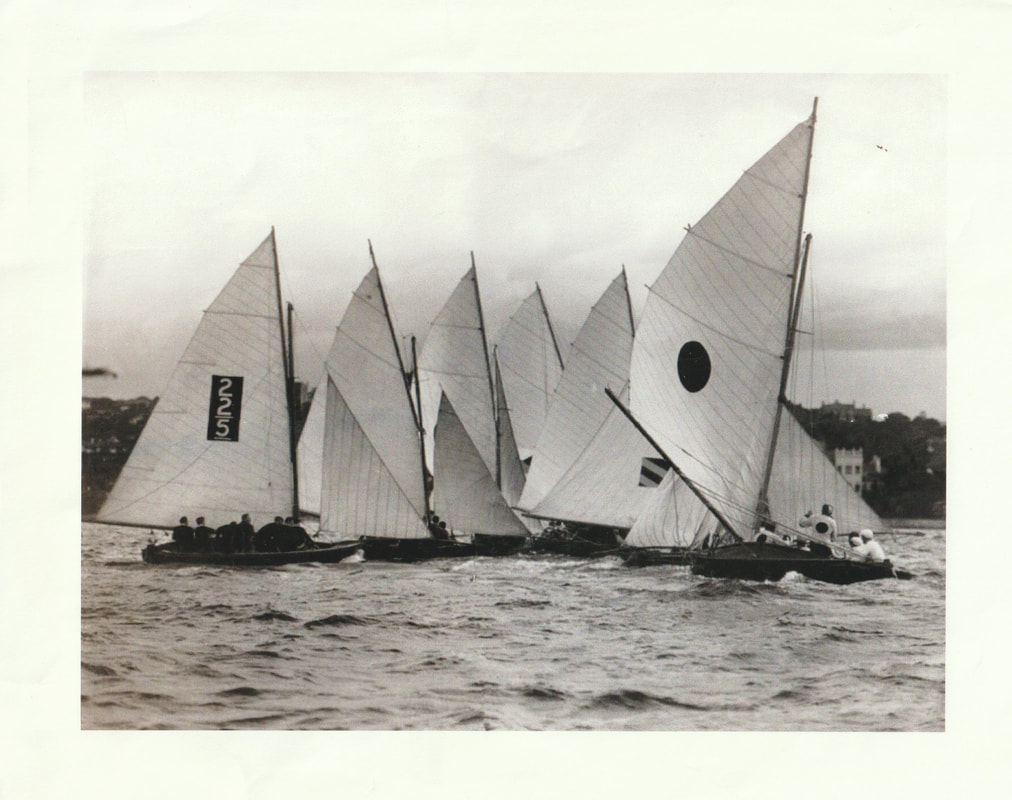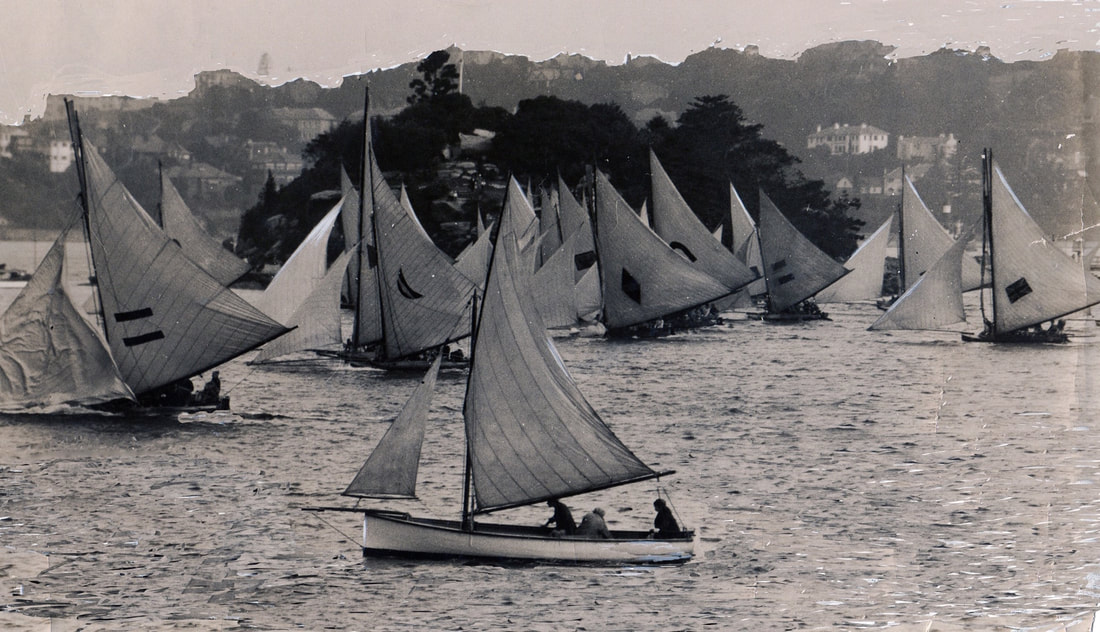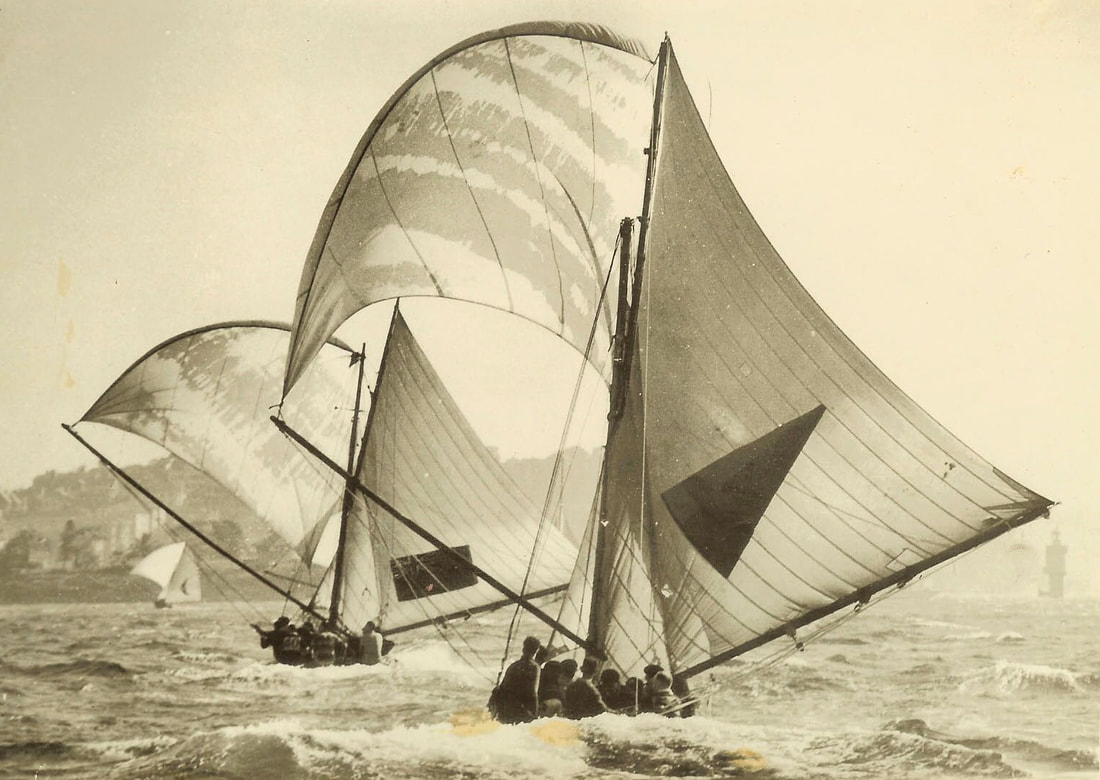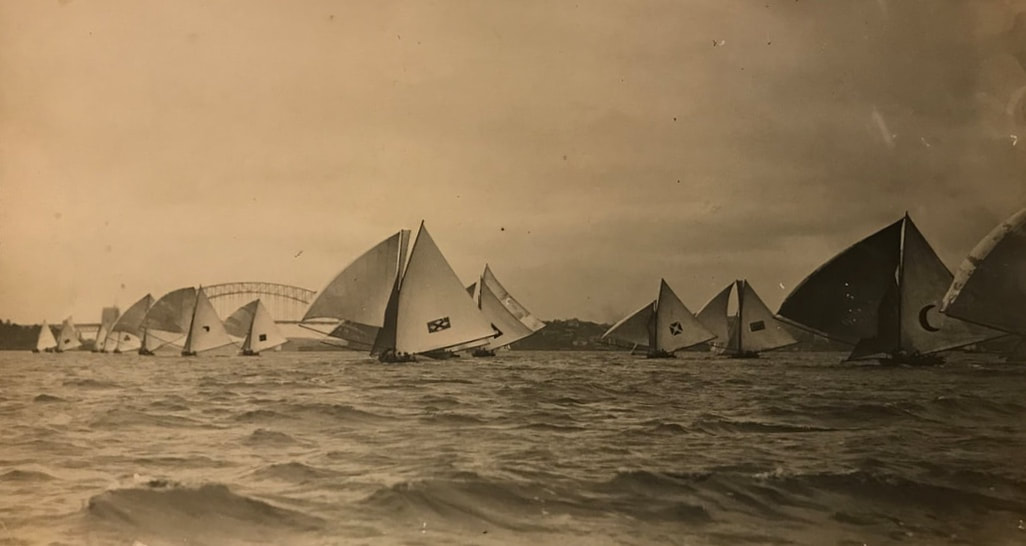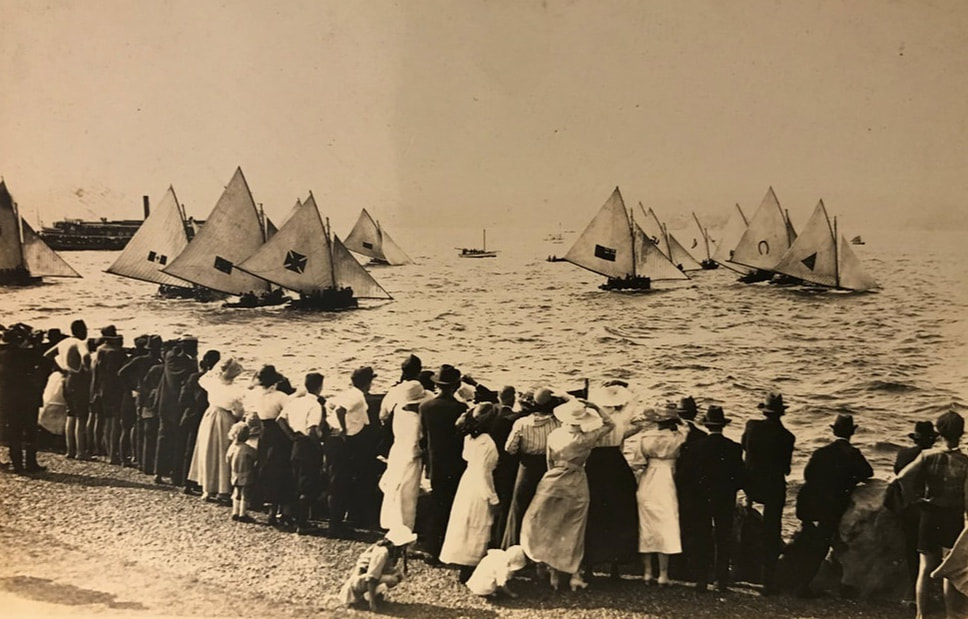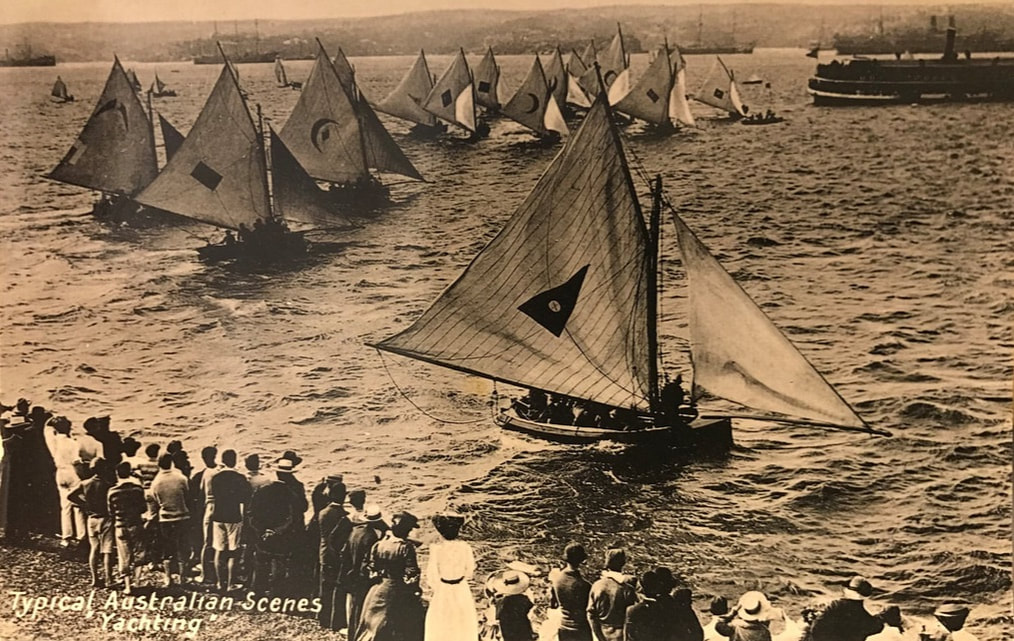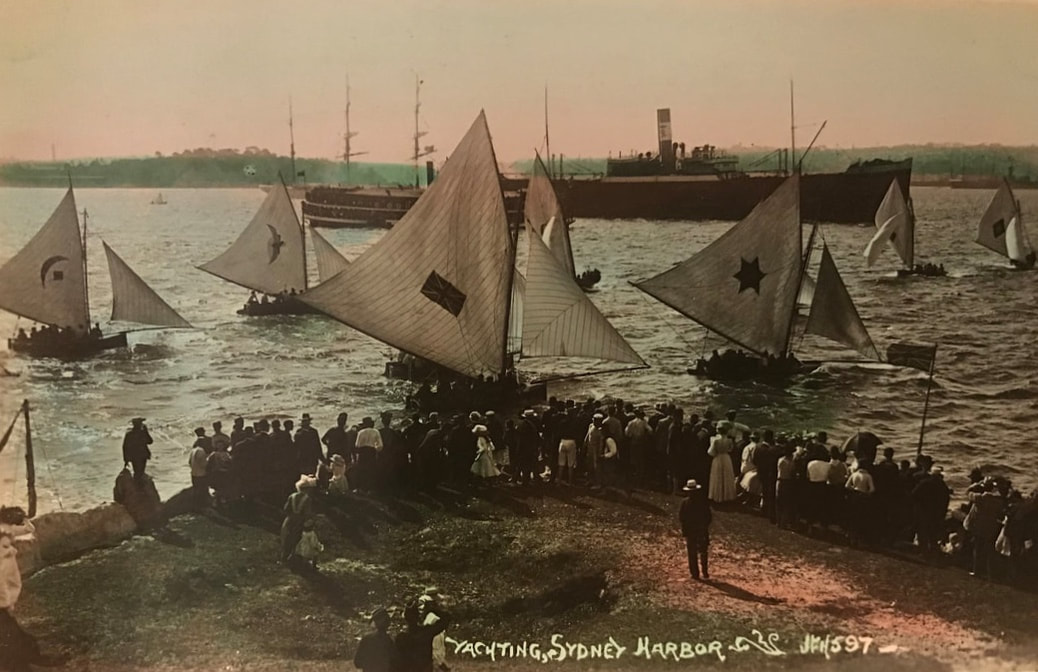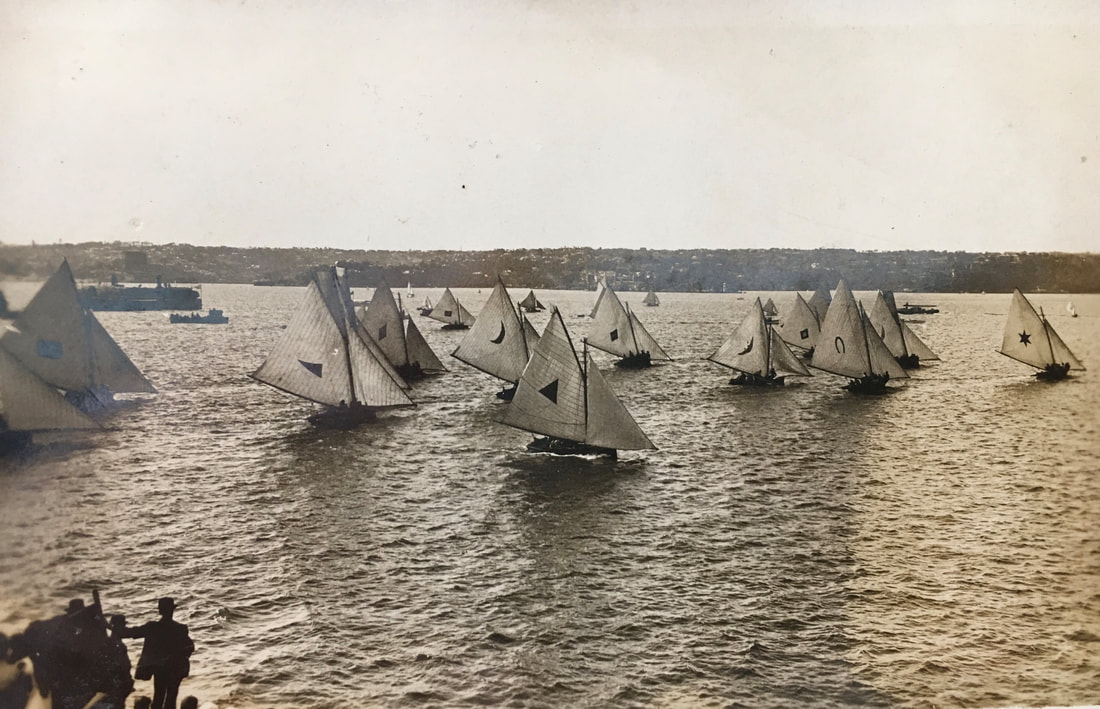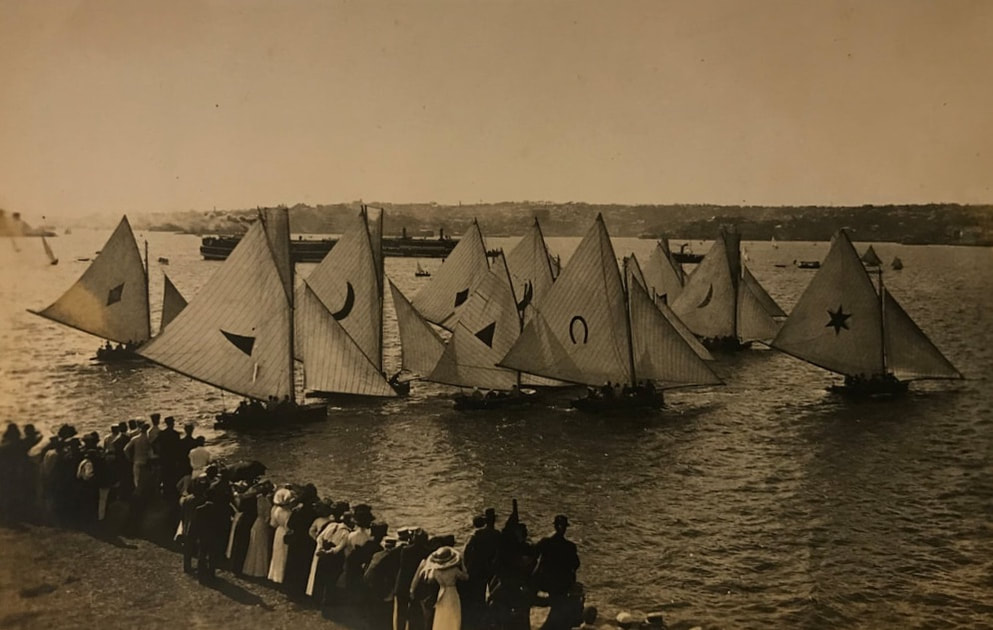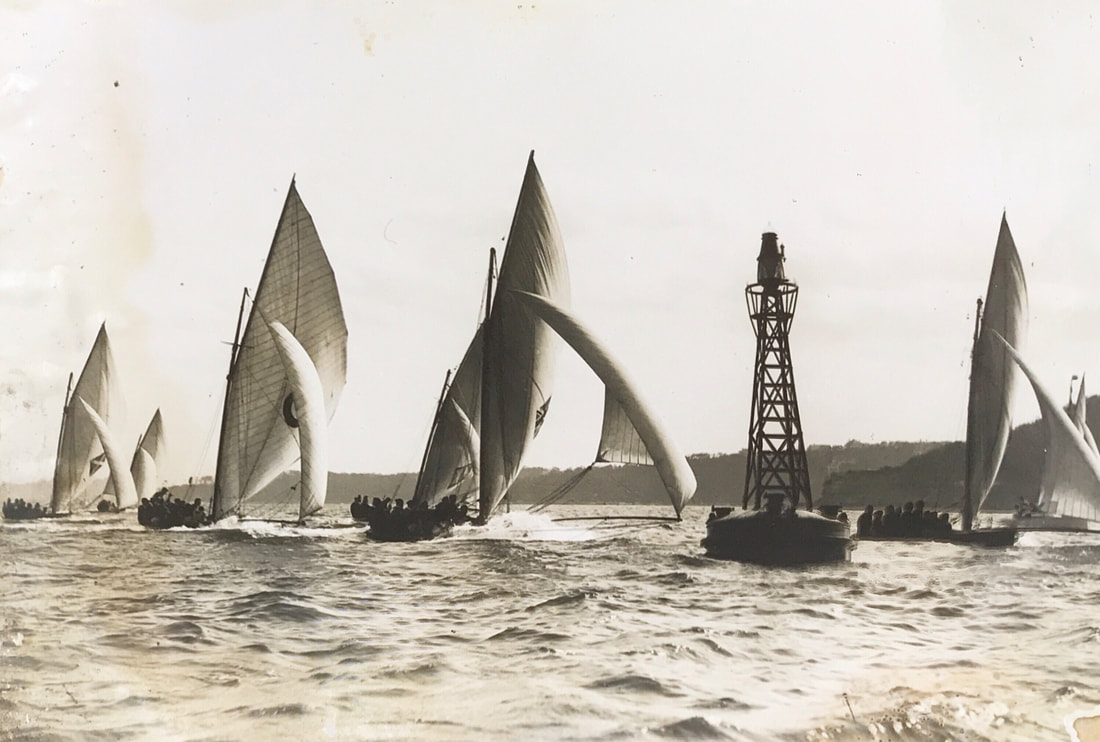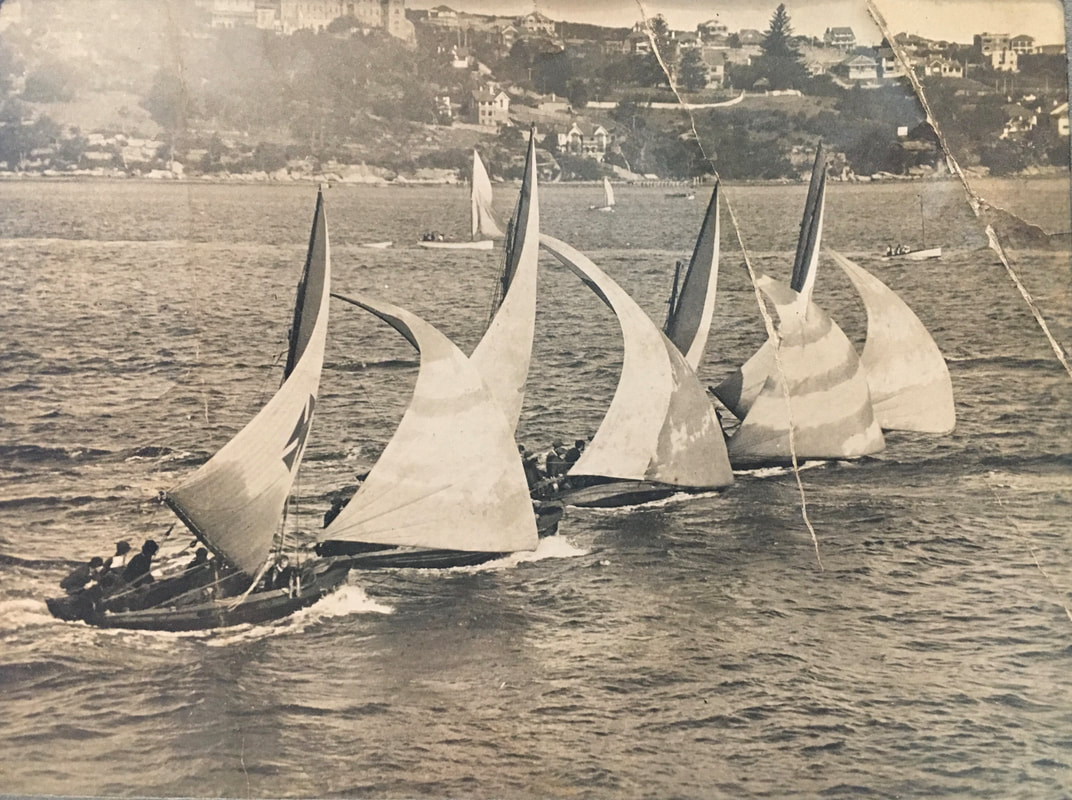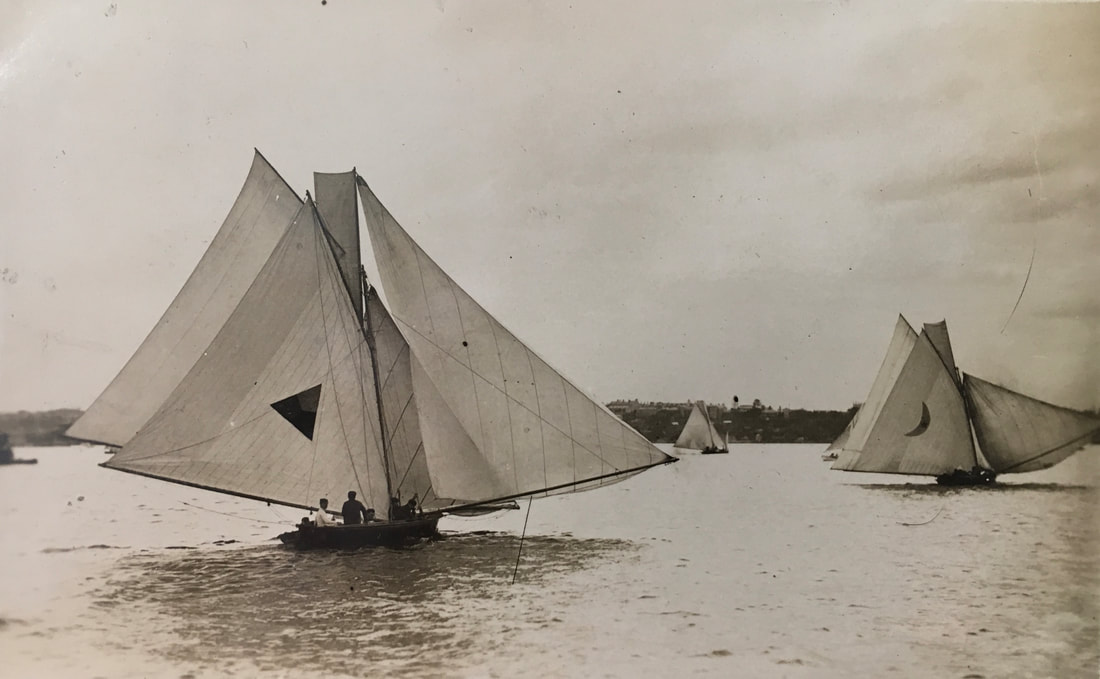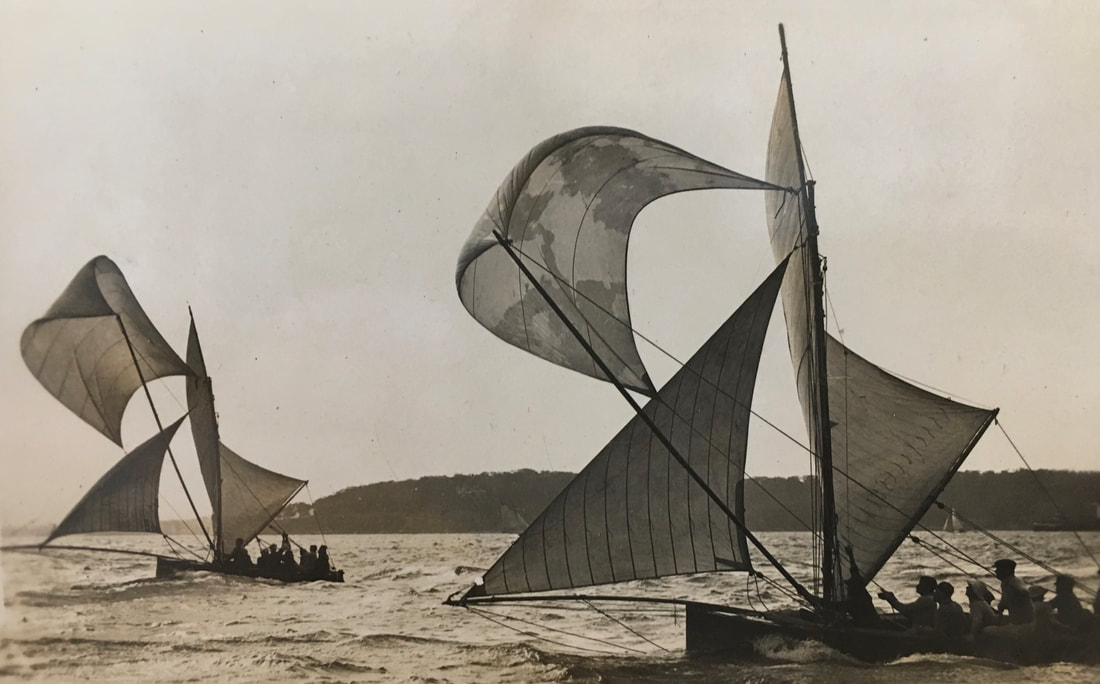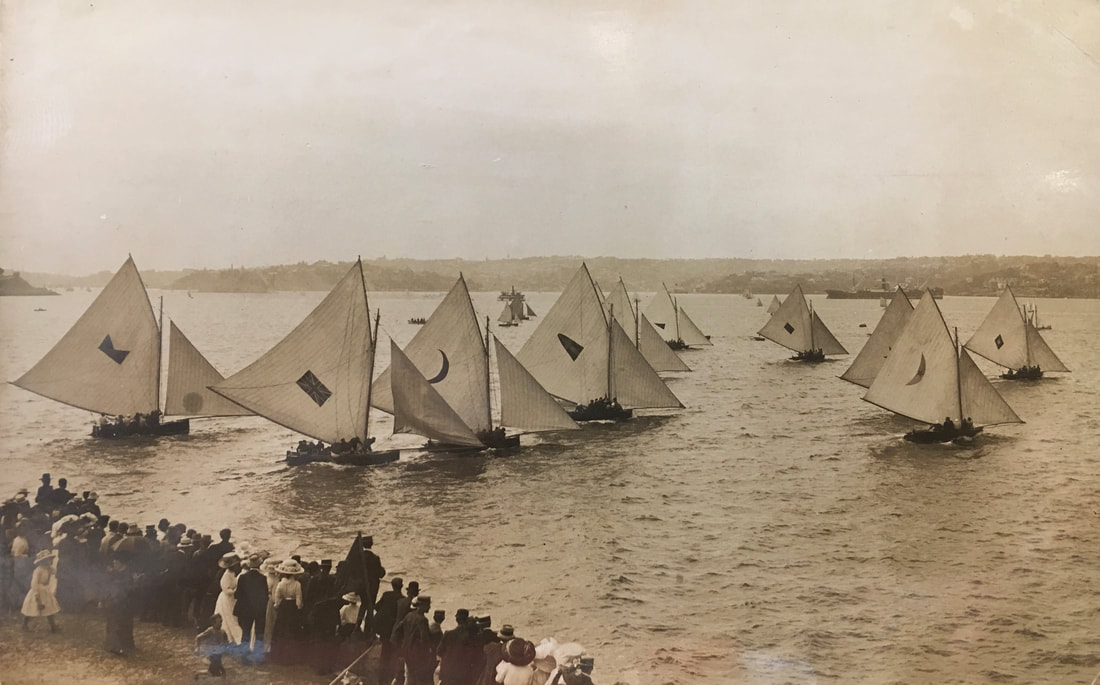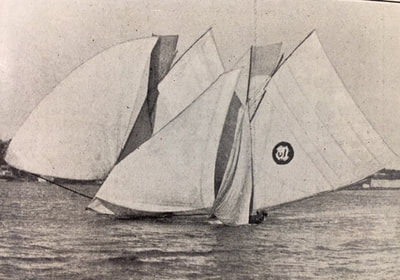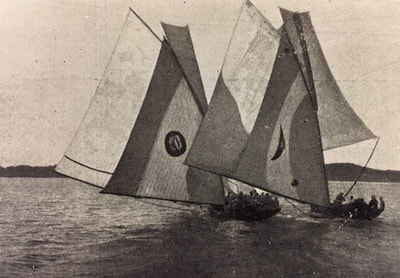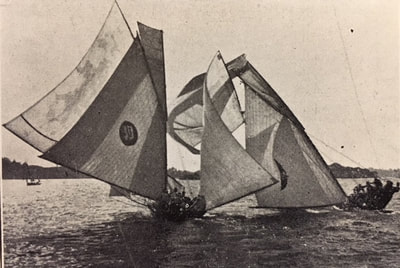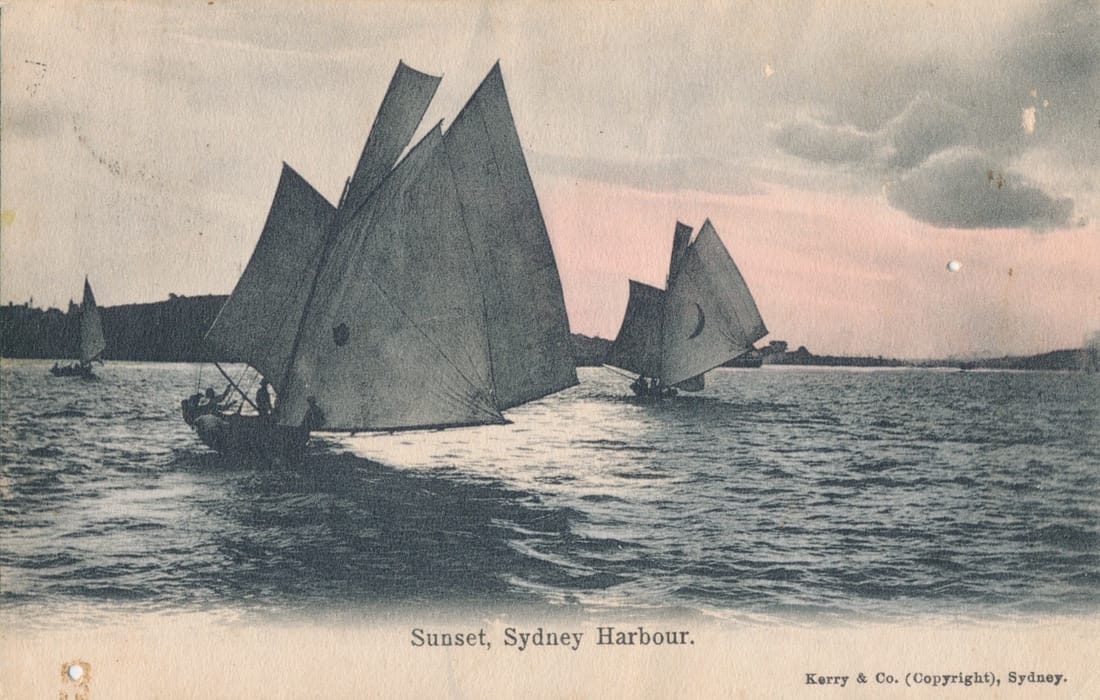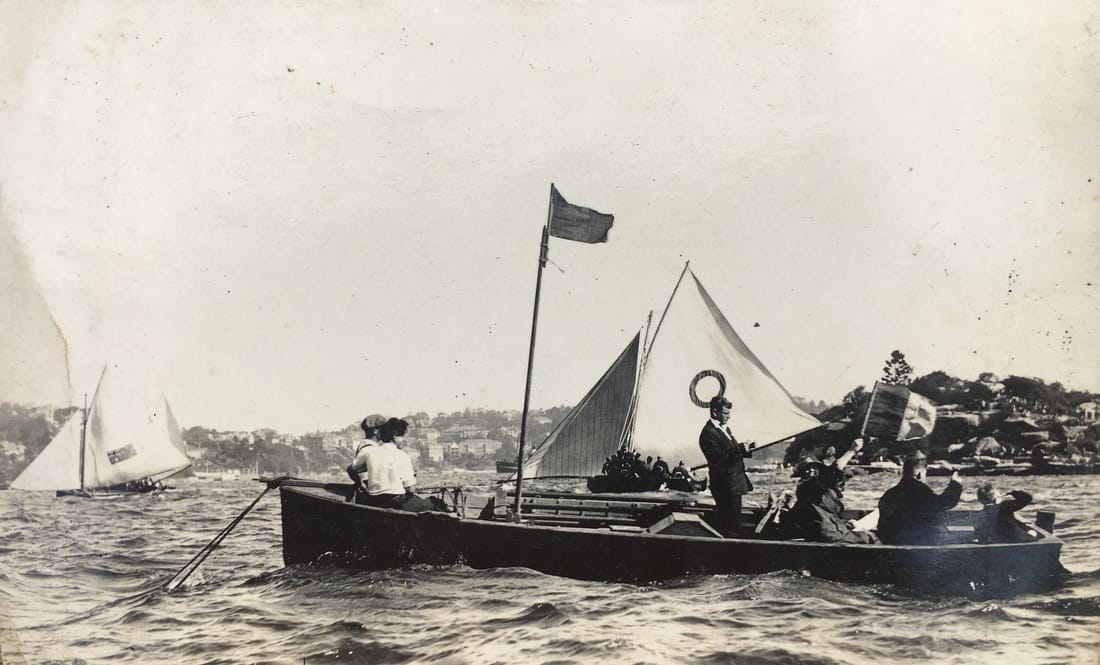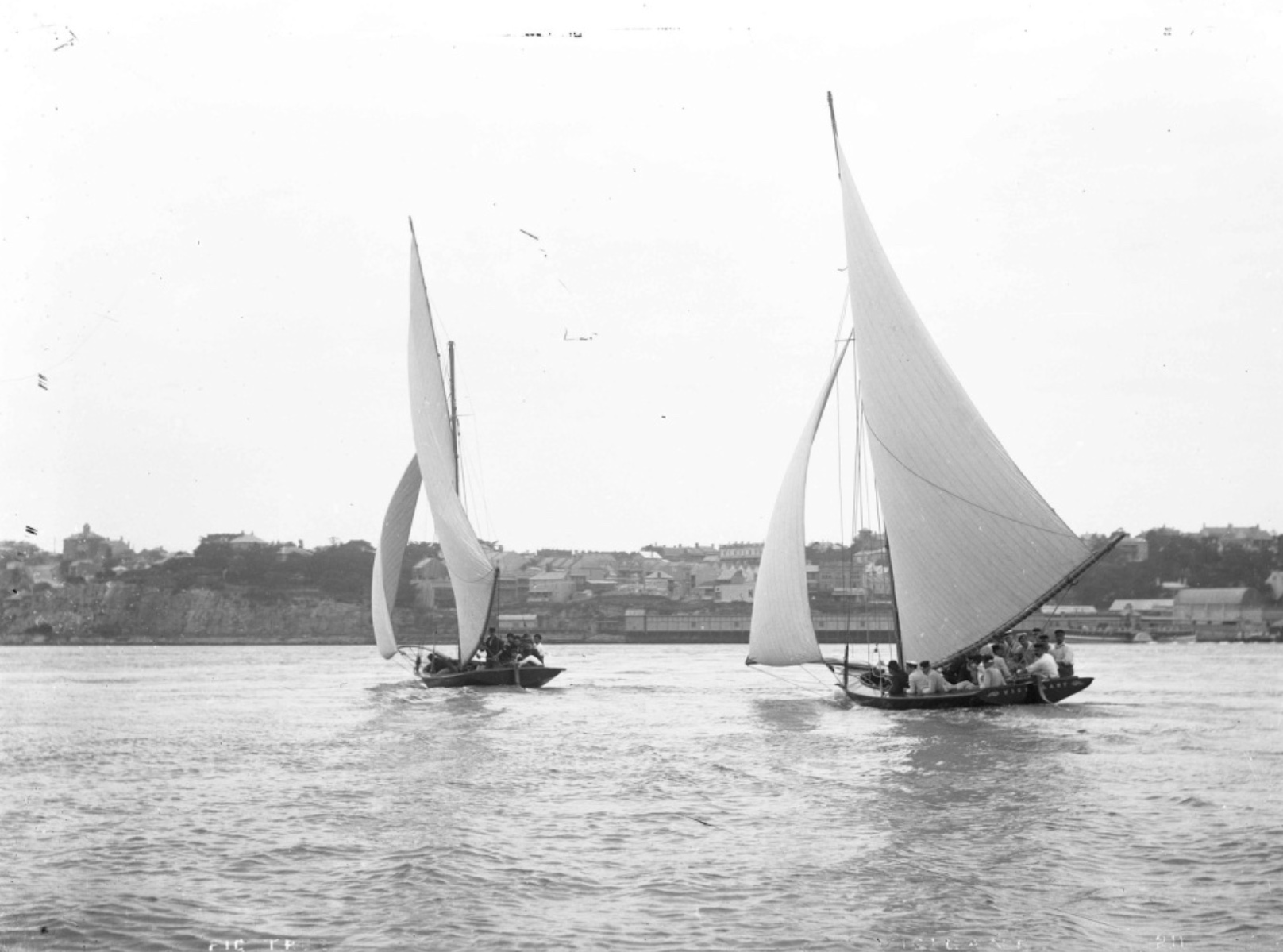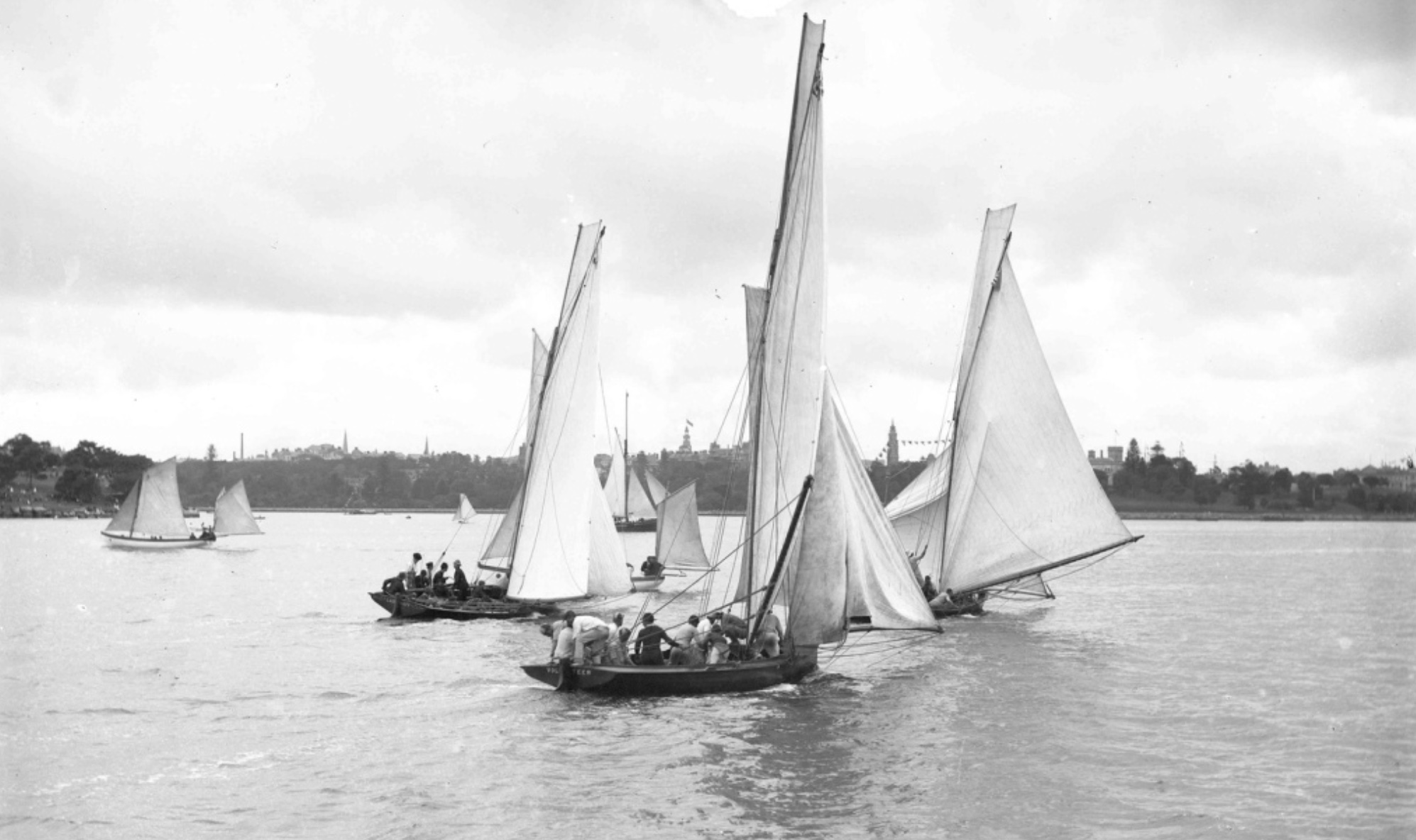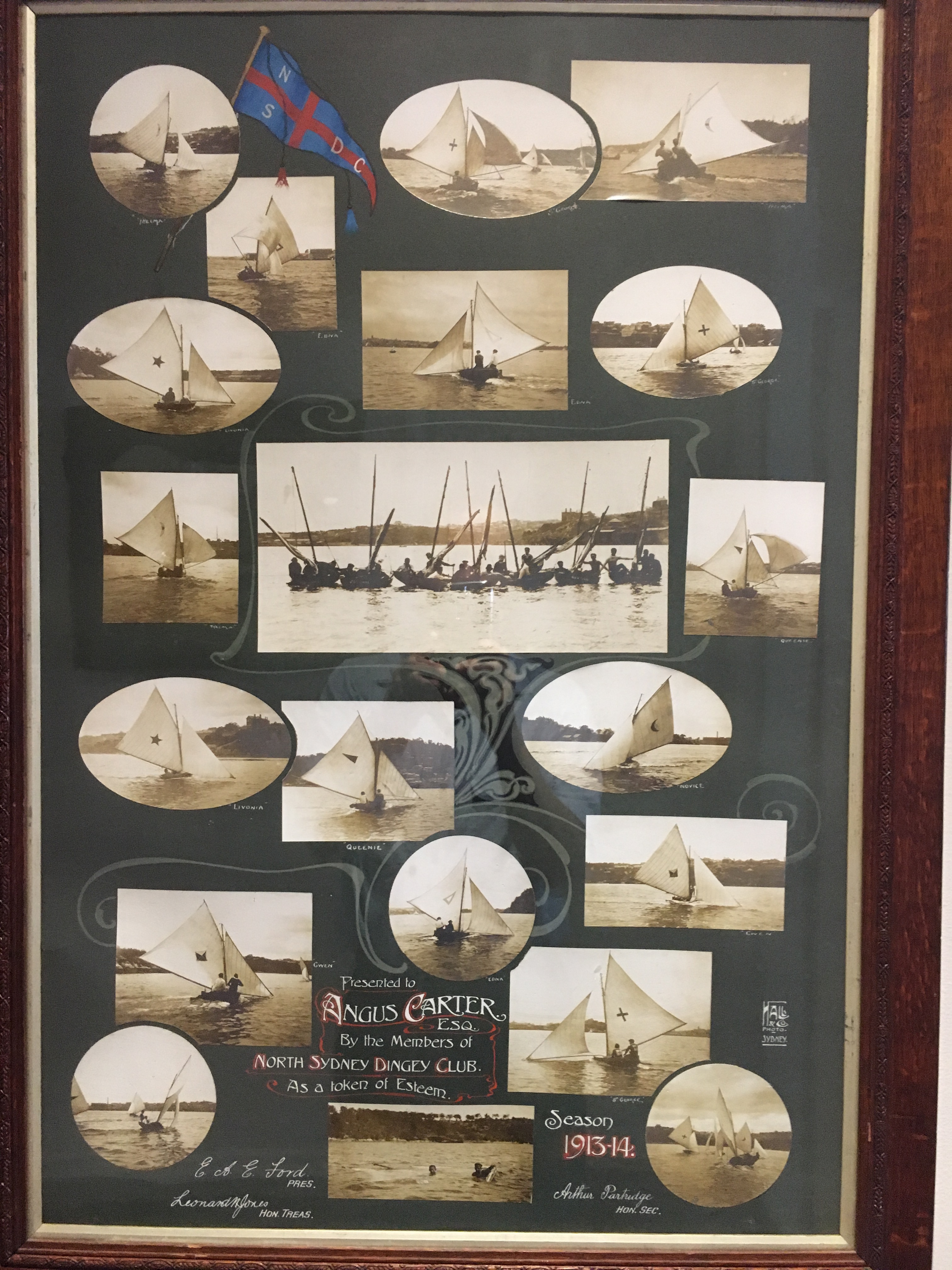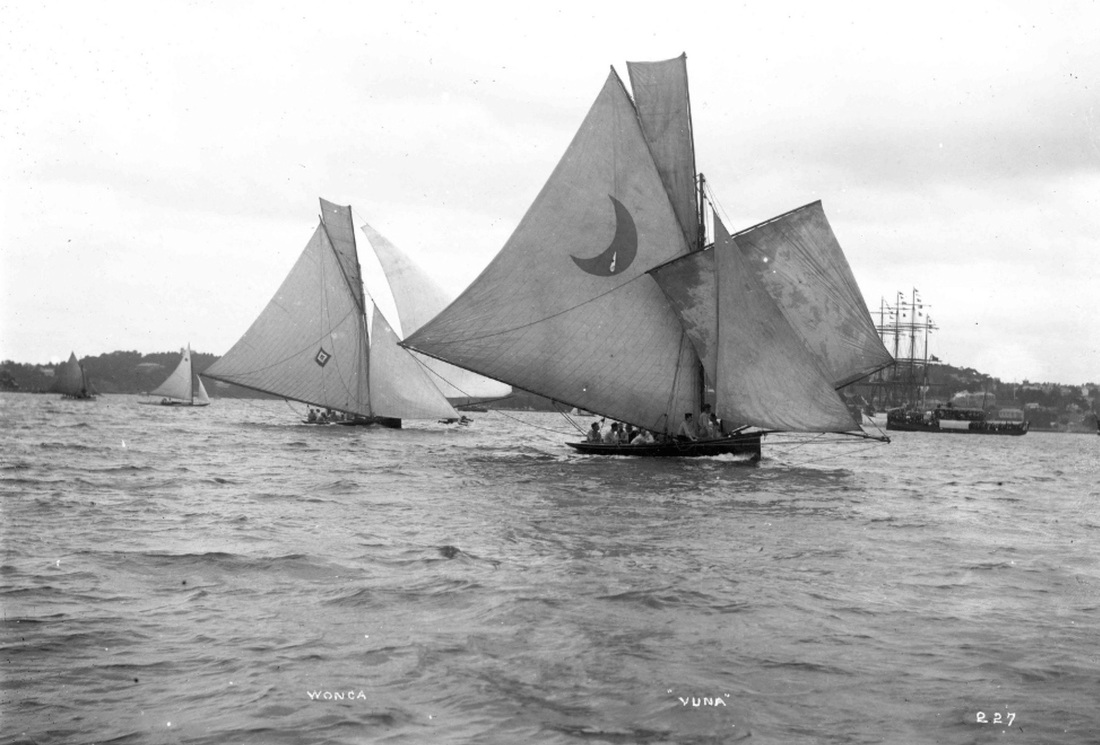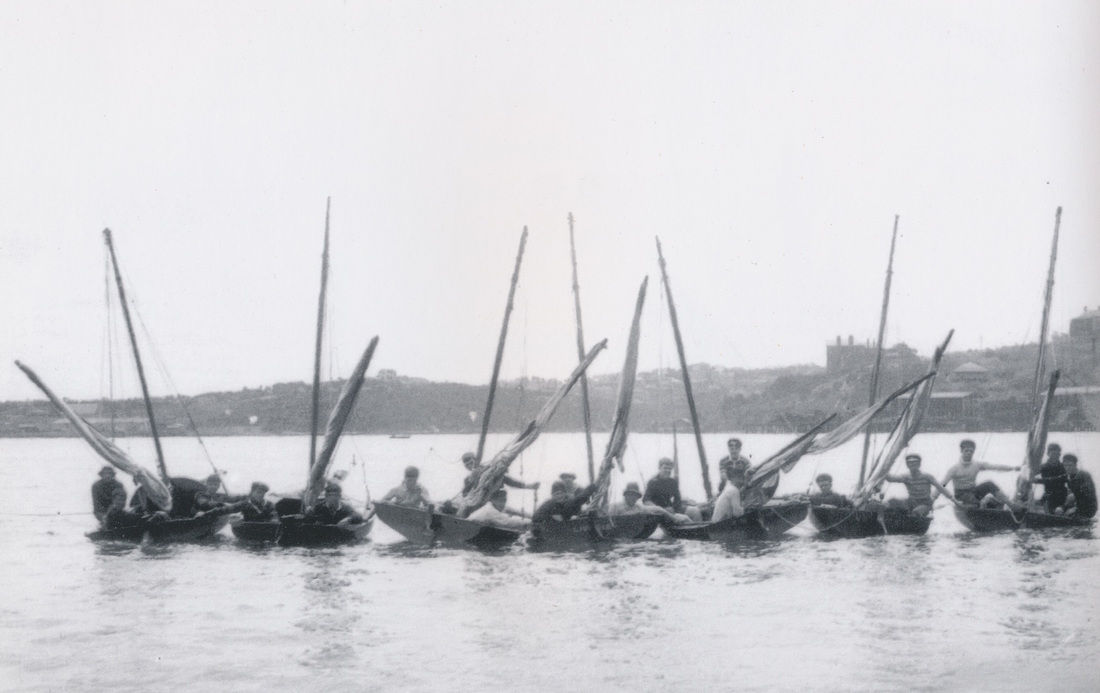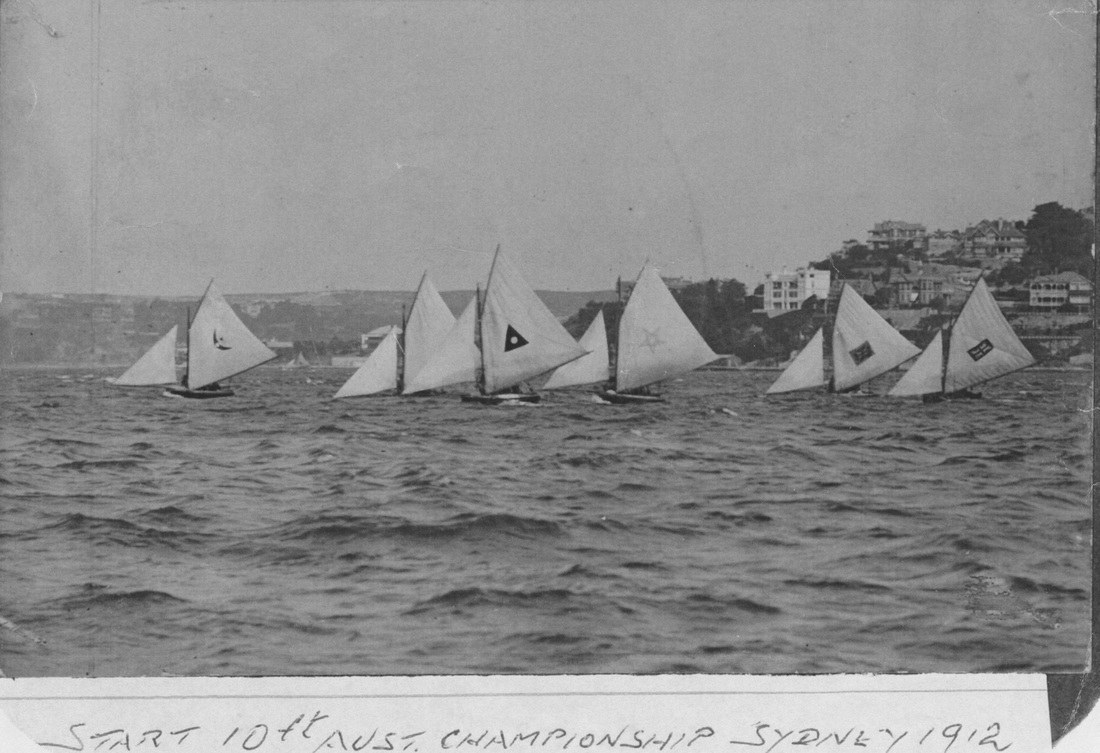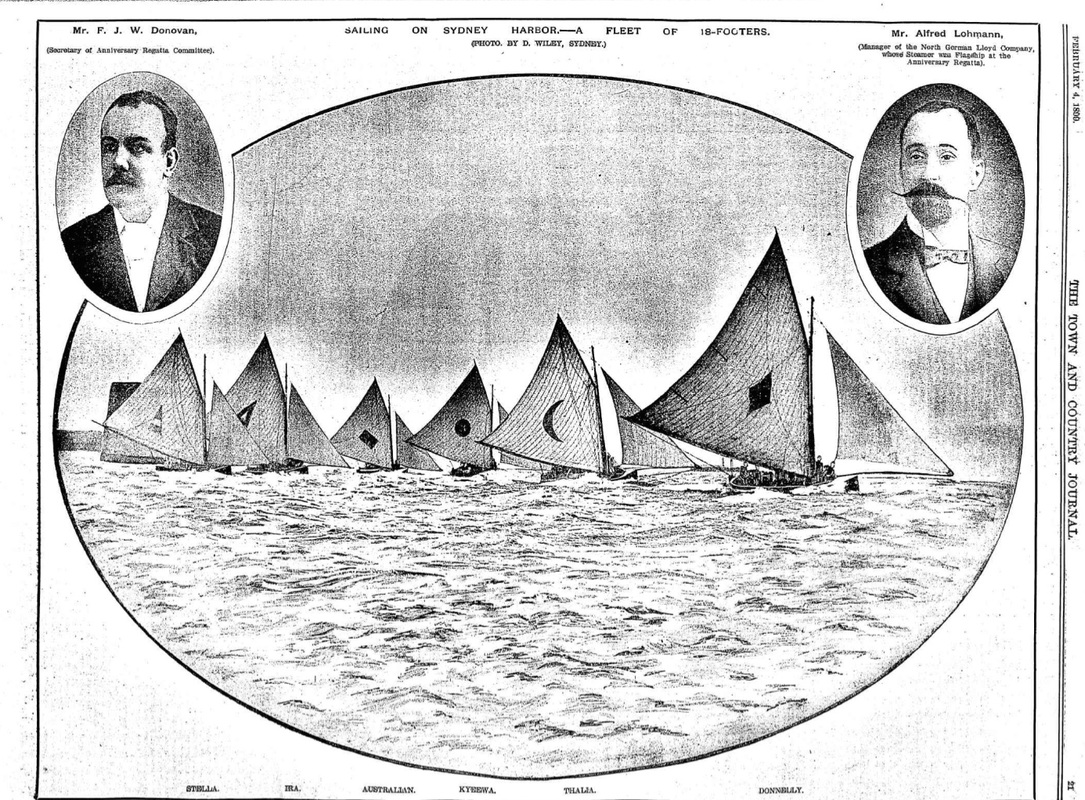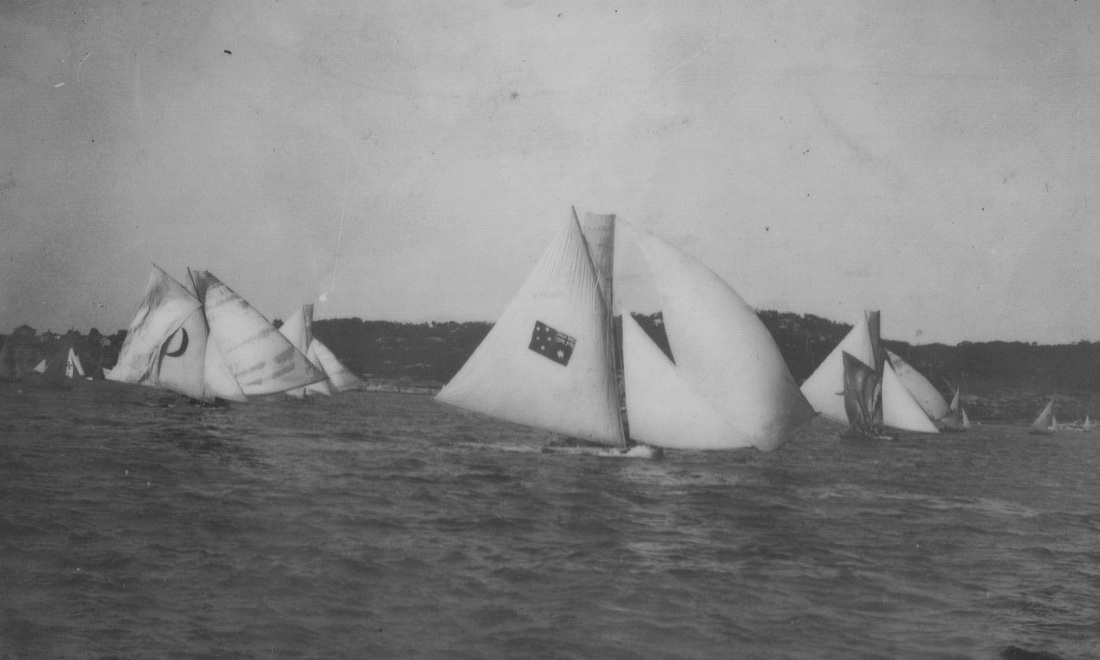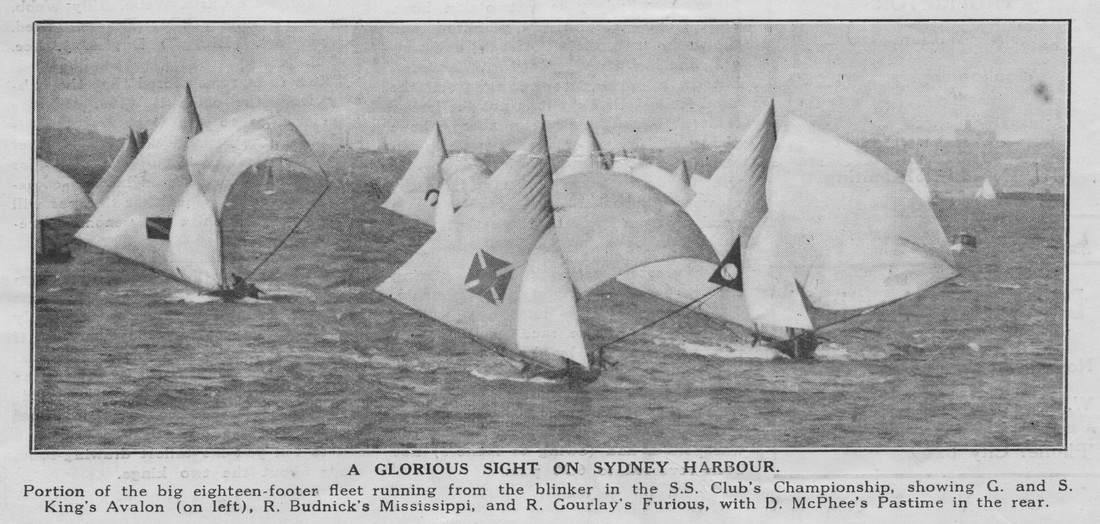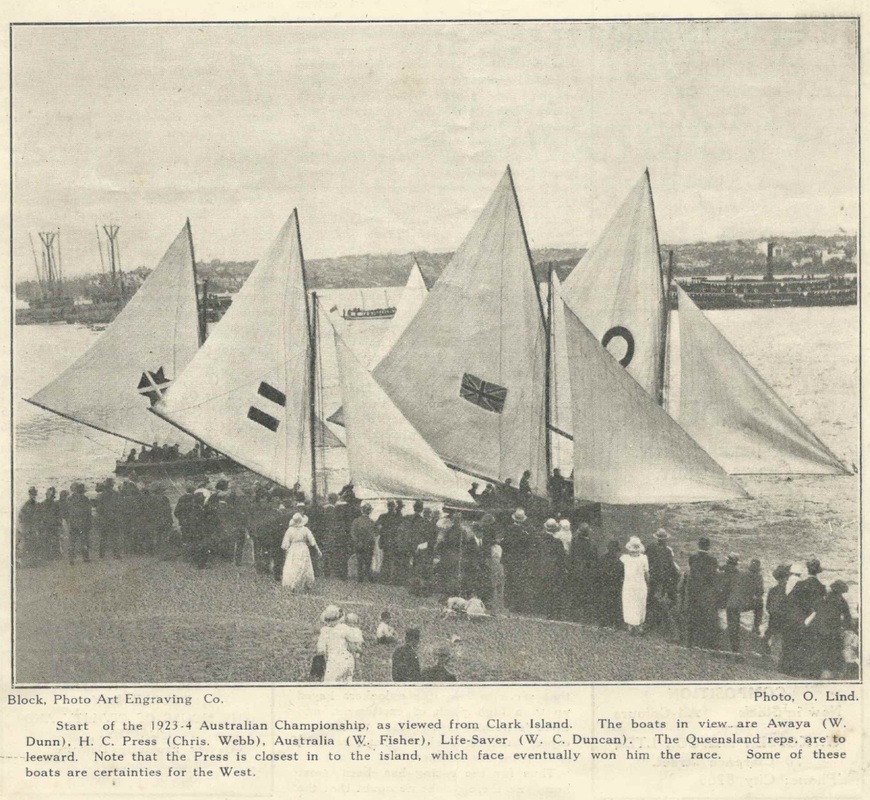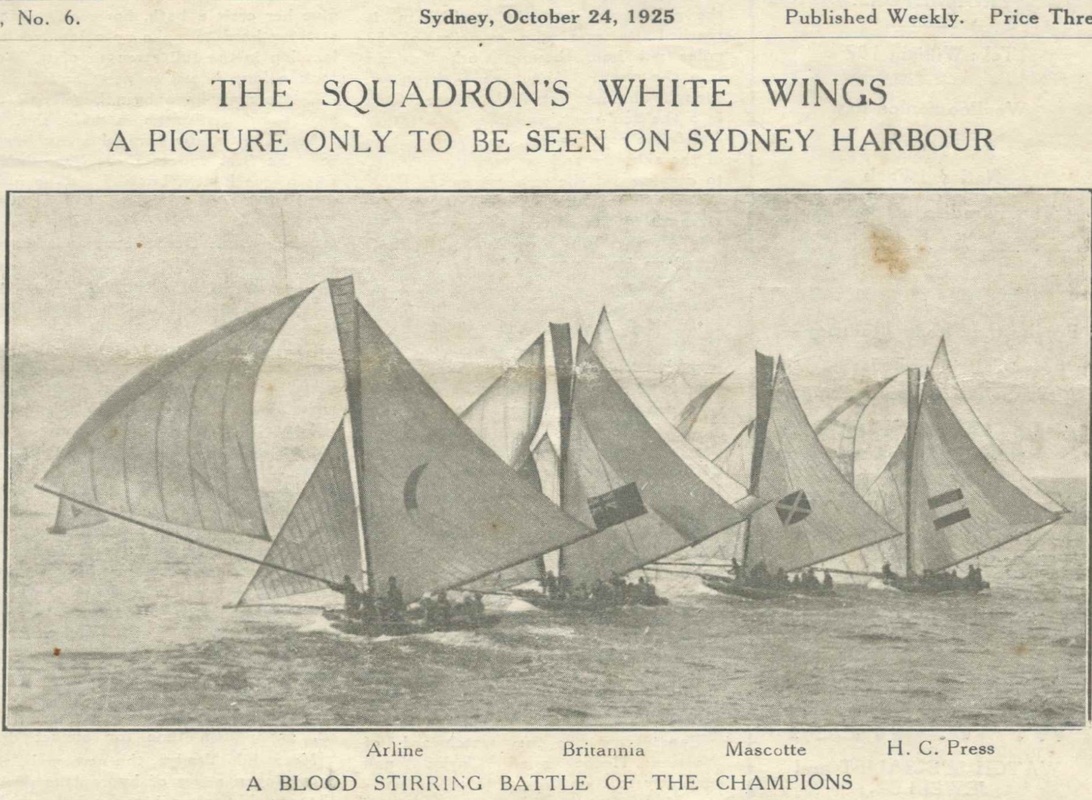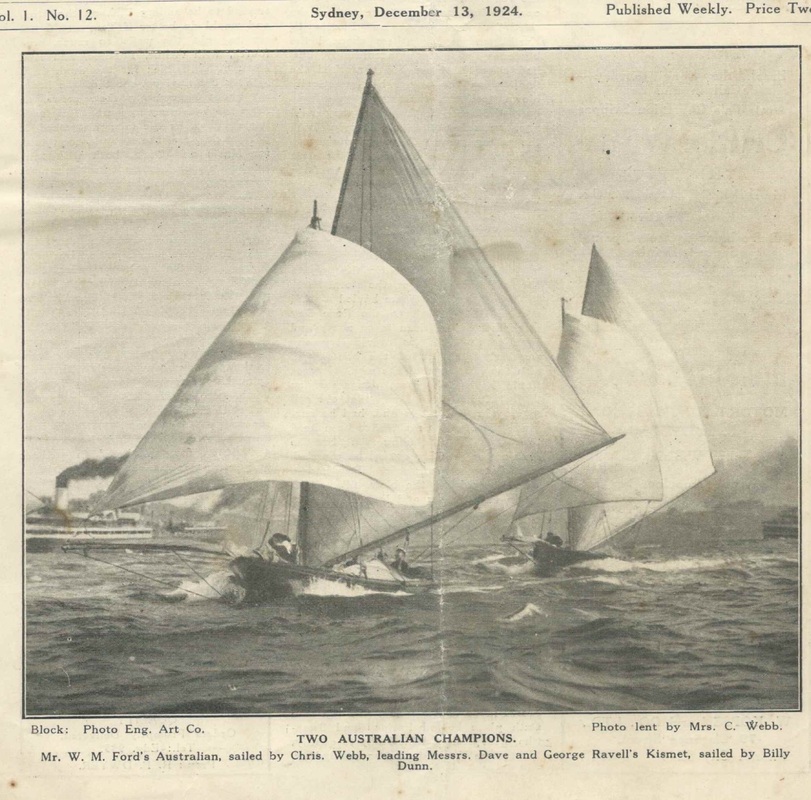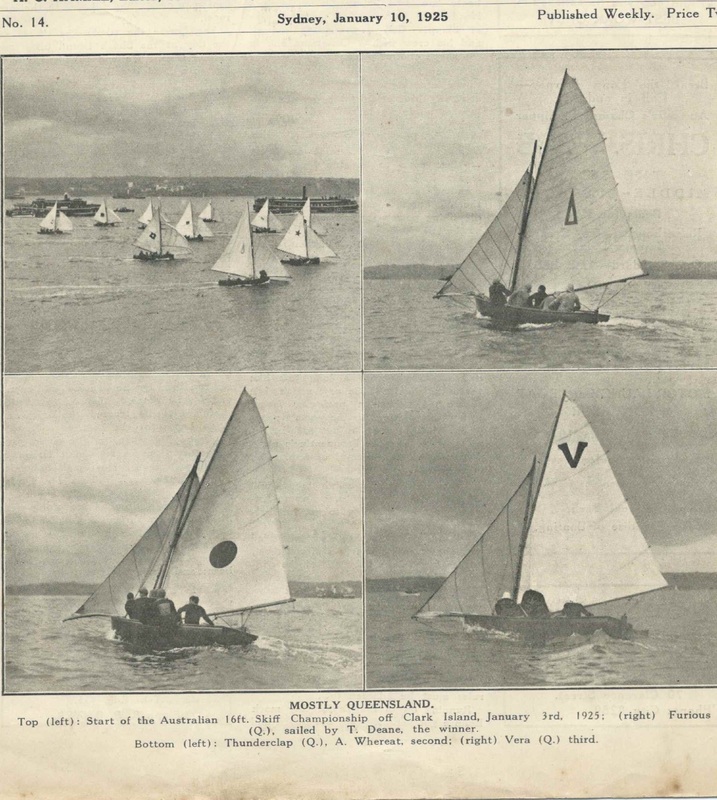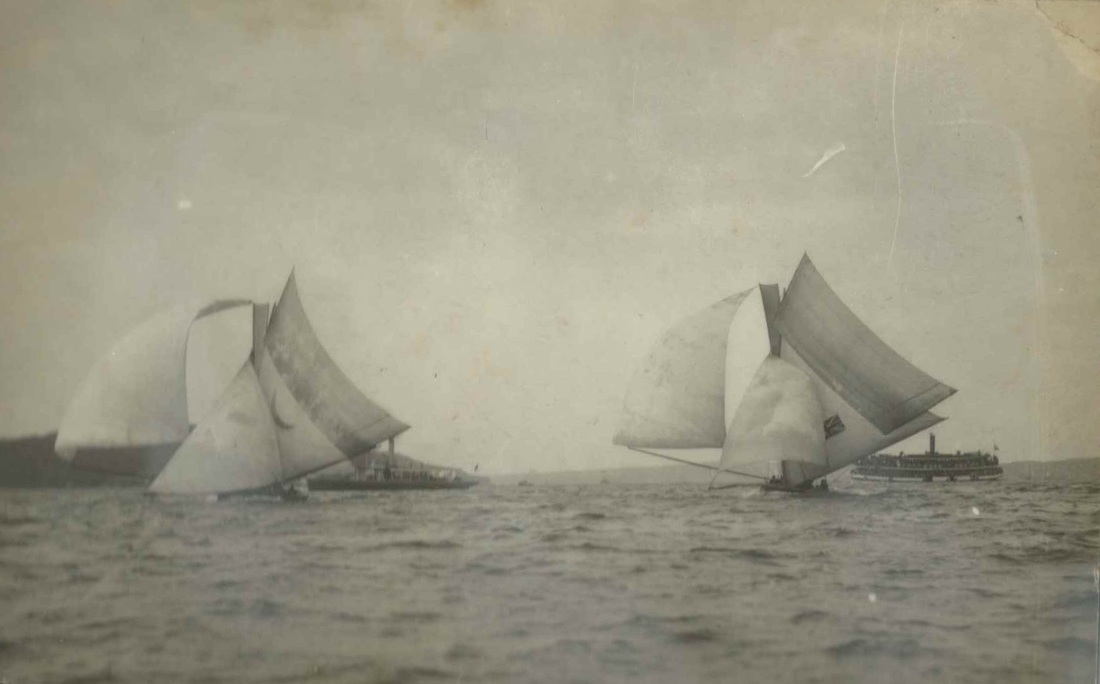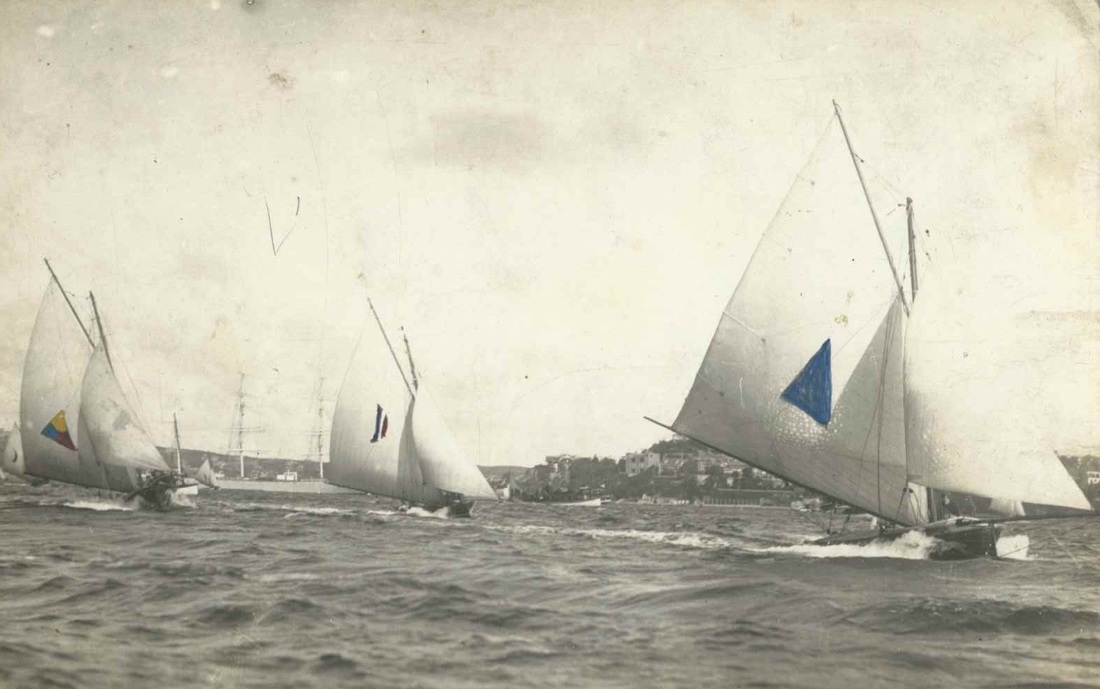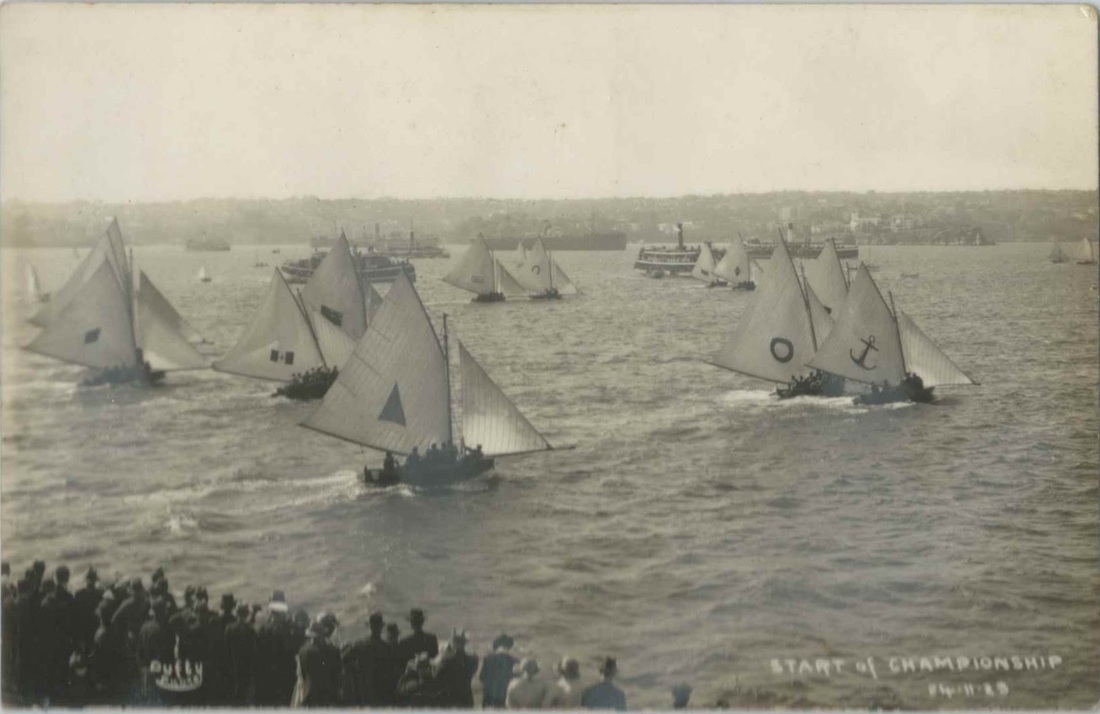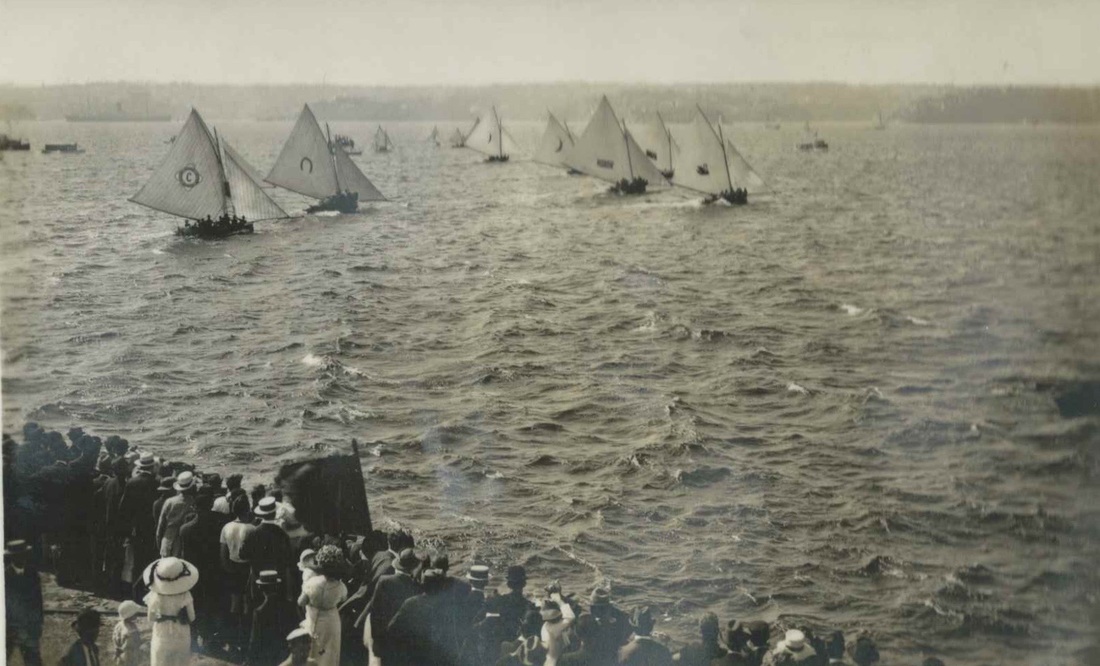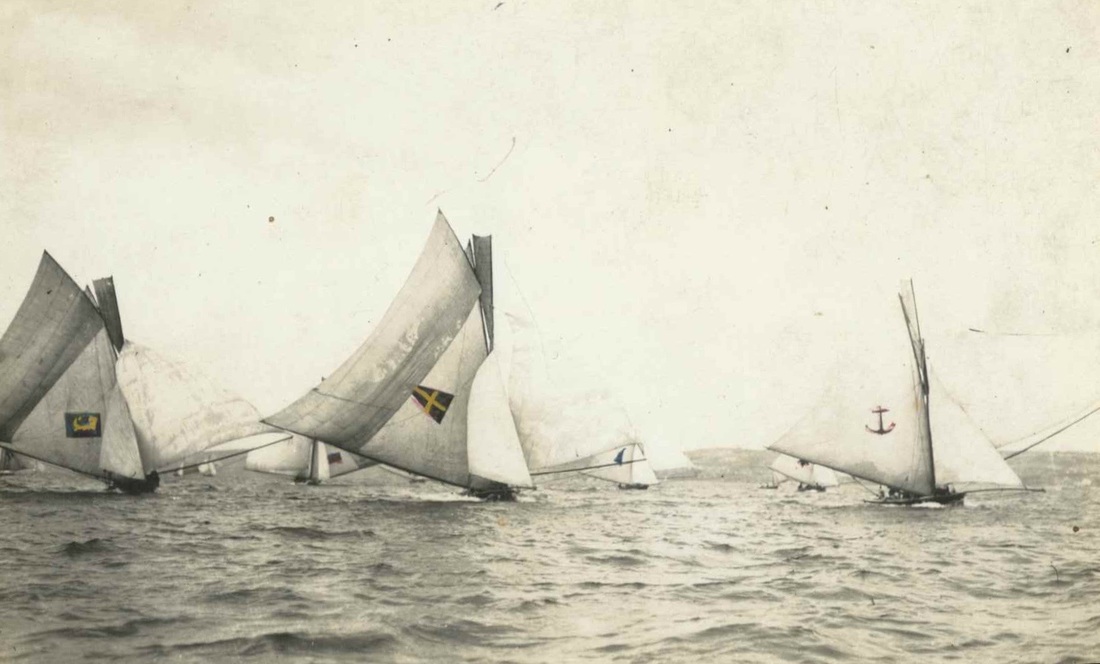A growing album of pictures of fleets of 18-footers and other Open Boats
18-footers KERIKI (left, with crescent insignia), MAVIS, MISSISSIPPI and KISMET race past a square-rigger off Point Piper, before 1927. All are carrying balloon jibs with their working jibs lashed to the bumpkin. Likely to be just before the finish just North of Clark Island. Hall Collection ANMM.
ROSETTA (left with red and blue ball insignia) and AUSTRALIA (Union Jack) reach into Rose Bay both carrying balloon jibs. Two other 18-footers can be seen in the distance ahead approaching the Shark Island rounding mark. Dates to between around 1927-28 and 1936. The Wintergarden Theatre can be seen at far left, and that opened in February 1928. Hall Collection ANMM.
BRITANNIA (left) and KISMET (right) are often mistaken for each other as their insignia are similar in black and white photographs. BRITANNIA displays the Red Duster, the British merchant marine flag with the Union Jack on a red field with no stars. KISMET displays the Australian Commonwealth flag with the stars on a blue field. In some images, like this one, the blue of KISMET's insignia shows up quite pale, on other images it can be quite dark. Hall Collection ANMM, 1920s.
18-footer CROWS NEST (Cliff Monkhouse) looms up on an unidentified boat off Taylor Bay, sometime between 1947 and 1953. Photo John Stanley Collection, originally from Cliff Monkhouse.
Two versions of the one shot
Two versions of the same image from the Hall Collection ANMM, the lower one is from a print in John Stanley's collection, the top image is from the Hall Collection original glass negative. The John Stanley print reveals that the Naval coal lighter MOMBAH is moored beyond the spectator ferry. This dates the image to between 1923 and 1930, so the boat with the circle insignia could be either LIFESAVER (1923-1927) or ARAWATTA (1927-1930). The only other boat I can positively identify is PASTIME with the red horseshoe.
A short sequence from the 1920s
Mascotte (AUSN flag) and Kismet (Commonwealth flag) sail past sail training ship Tingira anchored in Rose Bay. Must be between 1918 and 1927. Hall Collection ANMM. The next two shots were taken just a few seconds later.
A Big Westerly- Saturday 27 October 1928
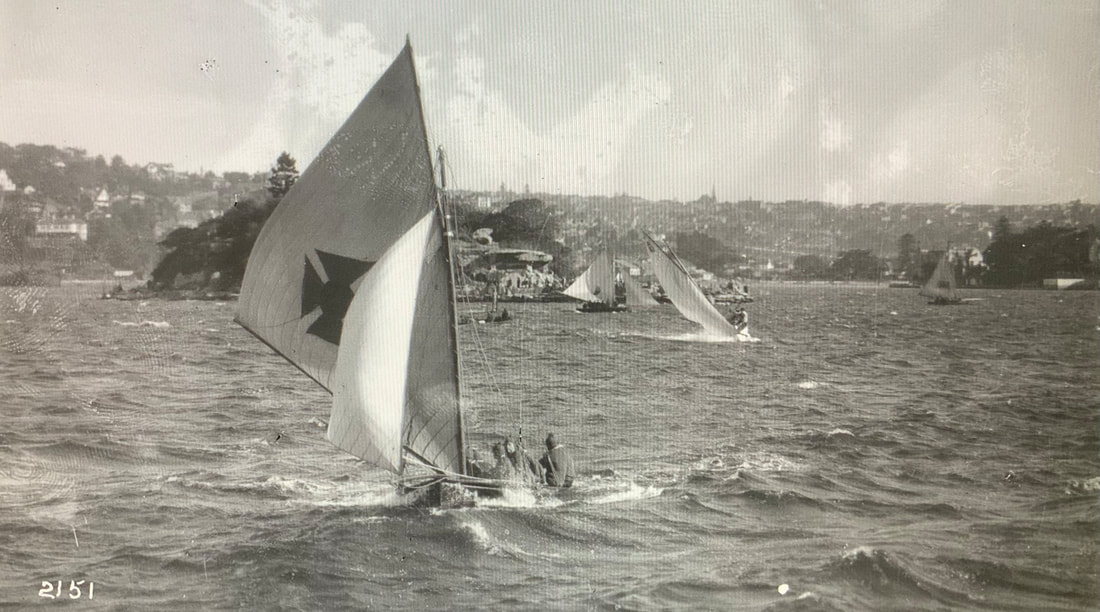
The William Hall Collection of photographs at the Australian National Maritime Museum has rendered up another great sequence of images from the one race, this time in a howling Westerly in 1928. The above photo shows Mississippi underway in the first heat starting North West of Clark Island as usual, and reaching or running to a buoy off Nielsen Park. It’s actually most likely that this is just before the race start, with Mississippi checking out the track, as Rosetta can be seen back closer to the Island with Australia who has not yet hauled up their jib. It seems likely the race has not started because Mississippi was off 2 minutes as was Rosetta, and Australia was off 1 1/2 minutes. It is also possible that some shots may be from other days in that season (or even another season) as there was a strong Sou-Westerly the week before , and other Westerly days. But the images were all grouped together in the Collection, with consecutive Museum numbers and closely-grouped numbers written on each glass slide. The numbers however are clearly out of sequence, and I am convinced that the numbers were added by the Mitchell Library who had care of the Collection for many years, and do not designate the order in which they were taken.
Around this time just under half the races conducted during a season were run in two heats and a final, each being raced once around a triangle of 3 or 4 miles. Half the fleet would be in each heat, usually around 10-13 boats. The second heat would start shortly after the first. The first six or so boats in each heat would go into the final. There was prize money for placings in both heats and final.
As you will see, the photos fit the description of the race on that day, with all group shots showing boats that were either in the same heat or in the final together. It was a bit of a detective story to put together. Overlapping careers of the boats pictured meant that it had to be from 1926-1932. I searched TROVE for 18-footer, Westerly, DEFIANCE and capsize, for those years and with just several different days from which to choose, 27 October 1928 was the one that fitted. And then I noticed the early construction of the Southern approaches to the Sydney Harbour Bridge at the right of this shot of H C Press which a bit of research showed to be from late 1928.
Above: The breeze does seem a bit lighter here so it is possible this is from another day, but on Sydney Harbour Westerlies are always up and down! HC Press broke their mast and capsized on the third leg thrash to windward in Heat one.
Below:Australia and Rosetta are close reaching from the Nielsen Park buoy to Shark Island, on the second leg of the first heat.
Below:Australia and Rosetta are close reaching from the Nielsen Park buoy to Shark Island, on the second leg of the first heat.
Below: Defiance (black crescent) and Gloria and distant right Mississippi also on the second leg of the first heat.
Above: Rosetta coming last on the thrash to windward to finish the first heat.
Below: This shot could be from either heat or even the final as I can’t positively identify any of the boats. They are approaching the Shark Island pile before the beat against the Westerly to the finish line North of Clark Island.
Below: This shot could be from either heat or even the final as I can’t positively identify any of the boats. They are approaching the Shark Island pile before the beat against the Westerly to the finish line North of Clark Island.
Above: Defiance capsized spectacularly according to reports, just after the start of the final. The boat picking up crew was the launch which the SFS used. It appears in other images about the same period (there is a photo in the Daily Telegraph 20-11-1927 identifying it as the SFS launch), but its name as yet escapes me. Anyone?
Below: I know this shot (closeup of the previous shot) is of the crew of Defiance as they are wearing their distinctive white jerseys with a V, and matching white beanies with pom-poms, which show up in other images, and for which they receive much derision for their “beach
pyjamas”. They also capsized the previous week just before the start, so it is possible that this is actually taken on that day.
Below: I know this shot (closeup of the previous shot) is of the crew of Defiance as they are wearing their distinctive white jerseys with a V, and matching white beanies with pom-poms, which show up in other images, and for which they receive much derision for their “beach
pyjamas”. They also capsized the previous week just before the start, so it is possible that this is actually taken on that day.
Above: This shot has Pastime running in the first leg of either the second heat or the final. There is one problem with this image however, I do not recognise the insignia on the boat to their right, it appears to be a crescent with 2 bars, but I can find no record of such an insignia, and certainly not in the race described.
Below: This one is more certain. The boats pictured and their positions matches the description of the first leg of the final, with Furious (far right with triangle and ball insignia) described as leading the fleet to the Nielsen Park buoy. Rene is at left with pennant, Arline with diamond and bar, Mississippi with Maltese cross, Advance with blue and gold bars, Cutty Sark with cross and diamond on rectangle.
Below: This one is more certain. The boats pictured and their positions matches the description of the first leg of the final, with Furious (far right with triangle and ball insignia) described as leading the fleet to the Nielsen Park buoy. Rene is at left with pennant, Arline with diamond and bar, Mississippi with Maltese cross, Advance with blue and gold bars, Cutty Sark with cross and diamond on rectangle.
Above: This is most likely the final, with Mississippi distant left trailing two unidentifiable boats. Mississippi was 2nd in her heat, and 5th in the final.
************************************************************************************************
************************************************************************************************
A photo sequence featuring the North Coast Champion 18-footer Hastings in Sydney in 1923
The Hall Collection at the ANMM has revealed another sequence of images all taken on the one day. Prominent in several shots is the Port Macquarie 18-footer Hastings, built in 1922 and shipped down to Sydney on 6 February to take part in several races, including the NSW Championship on 17 February. These images are not from the Championship because in that race Hastings retired before the first mark, and the images show her on the run, the second leg. They are not from the first race on 10 February because it was run in two heats around a short course, and these images are of the whole fleet on the long course. So it has to be the Sydney Sailing Club race on 24 February, because Hastings was shipped home after that. She was apparently only seen in Sydney again in the 1927-1928 season when Tom Young and Wal Keddie chartered her for the season. The images cannot be from that season because several boats pictured had ceased racing by then.
The race was run over the Georges Head light course, similar to the Sow and Pigs course except the top mark is further West. The fleet is running due South towards Shark Island. The boat closest to camera is Hastings (insignia revealed in the third shot). Golding is next with P&O flag insignia. Keriki’s two-tone crescent can be seen between these two. Reports indicate that Desdemona (off 5 1/2 minutes) and possibly some other long markers have already passed the camera boat.
Taken very shortly after the first shot, showing the same boats, but HC Press one of the scratch boats with two red bars can be seen mid-right. The numbers written on the glass negative slides are out of sequence, I believe they were put there by the Mitchell library that held the glass slides for many years before the ANMM was established.
The camera boat has headed East, revealing Hastings’ red white and blue triangle insignia, with Golding still close up, HC Press still mid-fleet.
Moving West again, Hastings is only partially in shot at right, Golding central, Florrie II with two-tone triangle beyond Golding’s main. The other scratch boat Mascotte can be seen centre right with AUSN flag insignia.
Moving back through the fleet reveals Swastika at left.
Mascotte and HC Press are close together mid-fleet. The long marker Desdemona led all the way to win the race, and Mascotte (WC Duncan) got into 2nd ahead of HC Press (Chris Webb).
Hastings passing Steel Point.
I believe this shot of HC Press is from the same day, after the gybe mark at Shark.
It is likely that these two shots of yachts left and centre) with 18’s in the distance are also from the same day. A14 is the SASC yacht Gillena. A Cadet dinghy (D8) with 18’s beyond could also belong to the same day, there was a Cadet dinghy race held on the 24th.
Unfortunately Hastings split their jib and retired at the Taylor Bay mark. Hastings did sail in Sydney for the whole of the 1927-28 season, but raced regularly on the Hastings and other Northern Rivers, meeting some of the Sydney fleet each Easter when they travelled up for the Port Macquarie Regatta ( and often beating them). She was still racing up there in 1934.
*******************************************************************
Unfortunately Hastings split their jib and retired at the Taylor Bay mark. Hastings did sail in Sydney for the whole of the 1927-28 season, but raced regularly on the Hastings and other Northern Rivers, meeting some of the Sydney fleet each Easter when they travelled up for the Port Macquarie Regatta ( and often beating them). She was still racing up there in 1934.
*******************************************************************
These guys look pretty relaxed as they race downwind on a light day. The 18-footer beyond is Florrie or Florrie II, so 1918-1938, most likely early in the range. Hall Collection ANMM.
Another shot of Rose Bay with bare hills. These are 22-footers reaching towards Shark Island. The furthest boat is Flying Fish Mark Foy’s catamaran (see Mark Foy's Catamaran 1894 ). Must be the late 1890’s, Hall Collection ANMM.
Swastika leads Quibree or Keriki and Mississippi across Rose Bay in a light Easterly, between 1914 when Mississippi appeared and 1925 when Swastika retired. If before 1919 the crescent is on Quibree, if 1920 or later it is Keriki. Hall Collection, ANMM. Not a lot of buildings on the hill in North Bondi.
Another photo sequence from the Hall Collection
The fleet manoeuvres before the start off Clark Island. With Desdemona (striped crescent insignia) in the fleet this has to be after the start of 1912-13 season, and with Livonia (6-pointed star) there it must be no later than 1914, so one of two seasons. It’s a Championship, and they only held several of those a year, and the sequence matches the description of the Sydney Flying Squadron Championship on 13 December 1913 in newspapers at the time. Australian (III) with Union Jack insignia is at far left, Scot’s red lion of Scotland can be seen beyond, the P&O flag is Golding, the tricolour triangle is Enid, the crossed pennant is Nimrod, then Desdemona. The 2 boats at right are Eunice with diamond and Livonia. Two of the K-class ferries can be seen beyond carrying spectators. The fleet is one the sheltered side of the island in a light Sou’Easterly.
It looks like the front end of the fleet are a little early and being forced to run along the line. Lillian displays a crescent with bar in the distance at left, Desdemona closer to camera with striped crescent, Sunny South with pennant in the distance is having to dip back on Port tack, Enid displays the tri-coloured triangle, Hero the dark crescent, Livonia the 6-pointed star, Mona the bordered rectangle, Eunice the quartered diamond. Australian with Union Jack is headed for the far end of the line, which apparently was Chris Webb’s favourite starting position.
The last flag has dropped and they’re off! Nimrod with crossed pennant has been revealed as one of the forward cluster. Coming into the picture at far left is Lan Taylor’s Quibree with two-tone crescent.
Taken just a few seconds after the previous shot, Scot is coming into the picture at far left.
The final shot is more of a panorama over the fleet, now showing HC Press (I), a brand-new boat with the familiar two red bars, but apparently sewn on more vertically in these early days. Beyond her and Nimrod is Kismet with blue Commonwealth flag. If it is the SFS Championship of December 1913, and I’m pretty sure it is, Australian won the race from Nimrod and Arline.
*********************************************************************
*********************************************************************
Scot (red lion of Scotland insignia) and HC PRESS (II) working upwind. It looks like Mascotte in the distance left might cross them, 1920s or early 1930s. There appears to be a woman aboard Scot so it is almost certainly Queen of the Harbour Day. Hall Collection, ANMM.
Pastime, Arline and HC Press on the run to Shark Island in a Nor’Easter, between 1921 and 1934. All are carrying tops'ls, tops'l head spinnakers and ringtails. Hall Collection ANMM.
18-footers wait before the start at Clark island. NSW is closest to camera with coat of arms insignia, then Mississippi with Maltese cross, Mavis beyond with triangle, HC Press with two red bars, Australia with Union Jack. The dark rectangle is possibly Britannia, and the 2-tone triangle is Florrie II. One of the K-class ferries waits with spectators and the Naval coal lighter Mombah is moored further out. Mombah was launched at Cockatoo Island in February 1923, and Mavis retired in 1927, so between 1923 and 1927. Facebook users identified Mombah when I asked if anyone recognised the vessel.
A Championship start in the 1924-1925 season. The light crescent insignia at left could be Crescent VIII, the coat of arms is NSW, Avalon has a rectangle with diagonal stripe, Mississippi the Maltese cross, Desdemona the striped crescent, Keriki the 2-tone crescent, Furious the diamond with ball (first appeared in 1924), Britannia the Red Duster, Caledonia the star, Swastika (last appeared in 1924-25 season). HC Press II with two bars is furthest right. The red anchor is Sydney II, Yendys did not start until the following season. The Naval coal lighter Mombah is moored beyond.
By the position of the boats this is a different Championship start to the previous image, but likely to be from the same season 1924-25 or perhaps slightly after. Pastime displays horseshoe insignia, Mississippi the Maltese cross, Onda the diamond, light crescent is possibly Crescent VIII, striped crescent is Desdemona. Eclipse II has tricolour, Furious the triangle with ball, Mavis the plain triangle, Florrie II the 2-tone triangle, Keriki the 2-tone crescent and HC Press II the two red bars. The Naval coal lighter Mombah can be seen moored far left. The launch in the foreground is likely to be one of Lan Taylor's boats.
A fleet of 10-footers starts off Clark Island. The coal lighter Mombah is moored at right. Mombah was launched at Cockatoo Island in February 1923 and sold to Melbourne in 1930, so this image has to be from between those dates.
***************************************************************************************
This image from the ANMM’s Hall Collection shows the scratch race for 22-footers held as part of the Intercolonial Challenge between NSW and Queensland on 30 January 1897. Four boats from Queensland were facing 15 boats from NSW. This image shows the fleet on the run from the Lightship at the Sow and Pigs to Shark Island, you can just see Steel Point on the right. The leading boat at this point was Wonga (NSW) which was just out of frame to the right. The boat with the triangle with bar is Secret (NSW), then Esmerelda (NSW) with blue Maltese Cross, Gladys (NSW) with a Maltese cross with ball in centre, the two boats obscured to Port of Gladys are Effie (NSW) and Figtree (NSW), determined from a contemporary newspaper report. Vigilant (NSW) displays the P&O flag, Bulletin (Qld) the dark crescent. The boat at far left is Mark Foy’s catamaran Flying Fish which eventually won the race from Secret and Gladys.
Notice that some boats are carrying squares’ll and others are carrying the new-fangled spinnakers.
This was the final race of the regatta, but the actual Colonial Championship race had been decided a week earlier on 23 January and was won by the old Irex (NSW) under Fred Doran from Figtree (NSW-Chris Webb) and Vigilant (NSW-Billy Read). The whole story can be found in The Intercolonial Challenges of the 1890's on the YARNS Page.
Notice that some boats are carrying squares’ll and others are carrying the new-fangled spinnakers.
This was the final race of the regatta, but the actual Colonial Championship race had been decided a week earlier on 23 January and was won by the old Irex (NSW) under Fred Doran from Figtree (NSW-Chris Webb) and Vigilant (NSW-Billy Read). The whole story can be found in The Intercolonial Challenges of the 1890's on the YARNS Page.
Another sequence:
Here’s three shots from a sequence which captures the launch from which William Hall took the photos sometime in the 1920's. The fleet appears to be approaching the finish line North of Clark Island in a Sou’Easterly.
Here’s three shots from a sequence which captures the launch from which William Hall took the photos sometime in the 1920's. The fleet appears to be approaching the finish line North of Clark Island in a Sou’Easterly.
Above: HC Press (two bars) is chasing Keriki at far left with 2-tone crescent, Scot with Red Lion of Scotland, possibly Liberty with crescent and diamond or star, and Pastime with horseshoe.
Below: HC Press hasn’t made much ground on the others. The boat at right distance with blue and gold horizontal bars is Advance. This sequence is from the late 1920’s. The numbers marked on the glass slides appear to have been put there by the Mitchell Library, not William Hall.
Below: HC Press hasn’t made much ground on the others. The boat at right distance with blue and gold horizontal bars is Advance. This sequence is from the late 1920’s. The numbers marked on the glass slides appear to have been put there by the Mitchell Library, not William Hall.
********************************************************************************
The glass slide of this shot of the 18-footer fleet manoeuvring before the race start West of Clark Island is badly damaged but it's too good a shot to leave out. Lifesaver is in the foreground with blue circle insignia, Keriki with 2-tone crescent is going in the opposite direction, Mascotte is distant right with AUSN flag. Between 1923 and 1927, Hall Collection ANMM.
********************************************************************
********************************************************************
One of the interesting discoveries in the ANMM’s Hall Collection has been a number of sequences of images taken in the same race. This sequence of 6 images was contained in an envelope marked 4th March 1911, and the TROVE NLA-sourced newspaper report confirms that this is the case.
The race was run by the Sydney Sailing Club around their Lightship course. The lightship was anchored near the Sow and Pigs Reef, so the course was essentially our present-day Nor’Easter course with minor variations: the start was North-West of Clark Island, as was the finish; the third-last mark was in Taylor Bay, not Chowder. The breeze was a light ESE, which meant very little windward work, so they probably used their “leading handicaps” designed for such conditions.
The race was run by the Sydney Sailing Club around their Lightship course. The lightship was anchored near the Sow and Pigs Reef, so the course was essentially our present-day Nor’Easter course with minor variations: the start was North-West of Clark Island, as was the finish; the third-last mark was in Taylor Bay, not Chowder. The breeze was a light ESE, which meant very little windward work, so they probably used their “leading handicaps” designed for such conditions.
Here’s the fleet rounding the Lightship. Eleven boats are in the frame, the four leaders Sonia, Donnelly II, Scot and Lilian are on their way to Shark Island out of frame to the right. The boat at far right is Zena, running 5th at this point, then Golding (P&O flag); Nimrod (pennant) and Arthur (striped square) are still on their way to the lightship (Nimrod beats Arthur); the two boats obscured are Australian and Vision; Eunice is approaching the lightship; Livonia is beyond showing the top of her 6-pointed star; Donnelly (I) is obscured behind the lightship mast, Advance is emerging from the ship, and Arline is ahead of her displaying a 2-tone crescent.
The rest of the images are on the final run of the race to Clark Island.
The rest of the images are on the final run of the race to Clark Island.
Livonia (6-pointed star) leads Australian and Nimrod. Interestingly they all have set ringtails first and are just setting their spinnakers.
Australian (Chris Webb), Nimrod (Charlie Hayes) and Vision (WJ Duncan)
From left Livonia (Jack Robinson), Eunice (WJ Holmes), Australian and Nimrod
Australian has passed Livonia, and Nimrod is about to.
Nimrod, Livonia and Advance (Harry Thompson). The umpire’s boat is close behind. They are only about halfway down the run, and positions change a bit more. The winner was Donnelly II (Vic Holmes), from Golding (T Sherley) and Zena (Jim Firth). Australian was 4th, Arline 5th, Nimrod 6th, Eunice was 9th, Livonia 11th and Advance 12th.
*******************************************************************
Have a look at this sequence of the fleet rounding the Wedding Cake which I can date to between 1927 and 1930, the period that Arawatta carried the blue life ring insignia with a gaff rig.
Above: Arawatta leads the fleet to the mark.
Mascotte is second around
HC Press (II) is not far behind. This is the only image of the sequence that has been produced online.
Florrie II, Furious, Britannia and Arline
From the original glass negative I could identify Cutty Sark well to the left with rectangle, Romp or Rosetta with pale ball, Arakoon with cross on dark pennant, Pastime with horseshoe, NSW with coat of arms, Advance with blue and gold bars, Gloria with pennant, Hallmark and Eclipse. Pretty much the whole fleet at the time.
********************************************************************************
********************************************************************************
Britannia and Florrie II and two other unidentified 18-footers waiting at Clark Island for a race start, between 1922 and 1938. The boats came from all over the Harbour, kept in different boatsheds and either sailed or were towed here. If they arrived early they would often scandalise the main using a topping lift to depower the sail, drop their jib and delegate one crew member to clamber ashore and hold a line. Hall Collection ANMM.
Australia (Union Jack insignia) and Mississippi at close quarters with both crews working hard. Their spinnakers are hauled to the top of the yard of the tops'l with the halyard taken back to the tuck (transom) as a backstay, and the spinnaker is sheeted to windward. Australia's tops'l is showing a lot of strain with the yard being pulled well away from the mast. Mississippi is carrying a ringtail as well. They're halfway down the run from the Sow and Pigs Reef to Shark Island in a good Nor'Easter, and these look like their second rigs. Looks like a 16-foot skiff working across at right. Must be between 1921 when Australia began racing and 1932 when Mississippi stopped. Like many images in the Hall Collection, the glass plate negative has some damage, but it's too good an action shot to not show it.
A regatta at Belmont on Lake Macquarie a hundred miles North of Sydney in the 1940's or '50's, a mixed group of yachts and 16-foot skiffs which were always big on the Lake. Sent in by AHSSA member John Bennett.
The 18-footer fleet manoeuvring before the start West of Clark Island. From left Caledonia with star insignia, Britannia with red duster, Florrie II obscured beyond Brit, Mavis in foreground with triangle, Scot with rectangle, NSW with coat of arms, Sydney II with red anchor and Australia with Union Jack. It has to be between the 1922-23 season and the 1924-25 season. Mavis retired at the end of the 1924-25 season, Caledonia was launched early in 1922 with Bermudan rig and replaced it with gaff rig in September 1922 for the 1922-23 season. Yendys didn't start until 1925-26 so the red anchor has to be Sydney II, Britannia started in 1919, Australia 1921 and NSW and Florrie II 1922. Scot was nearly always there, since 1906.
I was asked by the Australian National Maritime Museum to have a squiz at this image and help identify the boats and date it, and on the strength of the description above, and other discussions I was offered a part-time job at the Museum going through the Hall Collection of more than 4800 images (from which many of the images on this site have come) and identifying boats, correcting previous misidentifications and narrowing down the date range. I have already started, and on many images I have been able to identify boats and narrow down the date range to a decade, or several seasons as in the image above, and in a couple of cases to one particular season, and even in a couple of cases to an exact day. I'll be able to keep adding the new images I find to this website.
I was asked by the Australian National Maritime Museum to have a squiz at this image and help identify the boats and date it, and on the strength of the description above, and other discussions I was offered a part-time job at the Museum going through the Hall Collection of more than 4800 images (from which many of the images on this site have come) and identifying boats, correcting previous misidentifications and narrowing down the date range. I have already started, and on many images I have been able to identify boats and narrow down the date range to a decade, or several seasons as in the image above, and in a couple of cases to one particular season, and even in a couple of cases to an exact day. I'll be able to keep adding the new images I find to this website.
From the archives of the Australian Historical Sailing Skiff Association is this item put together by the late Jack Grant many years ago. Robin Elliott’s book Galloping Ghosts has some of the missing skippers: Vision Ernie Springfield, Australia Jim Mindham representing Qld; obscured or out of shot are Waratah (Qld) Harold Crouch, and the only 2 boats representing NSW, Yendys Norm Blackman and Britannia George Robinson. Vision, built in 1919 on the moulds used in 1930 to build Tangalooma, was 2nd, Britannia was 3rd. This event was organised by the Sydney Flying Squadron and the Brisbane 18-Footers as the big-beam Australian Championships, held about the same time as Aberdare was winning the official Australian Championships for the 4th time in Sydney run by the League.
Two unidentified 18-footers in a chop in the early 1930's feature in this shot from the Fairfax archives. The leading boat is a snub with a very narrow bow tuck, which probably means she is Argo (ex- HC Press III). I had to look closely at this one, the buildings at right seemed too large and modern for 1933 or so, but the boats are definitely from that era. On further investigation there were a number of 10-12 storey buildings built on Macquarie St in the late 1920's. Anyone who can help with identification is welcome.
The caption on this photo in the collection of the Sydney Flying Squadron tells it all. Cliff Monkhouse really has her going! One boat far left is having bit of trouble, and there is a crew in the water beyond the stern of Crows Nest. Can't tell you at this point if they survived, but hard Westerlies usually take their toll. See a similar photo on the Crows Nest entry on the 18-FOOTERS Page.
Arline and HC Press battle it out on the run from the Sow and Pigs with the spectator ferry in close attendance, late 1920's. Both are carrying their towering No1 rigs, and both are flying spinnakers from the top of the tops'l yard. Photo Hall Collection, ANMM.
After posting THE 1913 INTERSTATES AND THE WESTANA GALE on the YARNS Page I found this image which belongs to the third day of that series. Westana (Western Australia) at far left, Eurus (Western Australia) in the centre and Colonial (Queensland) on the right. The YARN has photos from the same day of Westana close up from behind setting their ringtail, and Colonial taken from ahead. From a postcard in the Graeme Ferguson Collection, AHSSA.
The start of the Sydney Flying Squadron Championship on Saturday 12 November 1927, from a scrapbook courtesy of Steve Kavanagh. The winner was Chris Webb in HC Press II (centre, two red bars) from Kismet (far right, Australian Commonwealth flag) with Gloria third (not in shot). The date was not in the scrapbook, but I found the picture on Trove published in the Sydney Morning Herald on Monday 14 November 1927 referring to the previous Saturday's Championship.
The two photos above are from the same day, less than a minute apart. It's a scratch Championship start sometime between the 1923-24 and 1926-27 seasons judging by the boats entered. At this stage I can't narrow it down any further than that. Pastime (Red Horseshoe) is in a good position with what looks like the biggest rig in the fleet, but little Eclipse (Red cross on tricolour) is trying very hard to get above them. Hall Collection ANMM. William Hall's numbering system is a mystery, the second photo is numbered 678, the first photo 702 even though they're virtually consecutive shots.
The start of the third heat of the NSW State Championships on Sunday 21 December 1946. The League had begun deciding Championships over multiple (usually 3) heats in the late 1930's. There was a false start in this race when several boats jumped the gun, so not sure if this is the false or the actual start. With a fresh Southerly blowing the start near Clark Island is a downwind start. Some boats have already selected and set ballooners, others are readying stropped peakhead spinnakers. The boat with the dark ball insignia at right is either the scratch boat Swansea if the ball is blue, but more likely the ageing ex-champion Malvina which had a red ball (red usually prints up darker than blue in monochrome). The black diamond is Aberdare II, the A is likely to be the new boat Amy about which very little is known. The oldest boat in the race is The Mistake in the middle distance with 2+2=5, and the shamrock is, well, Shamrock, another new boat that season. Shamrock has not yet popped their stropped ballooner. The race was won by another new boat Clovelly from Bill Hayward in Top Dog, neither of which appears to be in this shot, but Hayward had won the first two heats so Top Dog took out the title. This image from John Stanley's collection, and it also appeared in the Sydney Morning Herald of Mon 22 December 1946.
A close crossing for No Mistake (2+2=4) and Chris Webb, about 1950. The story of No Mistake is now up on the alphabetical listing on the 18-FOOTERS Page. Photo from the Tom Cuneo collection.
Not long after a scratch start at Clark Island between February 1922 when Caledonia (the boat with the star at far right) was launched and April 1925 after which Swastika *(which can just be seen beyond Britannia* with the Red Duster centre) retired. The foreground is dominated by HC Press II* with two red bars on the sail. Under Chris Webb she was the dominant boat at the time. To the left of her with the red anchor is not Yendys* but her predecessor Sydney. John Stanley collection.

Burrawang (black ball, right) rounds the top mark first and goes on to win the race on 26 September 1937, the second race of the Double Bay 18-Footers League season, off the limit handicap of 5 minutes. This was the League's third season, and the fleet was building up. The story of the League's split from the Sydney Flying Squadron in 1935 is covered briefly in The Open Boat book, but more thoroughly in Robin Elliott's Galloping Ghosts. Other identifiable boats are Peter Cowie's Jean (red and yellow stripes) and Bob Cuneo's The Mistake (2+2=5).
Built and sailed by brothers Wal and Pat Munce this was the highlight of Burrawang's short career. They won no races the previous season 1936-37, their first, and after crossing the line in this race the crew got so excited they capsized. A couple of months later the brothers sold the boat to a syndicate of three club officials, but this was disallowed. Somebody else bought the boat and it was sailed by Bob Cuneo and then Paddy Griffiths for the rest of that season. In the winter of 1938 Burrawang was sold to George Priest and renamed Norma D II and transferred to the Sydney Flying Squadron for the next three seasons, retiring after the 1940-41 season.
Wal and Pat Munce bought the ex-Australian Champion 12-footer Nina as soon as they sold Burrawang and began to sail with that fleet with some success including winning a heat of the Australian title that season. In 1940 they built a 12-footer they called Nita (pictured) and sailed her with a three-man crew when most other boats still had four. They won a State Championship in her and were third in the 1940-41 Australian title in Sydney , then built another named Beryl and won the Australian title in the 1941-42 season in Brisbane. Wal Munce resumed sailing Beryl after the war and continued until at least 1951.
The photos were supplied by Lee Tetley, a descendant of Pat Munce.
Built and sailed by brothers Wal and Pat Munce this was the highlight of Burrawang's short career. They won no races the previous season 1936-37, their first, and after crossing the line in this race the crew got so excited they capsized. A couple of months later the brothers sold the boat to a syndicate of three club officials, but this was disallowed. Somebody else bought the boat and it was sailed by Bob Cuneo and then Paddy Griffiths for the rest of that season. In the winter of 1938 Burrawang was sold to George Priest and renamed Norma D II and transferred to the Sydney Flying Squadron for the next three seasons, retiring after the 1940-41 season.
Wal and Pat Munce bought the ex-Australian Champion 12-footer Nina as soon as they sold Burrawang and began to sail with that fleet with some success including winning a heat of the Australian title that season. In 1940 they built a 12-footer they called Nita (pictured) and sailed her with a three-man crew when most other boats still had four. They won a State Championship in her and were third in the 1940-41 Australian title in Sydney , then built another named Beryl and won the Australian title in the 1941-42 season in Brisbane. Wal Munce resumed sailing Beryl after the war and continued until at least 1951.
The photos were supplied by Lee Tetley, a descendant of Pat Munce.
The start of a Championship race off Clark Island between 1930 and 1933. The photo is unlikely to be from later than 1933 as the boat in the foreground, the Gardner family's Aster had a cabin fitted in 1933. I can identify all of the boats with visible logos. The boat on the extreme left struggling to set their ballooner is HC Press II, with two horizontal bars on a cross-cut main (the only image I have seen of the boat with a cross-cut main). Arawatta the boat with the Bermudan main (just beyond Desdemona with the vertically-striped crescent) carried a blue circle as insignia from launch in 1927, and carried it over onto their Bermudan rig after January 1930 for a while before changing to the pennant displayed in this image. In the centre with the diamond is Onda, beyond her forward to windward is NSW, and beyond Onda's main with red horseshoe is Pastime. Advance displays gold and blue bars. Australia with the Union Jack at far right is setting a stropped spinnaker.
The photo was given to me by Sydney Harbour sailing legend Ross Gardner, who still owns and sails Aster the boat with the lug rig and club-footed jib in the foreground. The boat was built by his grandfather (at the time a shipwright at Morrison and Sinclair) in 1911, and has remained in the family. Ross now sails Aster with a gaff main with a red and blue crescent logo. In the photo Ross's grandmother is at the helm and the crew is his grandfather and uncle. The photo was given to him by Sandy Cowie of the Cowie sailing family, taken from the top deck of one of the spectator ferries.
More details of Arawatta's Bermudan rig are in the YARN Why Did 18-footers Stay Gaff-rigged For So Long? on the YARNS Page.
The photo was given to me by Sydney Harbour sailing legend Ross Gardner, who still owns and sails Aster the boat with the lug rig and club-footed jib in the foreground. The boat was built by his grandfather (at the time a shipwright at Morrison and Sinclair) in 1911, and has remained in the family. Ross now sails Aster with a gaff main with a red and blue crescent logo. In the photo Ross's grandmother is at the helm and the crew is his grandfather and uncle. The photo was given to him by Sandy Cowie of the Cowie sailing family, taken from the top deck of one of the spectator ferries.
More details of Arawatta's Bermudan rig are in the YARN Why Did 18-footers Stay Gaff-rigged For So Long? on the YARNS Page.
A poster made up to commemorate Britannia's win in the SFS Club Championship on Saturday 13 November 1943. The top three shots are the placegetters, Britannia (Red Duster) George Robinson, top left is Aberdare (Bert Swinbourne), second, and top right Desdemona (III) (Tommy Doyle) third. Britannia and Aberdare had a great tussle all race with the lead changing several times. The bottom shot is of the start in Snails Bay, Birchgrove. The main Harbour east of the Bridge was closed to racing straight after the attacks on Pearl Harbor and Malaya in December 1941, and both the SFS and the League sailed their races up the Parramatta River. From the left Aberdare, Britannia, Native (ex-Scot),Betty, unidentified boat obscured, Springbok and Lightning. The shield with white stripe is JL Glick, the dark rectangle is NSW, the two horizontal bars is HC Press(V), and at right with vertical rectangle with S, Strike. The courses changed a couple of times during the War years, but at this stage I think it was start in Snail's Bay, around a buoy under Goat Island, upriver to a buoy in Drummoyne Bay, downriver to a boy off the coal loader in Ball's Head Bay, back upriver to the same or another buoy, then back downriver around the Goat island mark and finish in Snails Bay. In a Nor-Easter this was pretty much a windward-leeward course, in a Southerly pretty much a series of reaches. This was Britannia's last racing season. Aberdare had been sent down from Brisbane to race with the SFS the previous season, and Desdemona III was a brand new boat this season built by owner/skipper Tommy Doyle and Laurie Blake.
This great shot of Zephyr (right), Britannia (centre) and J.N. (with crescent in the distance left) comes from Bob Lundie's collection at the SFS, and I came across it on Trove reproduced in the Sunday Telegraph of November 30, 1941 with some details of the race from the day before. It was held in a black nor'easter reaching 45 m.p.h. (40 knots). Four boats capsized, seven retired. J.N. was the eventual winner, Britannia was fourth, Zephyr fifth. Both boats in the foreground have what looks like their smallest rigs on. This was one of the last races on the Harbour for a few years as straight after war was declared with Japan the racing fleet moved up the Parramatta River.
The fleet runs towards the finish in a light ESE breeze towards the new Harbour Bridge. By the boats I can identify, this is from the 1931-32 season and probably just before it opened in March 1932. There was an 18-footer event in a regatta organised on Bridge Opening Day but this is not it, as there would have been a multitude of other boats on the water, and anyway reports say the breeze on Opening Day was a Nor'Easter. I can identify (from left) Shamrock (with shamrock insignia), then Kiwi (with kiwi ), centre with rectangle and diagonal cross is Cutty Sark, Furious carrying a ringtail beyond Cutty Sark's boom end, Mississippi with Maltese Cross, NSW with coat of arms in rectangle. The crescent at right is probably Keriki. I can't find a record of all of these boats being in a race together after this season. It was apparently Mississippi's last season. She was converted to a motor launch and survived until the 1980's but was unfortunately cut up without recording her lines and measurements. Photo Harry Thompson Collection, SFS.
Not long after a scratch start between 1920 and 1923 judging by the boats. From right Pastime has a good lead, probably Onda with triangle, can't identify the crescent beyond, the tricolour with cross is Eclipse, the two-tone crescent is probably Keriki, Swastika is just obscured, the close triangle is Mavis, the two bars is HC Press II, the crescent at left is Desdemona. Harry Thompson Collection, SFS.
A Championship start I can narrow down to either 1922-23 or 1923-24 seasons. From right Onda with triangle, Pastime with horseshoe, Desdemona with crescent, Swastika (partly obscured), Britannia with Red Duster, then a gap to an unidentified boat beyond, Mississippi with Maltese Cross, unidentified (possibly Harry Thompson's NSW) with rectangle and Eclipse with ferry funnel beyond. Harry Thompson Collection, SFS.
Another Championship start off the NW end of Clark Island. It's a bit of a puzzle trying to date this one, the only boat I can positively identify is the closest with pennant and ball logo. This is Furious, Bob Gourlay's boat built in 1924 by Tom Phillips of Balmain. The problem is that the dresses of the two ladies in the middle look to be more from the pre-war era...perhaps they were just old-fashioned. I have looked for an earlier boat with this logo but haven't yet found one, and it is not Gourlay's house flag transferred from an earlier boat as he sailed 16-footers until 1924. Harry Thompson Collection, SFS.
Another Championship start off Clark Island with the line probably extending from the flag on shore to the right to a boat just out of shot to the right. At far right Donnelly* and another boat are charging down on port tack but will have to tack for Livonia* (6-point star) and Australian (I* or II,* Union Jack) and the rest of the fleet. I can't narrow this down from between 1908 and 1914, the full range of Livonia's career. Harry Thompson Collection, SFS.
I can finally identify this shot on a postcard from the Harry Thompson Collection at the SFS as the start of the Interstate Championship race on 3 February 1912. From right to left Livonia (Jack Robinson) with the six-pointed star, Acme (Billy Dunn) with the crescent, Pastime (F.Coleman, Queensland) with the red horseshoe, Donnelly II *(Geo.Holmes) with the diamond, the sail beyond her is the eventual winner Golding (Chris Webb) identified by a description of the race start, and probably Crescent VII (Charlie Dunn) with the crescent. These six boats were the first six placegetters.
The diamond beyond is probably Eunice (G.Perry), the triangle centre on port tack with cross-cut main is Mavis, the crescent beyond is either Arline*, Hero or Mona. The pennant is probably Sunny South and the blurry rectangle is probably Advance*, Harry Thompson's own boat.
The main Interstate event that season (the Saturday before) was the Mark Foy Challenge Cup held in Perth, for which only Sydney's Nimrod* was sent over. Queensland's Pastime was set to go but couldn't manage it and came to Sydney instead and so what was scheduled as the NSW State Championship became an Interstate Championship. Pastime was 4th in this race, but had won the Anniversary Day Handicap held on 26 January. Pastime stayed in Sydney and never returned to Brisbane.
And on further delving into the Harry Thompson Collection I came across a photo taken just before the one above. The fleet is a little more bunched together, see the photo below and compare the two.
The diamond beyond is probably Eunice (G.Perry), the triangle centre on port tack with cross-cut main is Mavis, the crescent beyond is either Arline*, Hero or Mona. The pennant is probably Sunny South and the blurry rectangle is probably Advance*, Harry Thompson's own boat.
The main Interstate event that season (the Saturday before) was the Mark Foy Challenge Cup held in Perth, for which only Sydney's Nimrod* was sent over. Queensland's Pastime was set to go but couldn't manage it and came to Sydney instead and so what was scheduled as the NSW State Championship became an Interstate Championship. Pastime was 4th in this race, but had won the Anniversary Day Handicap held on 26 January. Pastime stayed in Sydney and never returned to Brisbane.
And on further delving into the Harry Thompson Collection I came across a photo taken just before the one above. The fleet is a little more bunched together, see the photo below and compare the two.
The 18's fleet is arriving at the Sow and Pigs turning buoy in a Southerly or S.E breeze. Far left is Mascotte, third from left is Lifesaver with the red ring insignia, then partially obscured might be Harry Thompson's N.S.W, then Billy Fisher's Australian with the Union Jack. Early 1920's. From the Harry Thompson Collection, SFS.
A close race! Mississippi (left) and three other 18's are reaching past Rose Bay with about five more minutes to the Shark island mark in an East or E.N.E breeze. It's probably a gybe mark and won't that be interesting. Harry Thompson Collection, SFS.
Two eighteens running in a very light breeze. The near boat has Jim Firth's colours so it either Enid if this is 1912-1914 or Onda if it is post 1916. I'm still trying to identify the boat ahead, I can't find a reference to her colours of a light coloured crescent with a dark star. It could be Charlie Dunn's Acme which carried his colours of blue crescent with gold star, but in other photos the gold star shows up as much lighter in colour, possibly it looks different with the sunlight on different sides of the sail. Harry Thompson Collection, SFS.
Two unidentified 18's running down from the Sow and Pigs in a Nor'-Easter with skying masthead spinnakers. Harry Thompson Collection, SFS.
A Championship scratch start off Clark Island, most likely between 1900 and 1914 from the identifiable boats. Far left is William Golding's Golding, then Australian steered by Chris Webb with the Union Jack. The pennant with cross is Nimrod, the boat to the far right is Donnelly. The crescent with star could be Charlie Dunn's Crescent (IV to VII) or Acme. From the Harry Thompson Collection, SFS.
A close race between 5 eighteen footers around 1912-14. From the right the rectangular insignia is the Australian Blue ensign of Kismet, the far triangle is Mavis, the near triangle is Enid and the crescent to far left is probably Desdemona. The three leading boats have spinnakers set from the yard of the tops'l, the other two have set mast-headers. That appears to be Double Bay in the background so they are probably headed for the finish line at Clark Island. Photo courtesy of the Johnson family.
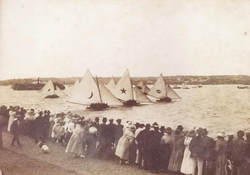
The start of the Australian 18-Footers Championship 22 January 1921 from Clark Island. Technically it was called the Mark Foy Challenge Cup between 1911-12 and 1926-27, and the Championship was decided on one race. The fleet was limited to 8 boats, 4 from NSW and 2 each from Queensland and Western Australia. It was only the second post-War Championship as the previous season's Brisbane trip did not come off due to a shipping strike. Crowds lined the Island and other headlands and several crowded ferries followed the fleet.
The winner was Vision (Qld) steered, owned and built by Colin Clark nearest the camera with the crescent insignia. It was the first win for Queensland in the almost annual Championship since Britannia II won on home waters in 1916-17, also steered and owned by Colin Clark. Runner-up was Mascotte (NSW, W.C."Trappy"Duncan) furthest right with the rectangle with white cross (actually the red white and blue AUSN flag). Kismet*(NSW, W.J."Billy"Duncan*), obscured, was third. The other boats were Eileen (WA, Chris Garland) with the star insignia, Eurus (WA, Cyril Bellion), at far left with diamond insignia, L.F.H. (Qld, Lance Watts), obscured, H.C.Press (NSW, George Press*), obscured, and Britannia* (NSW, George Robinson*) second right in the distance with the Red Duster insignia. Of the 8 boats, 5 were built pre-War with only the winner Vision plus L.F.H and Britannia recently built. George Press had a new boat H.C.Press II* ready for the next season, which became a multiple Australian Champion under Chris Webb.
The race started in a light Nor-Easter which unusually stayed light. The local boats set second rigs expecting it to build to the common 15-20 knots but it did not, and Vision carrying her big rig won by 40 seconds, with 1m40sec to third. Britannia carried away her jib halyards early on and withdrew.
In 1930 Colin Clark built Tangalooma* off Vision's moulds with minor variations and she also became an Australian Champion (1931-32). The original and redrawn lines plan of Tangalooma is reproduced in The Open Boat book.
The photograph was sent in by Jim Cox of Rockhampton Queensland who was given the framed photo by Bill Bedser of Bulimba who sailed on 18-footers about that time. Jim also reports his father was a 16-footer sailor who was bailer boy for local legend Vic Lucas as a lad.
The winner was Vision (Qld) steered, owned and built by Colin Clark nearest the camera with the crescent insignia. It was the first win for Queensland in the almost annual Championship since Britannia II won on home waters in 1916-17, also steered and owned by Colin Clark. Runner-up was Mascotte (NSW, W.C."Trappy"Duncan) furthest right with the rectangle with white cross (actually the red white and blue AUSN flag). Kismet*(NSW, W.J."Billy"Duncan*), obscured, was third. The other boats were Eileen (WA, Chris Garland) with the star insignia, Eurus (WA, Cyril Bellion), at far left with diamond insignia, L.F.H. (Qld, Lance Watts), obscured, H.C.Press (NSW, George Press*), obscured, and Britannia* (NSW, George Robinson*) second right in the distance with the Red Duster insignia. Of the 8 boats, 5 were built pre-War with only the winner Vision plus L.F.H and Britannia recently built. George Press had a new boat H.C.Press II* ready for the next season, which became a multiple Australian Champion under Chris Webb.
The race started in a light Nor-Easter which unusually stayed light. The local boats set second rigs expecting it to build to the common 15-20 knots but it did not, and Vision carrying her big rig won by 40 seconds, with 1m40sec to third. Britannia carried away her jib halyards early on and withdrew.
In 1930 Colin Clark built Tangalooma* off Vision's moulds with minor variations and she also became an Australian Champion (1931-32). The original and redrawn lines plan of Tangalooma is reproduced in The Open Boat book.
The photograph was sent in by Jim Cox of Rockhampton Queensland who was given the framed photo by Bill Bedser of Bulimba who sailed on 18-footers about that time. Jim also reports his father was a 16-footer sailor who was bailer boy for local legend Vic Lucas as a lad.
A much-discussed incident in the Balmain Regatta of November 1897. Two of the scratch boats in the 22-footers' race, Wonga* steered by George Ellis* (circular insignia) and Effie* steered by Nick Johnson (black crescent) were at the back of the fleet on the first downwind run just past Goat Island when Effie in attempting to blanket Wonga got a little too close and ran their bumpkin over the spinnaker pole of Wonga (first image). The second shot from behind shows how close the boom and ringtail of Effie are over Wonga's crew. In the third shot it appears that several of Wonga's crew have "accidentally" sat on the lower spar of Effie's ringtail. Johnson has pulled Effie away hard to extricate himself but the drag on the ringtail heels them over beyond the point of no return. Wonga continued, to finish last in the race. I can find no record of a protest but I suspect there would have been some ill feeling. However it appears that Johnson put himself in a situation that was likely to end badly. These photos were printed in the Australian Motor Boating and Yachting magazine in November 1925 and also in Bruce Stannard's Bluewater Bushmen. If I find clearer copies I will update this post.
Two unidentified 18-footers heading up Harbour on a light Sou'Easterly with squares'ls and ringtails in the 1890's. I'm guessing 18's because they don't look big enough to be 22's, and they're too big with too many crew to be 14's. And I'm saying 1890's because although the postcard was sent in 1907, squares'ls had died out before the end of the 1890's. Wouldn't it be nice if the Harbour was this empty today. From a postcard donated to the AHSSA by Peter Howes. The circle is not the Sun or the Moon, it's a pinhole in the card.
This photo from Dick Notley's collection shows Kismet* with the Australian flag over to the left, and probably Life Saver in the centre. Launched as Golding in 1910, she became Life Saver in 1923. The spectator boat in the foreground is interesting. it has an engine but also a mast tabernacle and chainplates and a plumb stem and stern, and is batten-seam carvel-planked. I suggest it may be a retired 24-footer or 22-footer with its side decks removed, but it is possible it was a purpose-built motor launch.
Twenty-two-footer Esmerelda winning the Intercolonial Championship race in 1895 with Billy Read at the helm. Built in 1889 by James Hayes, Esmerelda showed occasional form but was superseded in the next few seasons by newer boats. The Intercolonial Championships ran from 1894 to 1899 alternately in Sydney and Brisbane, and involved not only the 22's which were the dominant class at the time, but also the up and coming eighteens, as well as in some years the fourteens and the ten-footers. After the Queenslanders were resoundingly beaten in 1899, they lost heart, the series lapsed, and the 22-footers began to die out, being replaced by the 18's. Esmerelda was laid up in October 1901. Brisbane was to come back in the sixteen foot skiffs and then in the eighteen-footers with a vengeance in the 1920's and '30's.
Twenty-two footers Figtree*built by Robert Stephens in Pyrmont and Vigilant* built by Billy Golding in Balmain, both in 1896 for the 1897 Intercolonial 22-footers Championship from which it is probable this picture was taken.
A fleet of 24-footers dousing squares'ls off Farm Cove. They may be getting ready to gybe around Fort Denison, or perhaps this is just after the finish line in an Anniversary Regatta in the mid-1890's. The central boat is Volunteer*, built by Hubbards* in Glebe Point in 1889, and the one to the left is Lady Duff built by Donnelly* in 1893, who was at that time working in Woolloomooloo Bay, and was one of, or possibly the last racing 24 built. By 1889 the twenty-four footers had evolved the hull shapes and rigs that we would recognise in the eighteen-footers which began to appear about then. Intercolonial competition in the twenty-two foot class in the 1890's led to the demise of the twenty-four footers as the dominant class, and by the late 1890's they were mostly only appearing in races for boats with limited sails and crews. This picture may be one of the last images of the 24's with unrestricted sails and crews.
This example of a framed presentation is from the collection of the Sydney Flying Squadron and can be seen in their entrance hall. It shows the North Sydney Dingey Club's fleet of six foot dingies (some of them twice). The North Sydney Dingey Club held its first race in November 1899 for the newly invented six footers and ran well for a few years, faded a bit in 1905 but was revived in 1909. Surviving the sale of 6 boats (half its fleet) to the Solomon Islands in 1911 by building new boats, they also began to hold races for ten footers. The last six footer handicap mentioned was in February 1914, and the last ten footer handicap was in November 1914. They were young men's boats and unfortunately most of the young men were engaged elsewhere for the next few years. More in the Six-footers section.
Twenty-two footers Wonga* (1896) and Vuna racing downwind. Vuna, owned by AC Roberts who later became the NSW Solicitor-General and had Charlie Dunn build him the 18-footer Desdemona* in 1912 which he sailed until the early 1930's, is carrying a squares'l, Wonga is carrying a new-fangled spinnaker with a short yard at the head. This is before 1900 as Wonga was renamed Kelpie in that year.
Two of the greatest 22-footers racing with yard-headed spinnakers. Keriki* was built by Sam Williams* of Pyrmont in 1898 for Lan Taylor* who sailed it up until 1913 by which time all the other 22's had stopped racing. Effie* was built by Joe Donnelly* of Glebe in 1896 and was the Intercolonial Champion in 1898 and 1899 and considered by many to be the best 22 footer ever. I can't find a record of her racing after 1910.
This shot of a fleet of six-footers is believed to be from the 1913-14 season or just before that, as it is from the North Sydney Dingey Club presentation frame pictured above. The Balmain Dingy Club and the North Sydney Dingy Club catered for these boats. The only one I can identify is Livonia in the middle, from the name on the tuck. Livonia is first mentioned in 1911 in a North Sydney Dingy Club race steered by A.Appleton. The group of six-footer photographs in the Six-Footer page on the Menu (look under More on the Menu bar) mostly came from a collection given to the AHSSA by the late Alf Appleton Junior one of the Association's early members. A.Appleton Snr had sold Livonia by the time this photograph was taken and sailed another named Rene. He was famous for being the only finisher in a hard blow in a Balmain DSC race in January 1919 when all of the other ten starters capsized. Rene's bumpkin snapped in the middle, and Appleton re-lashed the jib to the stub and finished the race.
The leading boat is Waratah, steered by W. Keddie who won the race (and the Championship..only one heat in those days). The others are hard to identify as there is a paucity of records of the sail insignias for the ten footers. The boat with the dark triangle with a white ball is probably Planet. Commonwealth represented Queensland, and Britannia (probably the boat on the far right) represented Western Australia. Neither was placed. See more in the page on Ten Footers (in the More section on the Menu above).
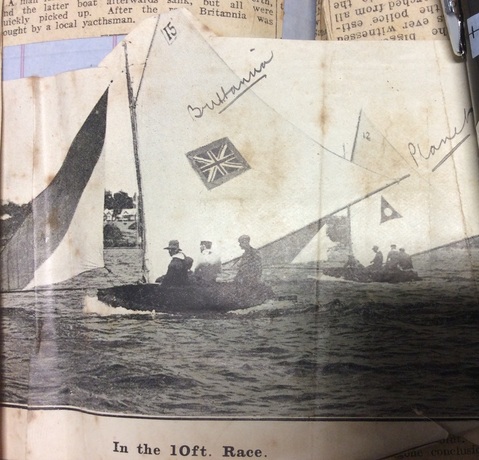
This crap photo shows Britannia and Planet possibly in the same race. Britannia was built in NSW in or before 1900 and spent most of its time racing in Newcastle where there was a fair fleet of ten footers in the first decade of the 20th Century. She travelled to Perth to represent NSW in 1911, was sold there and came back to Sydney to represent W.A. in 1912. She raced again in Newcastle later that same season and may have been sold back to NSW. Planet had a long career. Built probably by Charlie Dunn for Tom Cuneo in 1895, she was still racing in 1929.
When I first posted this photo I assumed wrongly that it was of the Balmain Dingy Sailing Club. In fact it is of the Brisbane Dingy Sailing Club, which was formed in the late 1890's and raced fleets of ten footers similar to the Sydney tens, and other dinghies of 12, 14 and 16 feet. The club broke up during the First World War. This photo appears to be mostly of ten footers, but perhaps there are some larger boats there.
A fleet of 18 footers in 1900, Stella(II) by Golding, Ira by W.Holmes, Australian by Sam Williams, Kyeewa by Edgar Dearing, Thalia by Golding and Donnelly by Donnelly. Just a couple of years after this the eighteens were the dominant class of Open Boat on the Harbour.
Kismet (Aus flag) and Hero (crescent) are approaching the Shark Island gybe mark in an 18 footers race about 1912-1914. The distant boat to the right is just striking her ringtail in preparation for the gybe, and Hero has lost the wind in her ringtail so is probably doing the same. Kismet has either already stowed hers or perhaps did not carry one on this run. You can see ringtails set on the replica fleet every Summer Saturday.
This programme photo is from 1924. Avalon was built by Charlie Dunn in Berry's Bay in 1922 for the King brothers and raced into the Second World War years. Mississippi was built as Admiral by Fred "Podge" Newton in 1913, became Mississippi in 1914, and after a long racing career survived as a launch into the 1980's but was unfortunately cut up without being measured. Furious was built by Tom Phillips in Balmain for Bob Gourlay in 1924 with a relatively narrow beam for the time of 7'3" and had no heel, being one of the experimental skiff-type boats that appeared occasionally during the big-beam era culminating in the huge changes that took place after the arrival of Aberdare in 1932.
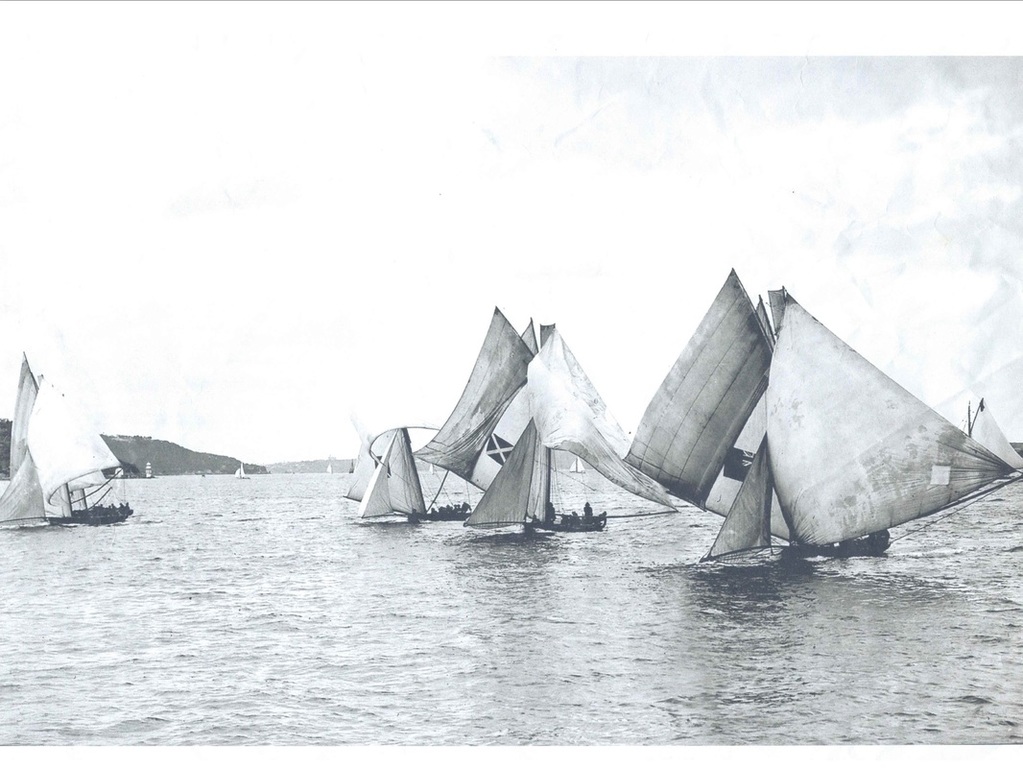
This photo turned up on a garbage tip in Canada. The original Britannia is on the right, the next left is Mascotte, then I think Mississippi. Sometime in the early 1920's they are nearing the finish North of Clark Island, and won't it be a close one!
A great shot, if this was the final run it must have been a close finish, no info found yet on what day it was, must be early 1920's. Note the spinnakers set from the tops'l yards, and ringtails on two of the boats.
This is the third Australian, built by Golding in 1912. Kismet was also built in 1912, by Charlie and Billy Dunn. Both boats were still competitive in 1925. Kismet raced until 1940, and was owned by Dave Ravell, one of the men on the SFS Honour Roll from the First World War and features in the excellent book by Adrienne Jackson, Steve Scully and Veronica Scully Setting Sail for the Great War, available through the Sydney Flying Squadron.
These are 16 ft skiffs with their distinctive high-peaked gaffs. The rigs were restricted and so were almost identical, with little change from a little after 1901 when the class was established until the early 1950's. The hulls however had just stopped being built with a heel in the early 1920's, and both hulls and rigs here would not have been out of place for the next 25 years. Full details in the Open Boat book.
Arline and Australian about 1910-12.
Swastika leads from Kismet and Sydney. Star symbol is on Caledonia, the first 18 to try a skiff-type rig. Early 1920's.
Enid leads Advance and Moyana, says the pencil on the back of the postcard, 1914.
Mavis at right, then Desdemona and Enid, 1912-14. Looks like a second-rig day. New horizontal-cut main on Mavis was uncommon in 18's at the time.
Sydney (red anchor) leads the start of the SFS Championship race in 1923 from Lifesaver (ex-Golding 1910). Mavis is closest to the camera. Britannia (Red Duster) who eventually finished second is beyond Mavis. One of the boats with a diamond symbol is Arline, the eventual winner.
The start of the Mark Foy Challenge Cup race, Saturday 18 January 1913, the de facto Australian 18' Championship. Westana (W.A.) who finished second leads Kismet (NSW) the eventual winner. Pastime (NSW) displays the horseshoe, Colonial (Qld) far left. All eight entries are in the shot. Only four boats finished in a freshening Nor'Easter, the other four all suffering gear damage including a snapped mast (Vanity, Qld). The hull lines of Norman Wright Snr-built Vanity are reproduced in The Open Boat book.
Left to right, Advance, Nimrod and Sydney, 1914 or just after. Close finish coming up!

This photograph would have been take in the late 1890's and shows a race between some of the twenty-two footers that were the dominant class then.. The contrast between the old and the new downwind extras is striking, the Donnelly-built Effie* (Crescent insignia) and Vigilant* further back holding on to the old Squares'l with raffee above, and the unidentified leader setting a jib-headed spinnaker which was the latest thing. There are other photos of an intermediate type that some boats carried, a spinnaker with a short curved spar at the head. Notice both the raffee and the spinnaker are hauled to the peak of the tops'l jackyard well higher than the mast. The halyard was taken aft and belayed at the tuck.
Most of the above programmes and postcards were collected by the late Graeme (Fergie) Ferguson who is greatly missed.



